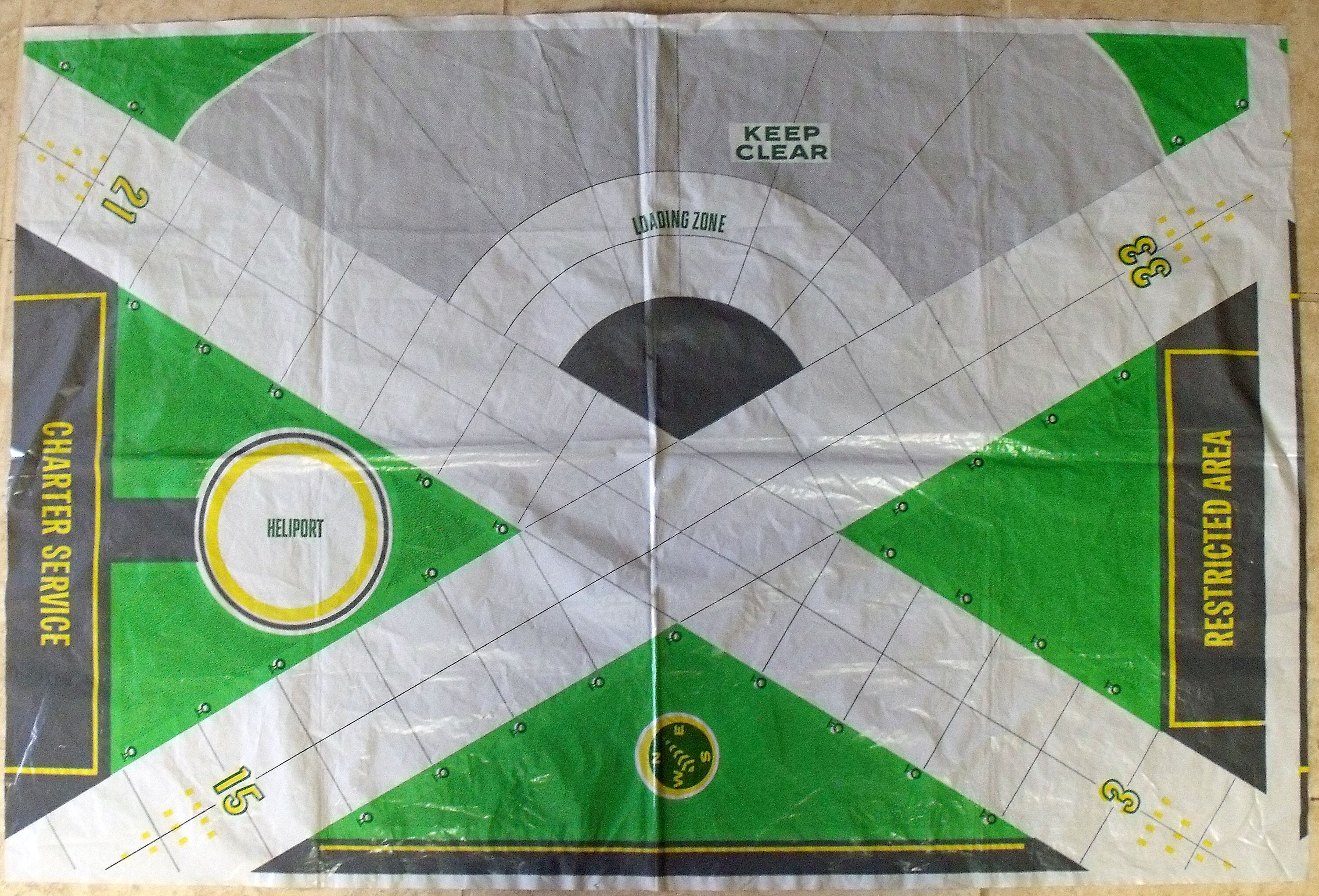|
An Inventory of Marx Playset Figures, Structures and Accessories Manufactured from 1951 to 1979
Appendix R-2 - Airport Playsets
|
Contents of this web site may not be reproduced or duplicated for use on the Internet or for commercial purposes without permission by Eric Johns.
 Table of Contents Airport Playsets (click on name to move to section) |
| Buildings |
| Airplanes |
| Figures |
| Small accessories |
| Ground vehicles |
| Bomarc missile |
| Playmats |
| Transportation Table of Contents |
| Main Table of Contents |
To start this section with a pun, Marx airport playsets barely got off the ground (sorry).
According to Plastic Figure and Playset Collector (PFPC) magazine, Issue 52, the first three versions of Marx airport playsets arrived on the market just in time for Christmas 1960. The 1960 sets were labeled American Airlines International Jetport and included foot-long Lockheed Electra propeller-driven aircraft and Boeing 707 jet planes. Decal sheets -- which seem to have been in each airport set -- featured the AA logo, which also was displayed on the airport terminal. The magazine article states that American Airlines paid a royalty to Marx on each set sold; this company link remained in the company's airport playsets though 1961 or 1962.
Contents were different for each of the dozen or so versions, but were generally a variation of the same items, with a few new or revised items introduced in 1961 and 1962. For example, in 1961, 990 Coronado astrojets were added to the sets, following the purchase of these aircraft by American Airlines. To match the new plane, playsets were re-named American Airlines Astrojet Airports. For Christmas 1962, the Ward catalog added the International Jetport, and a separate office building was added to the terminal, which lacked the American Airlines logo. Sears sold the largest airport set in late 1963, the International Jetport Set (#4224). And with that, the era of Marx airport playsets was over.
PFPC says the airport sets were "highly popular," but their history does not support this. I'm not sure how well they sold when they first came out, but by 1962 Marx was reducing the size of the sets, including fewer large passenger planes, omitting terminal walkways, and cutting out such niceties as a flying helicopter and a friction-powered airplane. By the end of 1963, sales lagged so much that production stopped after one huge last gasp with the Sears' International Jetport.
Perhaps I am just not an aircraft fan, but I will still say that I am underwhelmed by the Marx aircraft sets. Having purchased a set recently, I find the set less colorful than the top-notch Marx sets. Most planes are undersized, visually blah, and of poorer quality than items normally found in Marx sets; and the tiny figures seem too ordinary, mostly copied from existing playsets. I don't think the sets ever reached their potential. Some nice small accessories exist, but with the terminal fully enclosed on all sides, where are the ticket counters, the waiting rooms, the baggage claim areas? The 1-year Sears Store did much better along those lines. With none of that and so few passenger figures, the sets seem to miss Marx' goal, stated by PFPC as "designed to portray a bustling American Airlines aairport."
Perhaps this disappointment is due at least partially to Marx' attempt to create a playset around items that are way too big (i.e., passenger airplanes) to be reproduced in actual scale in a reasonably-priced toy playset. Moreover, as several short-lived Marx playsets, the sets lack that one vital quality needed for any good playset: good guys versus bad guys. I suppose in today's world you could always pretend that a deranged pilot takes control of the rocket-firing jet plane included in most airport sets (no, I don't know why it was included in this generally peaceful set) and attacks the airport...but I find that just too depressing.
Or maybe I just need to see a dead mint set with the original deep red, powder blue, and silver accessories, assembled in all its glory....
Meanwhile, the truth of the matter is -- at least according to my sometimes inane logic -- Marx might have made a much better go with airport playsets if they had started making them a few years later and, perhaps, had not gone into cahoots with American Airlines. The Lockheed Electra and Boeing 707 were the primary aircraft in the early sets. Based on my brief research, both had been introduced to the public in 1950s and both spent time as the flagships of American Airlines. But they were also both used by many other airlines, leaving Marx an open door to create sets for those other airlines, or one including planes from several airlines. In 1961, however, American Airlines began its brief shift to the General Dynamics (not Boeing as noted in PFPC) Corvair 990 Coronado. Remember that molds for all of these aircraft were large and certainly not cheap.
Unfortunately, production of the 990 astrojet was even shorter than production of Marx airport playsets, lasting only from 1961 to 1963. Due to problems with the plane, General Dynamics made only 37 of them, and by 1967 American Airlines was already disposing of the ones it had. Meanwhile, other airlines stuck with Boeing and its 700 series, with 727's first sold in 1964 and 737's in 1968. If Marx had molds ready for those aircraft and created decals for other airlines, I bet the company could have produced airport sets for many more years. The possibilities are limitless! Such is the glory of the Monday morning quarterback!
PFPC Issue 52 includes a wealth of information about Marx airport sets. Unfortunately, that issue is from 1997, and I am sure a good deal of additional information on the sets has been learned since 1997. Playset Magazine has not yet published an article on these sets. I'd welcome any additions or corrections to this web page, as well as photos to fill any of the empty picture frames.
| Buildings |
Terminal Buildings
There were three versions of airport terminals. The first and second versions used the same metal stamping as the Alamo building, with the opening cut into one of the two longer sides. That opening was first added for the Fort Apache Cavalry buildings and later used in the Zorro playset. It is about 12 inches wide, 4 inches deep and 5 inches tall. As with many playset structures, it is significantly smaller scale than the 35mm figures used in the airport sets.
However, the terminals are colorfully lithographed, topped with a neat plastic control tower and a curved awning on the front side. Note that -- as pointed out by PFPC -- there is some question as to which is the front and which is the back of the terminal. I will refer to the side with the attached plastic awning as the front, and the side with the opening as the back.
Despite the opening in the backside, the building has no inside lithography. It is an impressive piece, especially when the control tower and two side walkway ramps are added, making the entire setup about 26 inches wide and 10-1/2 inches tall. The walkways are discussed later in this section, and the control tower is covered in the Small Accessories section.
| Photos below of first terminal courtesy of collector Brad Farrell |
 |
| First terminal front |
 |
| First terminal back |
 |
| First terminal front with attachments |
| Photos above of first terminal courtesy of collector Brad Farrell |
The second version terminal -- which came out with the astrojet sets in late 1961 -- was similar to the first version, but lithography was revised somewhat to add an expanding ramp for passengers to board and disembark from aircraft. This third ramp attaches to slots in the backside of the building so that passengers may go directly from the terminal into the aircraft. The ramp is discussed later in this section.
This second terminal is the one that is most commonly found in the market today.
PFPC raises one issue on the differences between the first and second terminals. The magazine states that the front of the first terminal most logically faces inward toward the set's playmat. However, with the new ramp now attached to the back of the terminal, PFPC states that the back side most logically faces the playmat. Therefore, the front side with the awning must now face away from playmat runways when the playset is set up for play. This appears to be true to me, but then perhaps the back side of the terminal -- with the cut-out opening for baggage -- should have faced the runways all the time. PFPC complains that this forces the front of the terminal to face away from the playmat, so that passengers arriving at the airport must travel on the floor instead of the playmat. Yes, well, you can't have it both ways, and it seems like a personal preference issue to me!
As you attempt to figure out what I am talking about, remember that the side walkways can be attached to face either way, curving toward the so-called front or the back of the building.
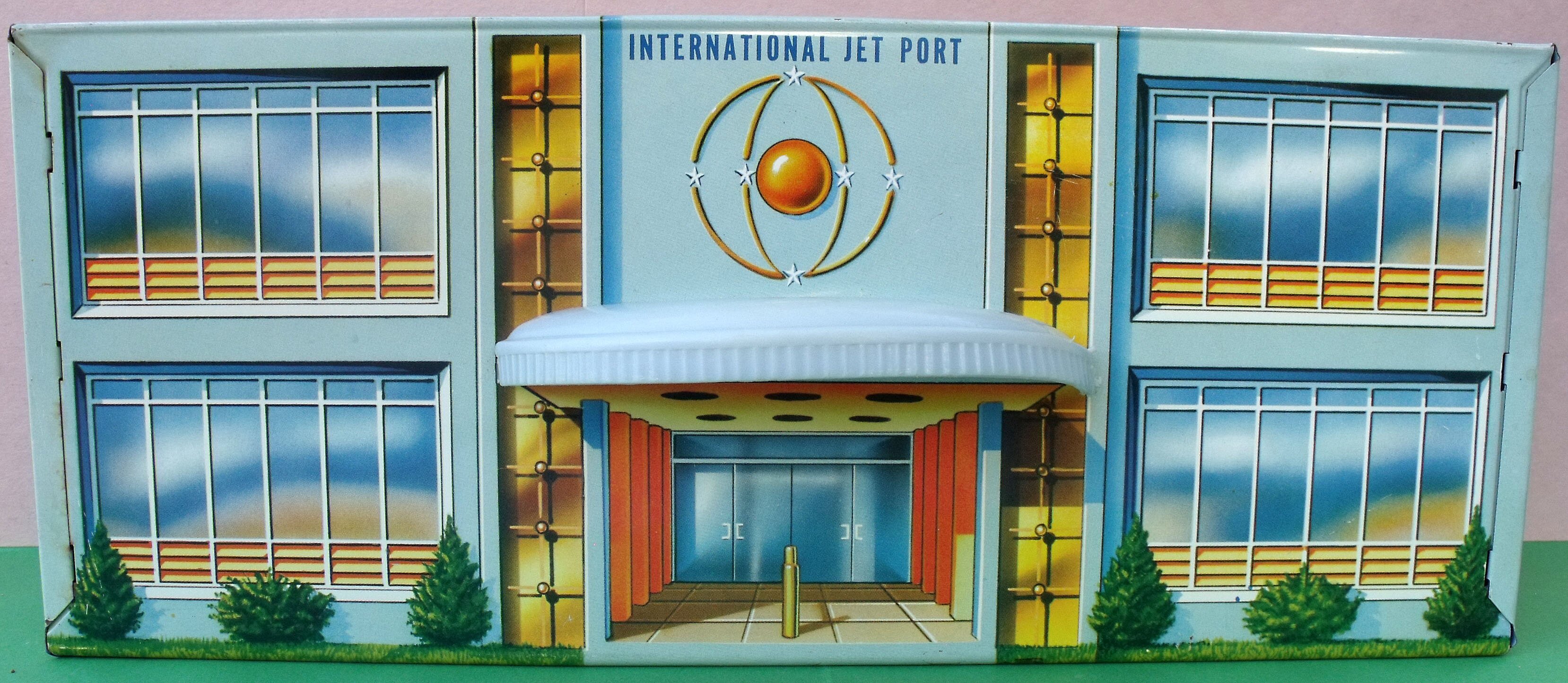 |
| Second terminal front, with awning |
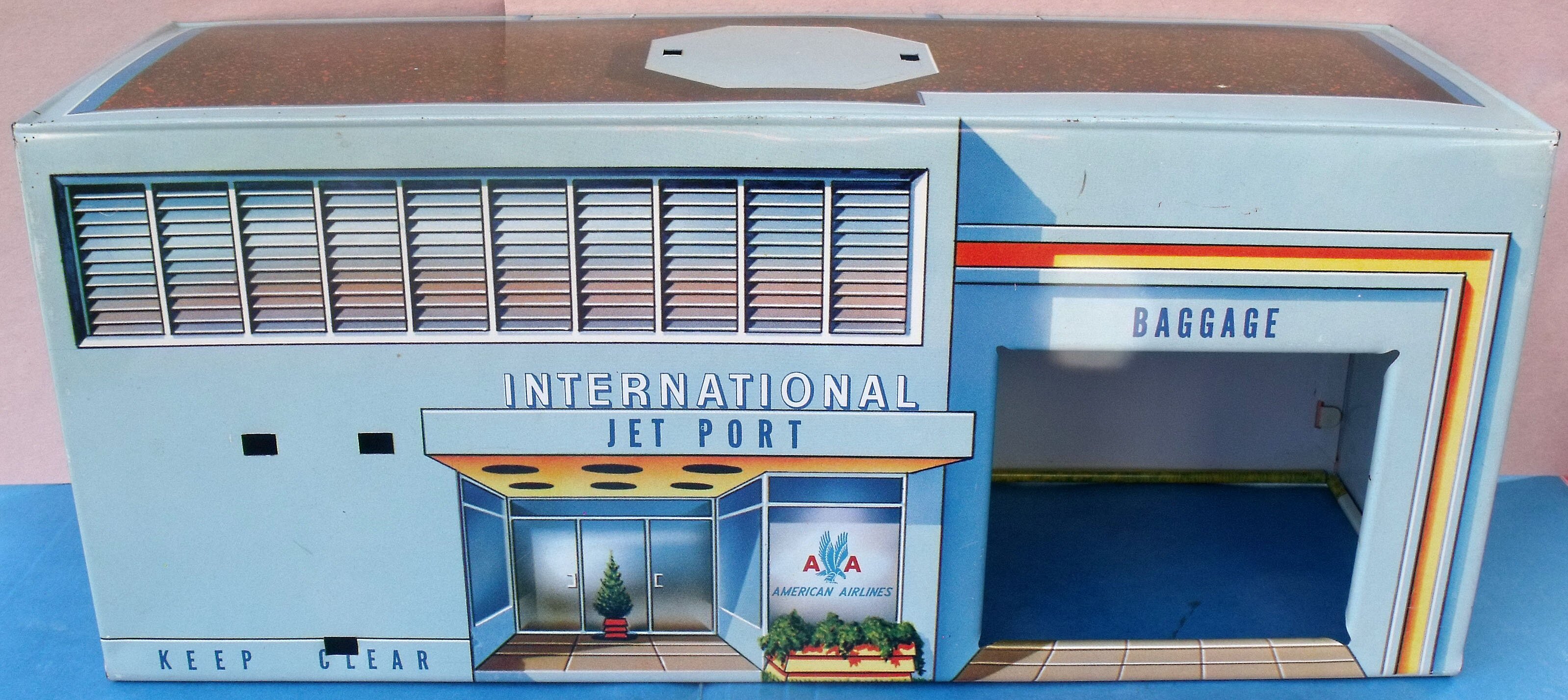 |
| Second terminal back |
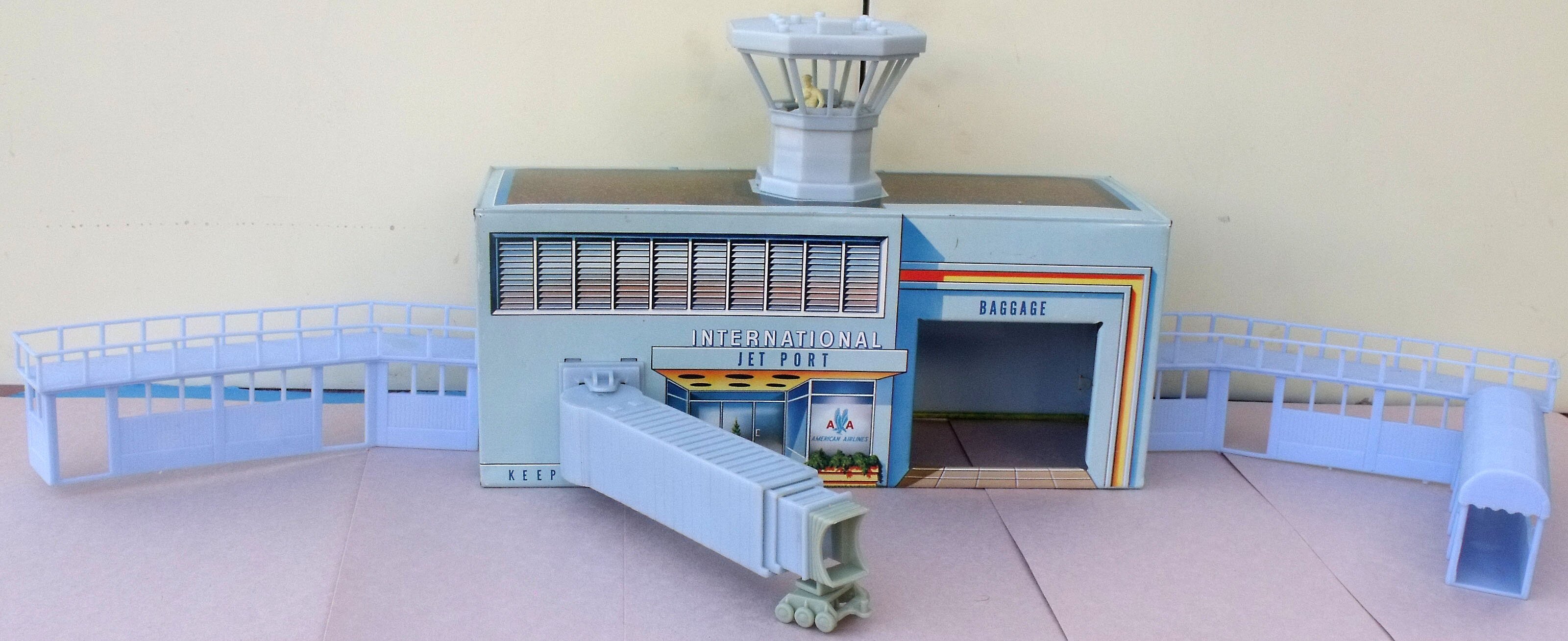 |
| Second terminal back - with attachments |
The third version terminal was one of Marx' finest structures, featuring a large hangar area and a separate attached office building. It came first in Montgomery Wards' 1962 International Airport Set (#4816) and was only included in playsets sold by Wards. According to PFPC, it used the same metal stamping as that for the Strategic Air Command set -- which was released just as airports were being phased out -- and measured about 26 inches wide, 14-1/2 inches deep, and 16 inches high. Finally, a hangar that could house one of the large passenger planes!
The added height was due to the fact that the plastic control tower was no longer placed directly on top of the building, but rather on a tin litho tower that was placed on the building top. The building had none of the walkway attachments that previous terminals included and no American Airline logo. It was lithographed in an attractive deep blue color; it is difficult to find today. Sadly, with its large hangar opening, it begs for interior lithography.
The building is depicted on the Marx instruction sheet below. This appears to be from Ward's 1962 International Airport Set that introduced the new terminal. Note that the walkways are gone and the passenger planes were two Electras and one 707. Though the set's 707 appears to be white on the instruction sheet, it was actually silver. The same set in 1963 had the terminal, but only one passenger plane, the 707.
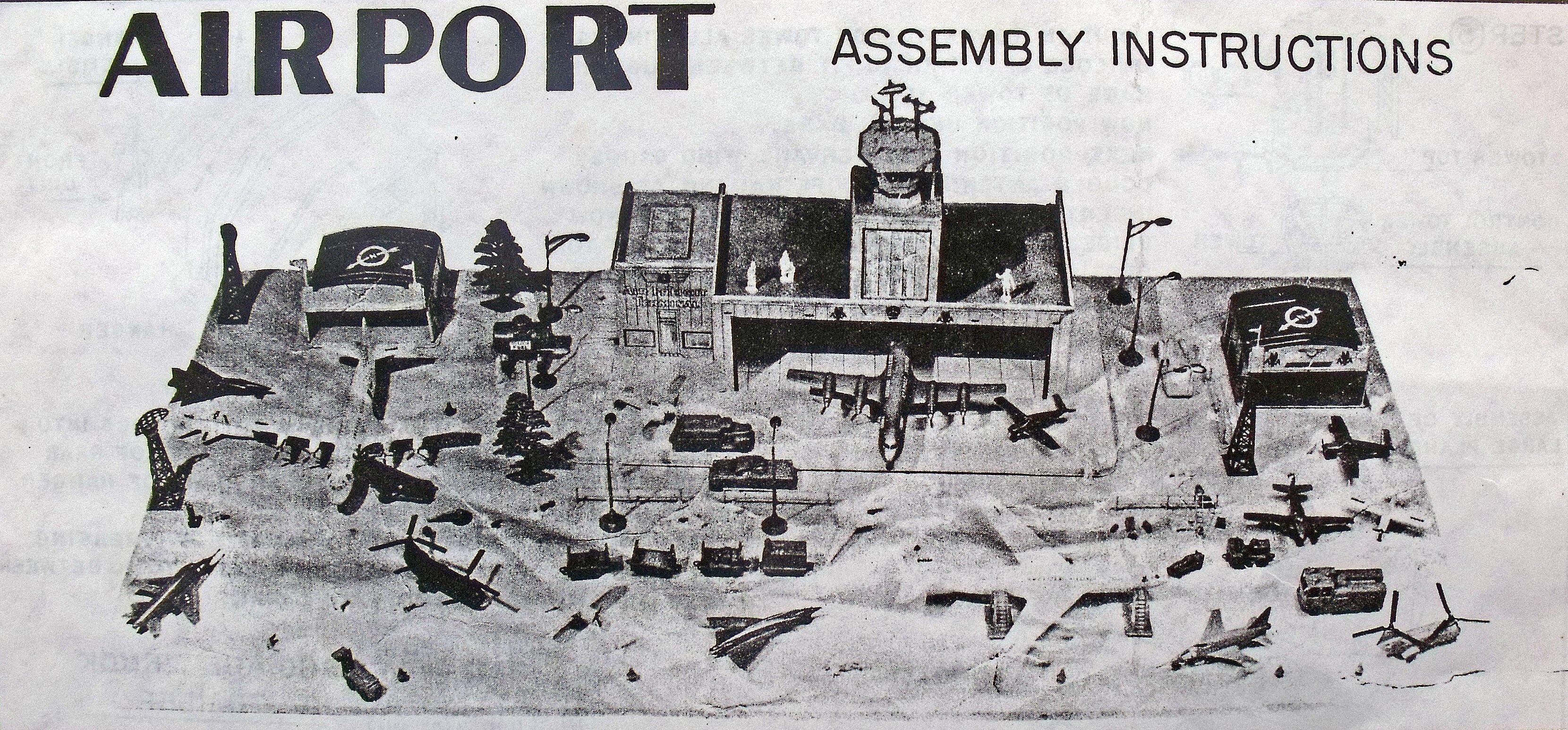 |
|
| Third terminal front |
|
| Third terminal back |
Passenger walkways
As shown above, the terminals were enhanced by three covered walkways, two leading from either side of the building and a smaller 2-piece walkway that can be placed to connect with any of the doorways in the other two walkways. PFPC states that the third walkway provides passengers protection when boarding or disembarking from an aircraft. On the other hand, I'd suppose that it could be placed so that its entrance is as close to the bus stop as possible, especially after the expanding walkway shown below was introduced later!
These were made in various blue shades, similar to the Blue Accessory Group noted later on this page. PFPC says that they were sometimes powder blue in 1960, but waxy blue thereafter. PFPC also notes that while the expanding ramp was also blue, its shade in a set did not always match the shade of the side walkways.
The side walkways -- which are slightly bent, giving them a curved look -- are about nine inches long and 2-3/4 inches tall. The smaller one is about 4-3/4 inches long and two inches tall. When properly attached to the terminal, the ends of each walkway are level with a second-floor door out of the terminal, theoretically allowing passengers to walk out on the top of these walkways and observe airplanes on the runways.
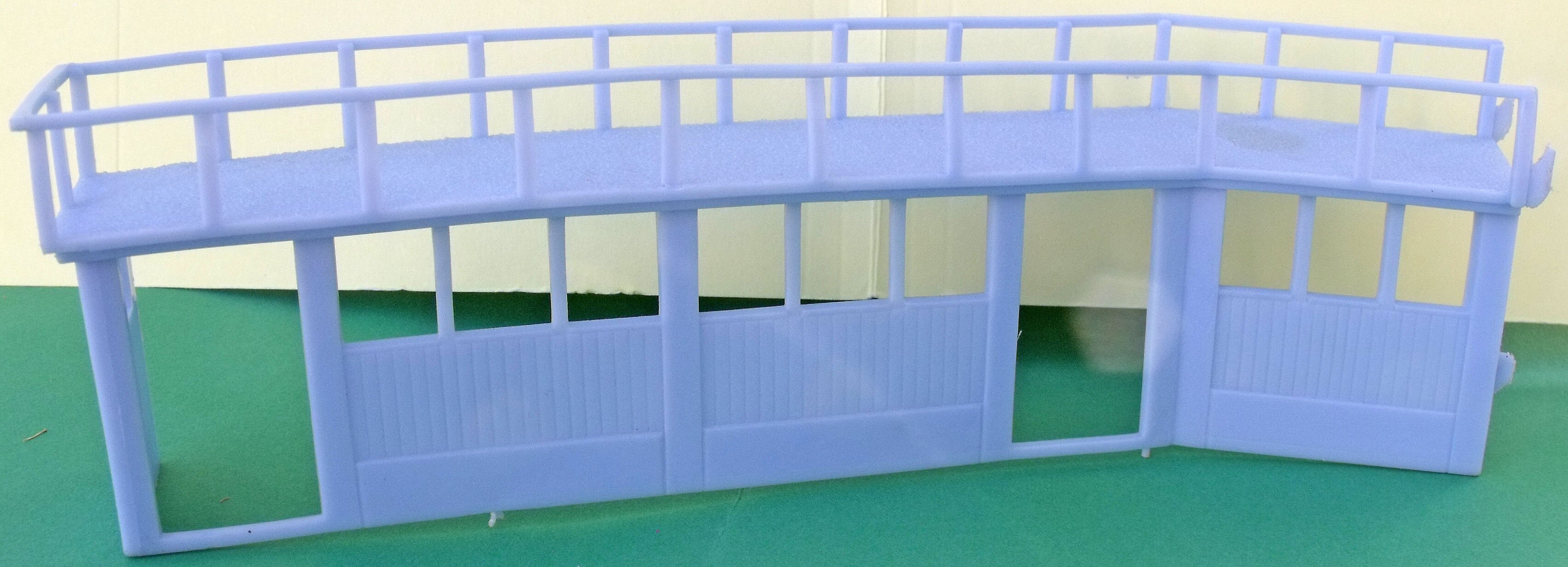 |
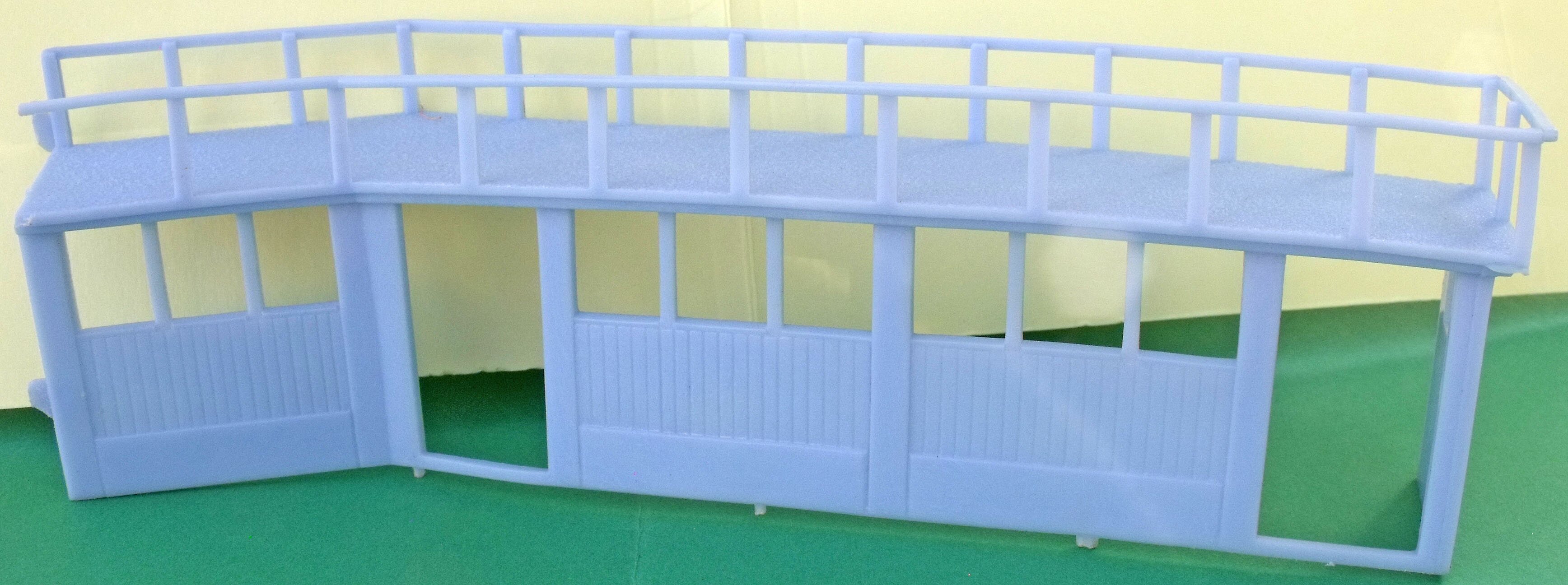 |
| Terminal side walkways | |
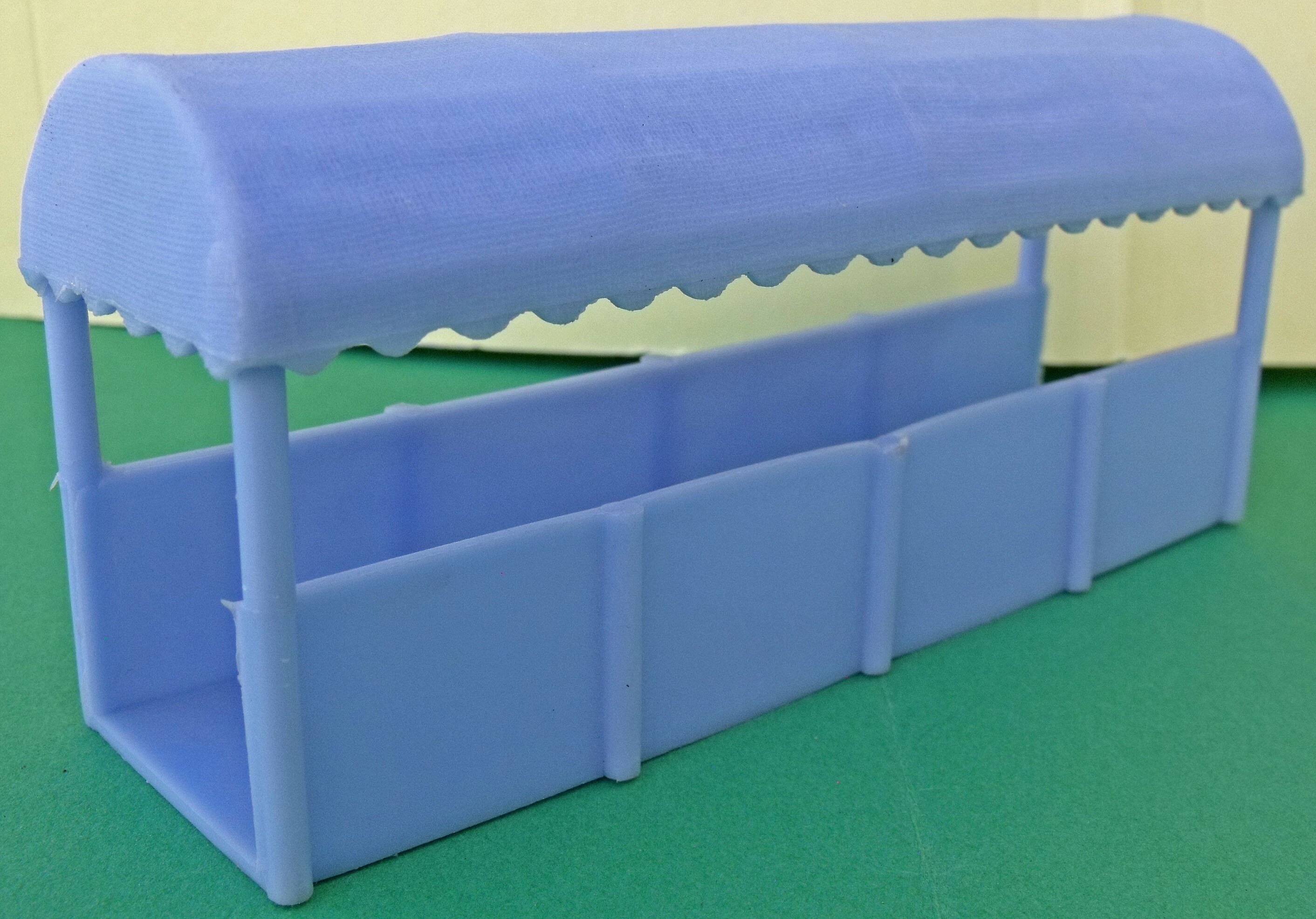 |
| 2-piece covered walkway |
In 1961 -- the second year of airport playset production -- Marx introduced its expandable walkway for arriving passengers. It attached to the second version terminal, beside the cutout on the back of the building. A blue tractor -- the same as the one used to pull luggage carts -- could pull it out to planes; its end near the plane is curved to fit the curve of the large planes' fuselages.
Made in light blue plastic with a gray end piece nearest the plane, it is about 10-1/2 inches when fully expanded. The piece that attaches the ramp to the building also allows the ramp to be moved side to side.
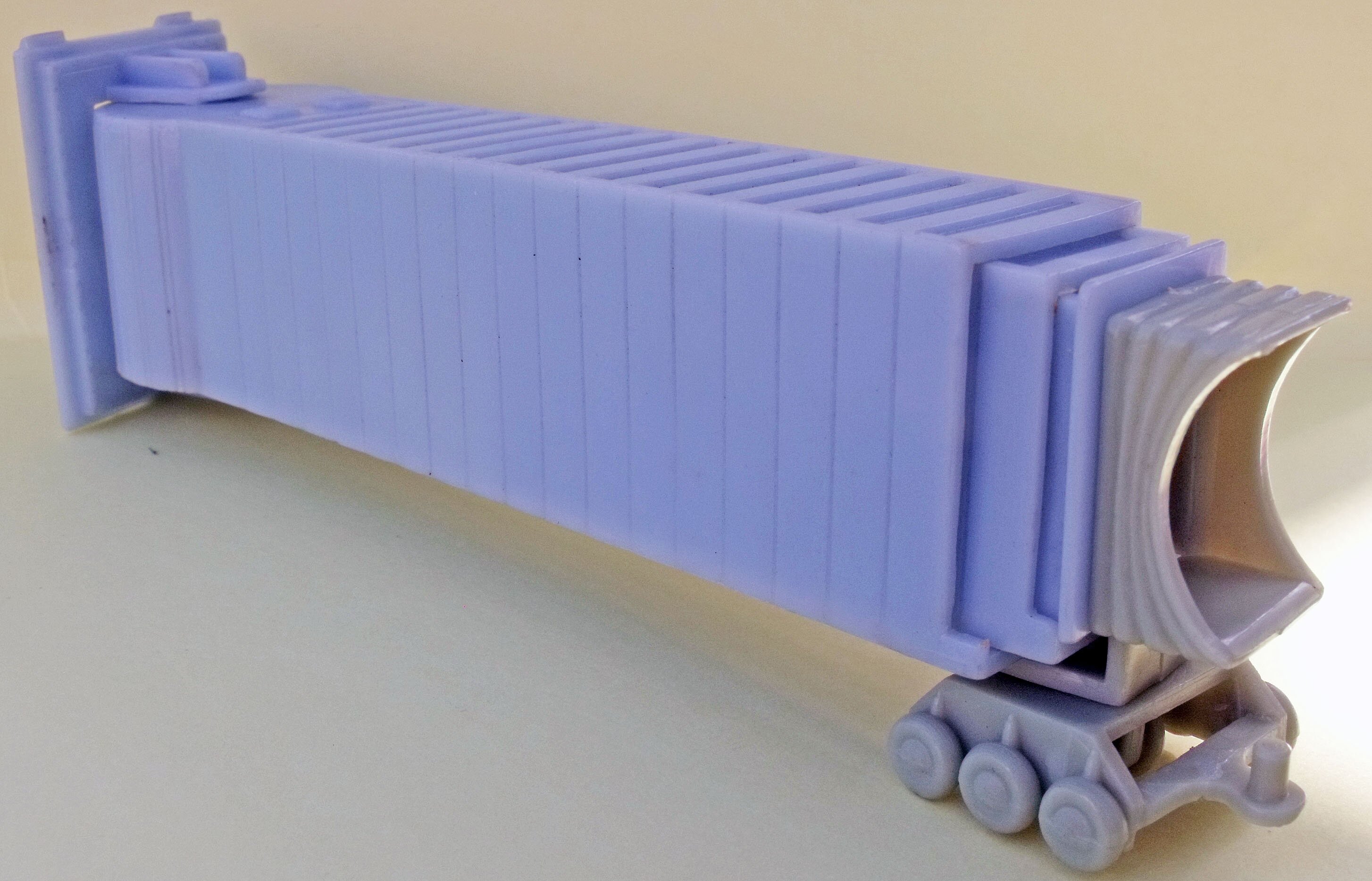 |
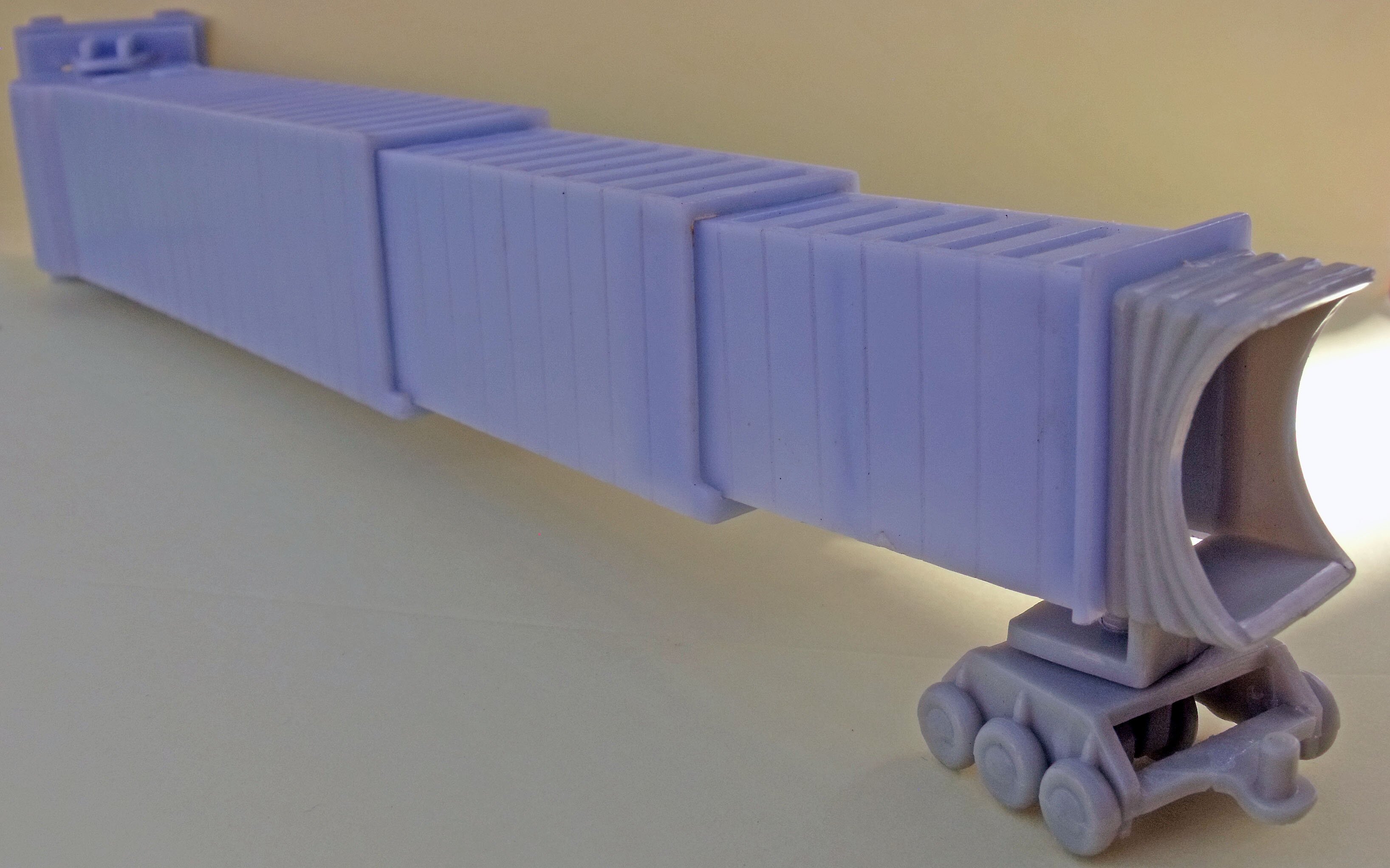 |
 |
| Expandable walkway for de-planing passengers | Tow tractor | |
Small Hangers
In addition to the terminal building, sets included small hangars to house the smaller airplanes. I say small, because there was no way that the sets' large passenger planes could possibly fit into these structures. Of course, due to the apparent size of this airport, it is doubtful that any large airline would want to leave their aircraft here overnight. Most of the smaller aircraft will fit into the hangars.
The hangar measures 6-3/4 inches wide, 5-3/4 inches deep, and 2-3/4 inches high, plus another two inches with the plastic front piece shown below. The hangar interior could use some nice litho detail, but no such luck.
The 3-sided, tin litho hangars were the same structures that Marx earlier used in crop duster sets for its farm playsets. As shown, the blue plastic roof fronts displayed decals for American Airlines identification.
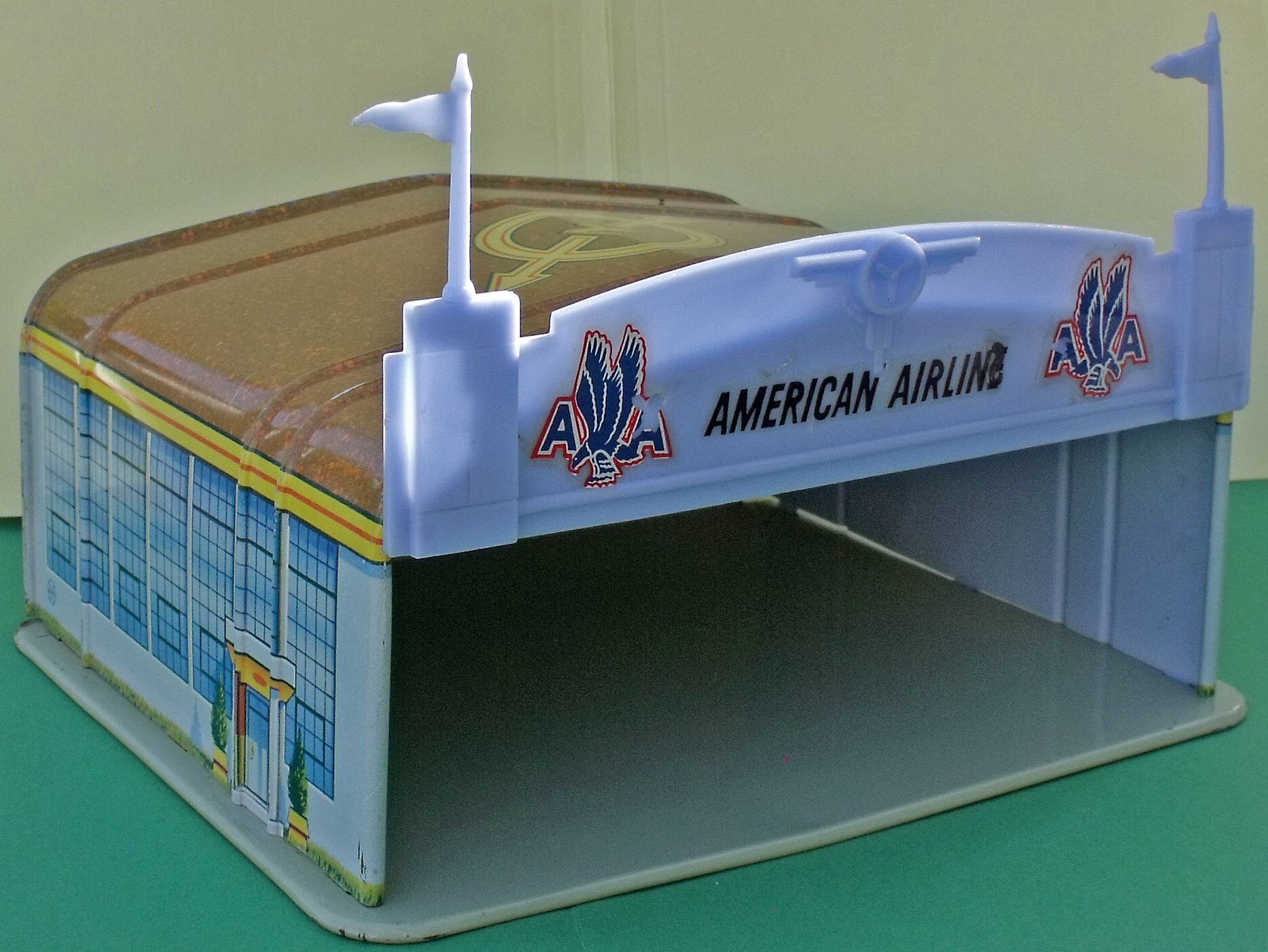 |
| Hangar Back side is enclosed |

| Airplanes |
Large passenger planes
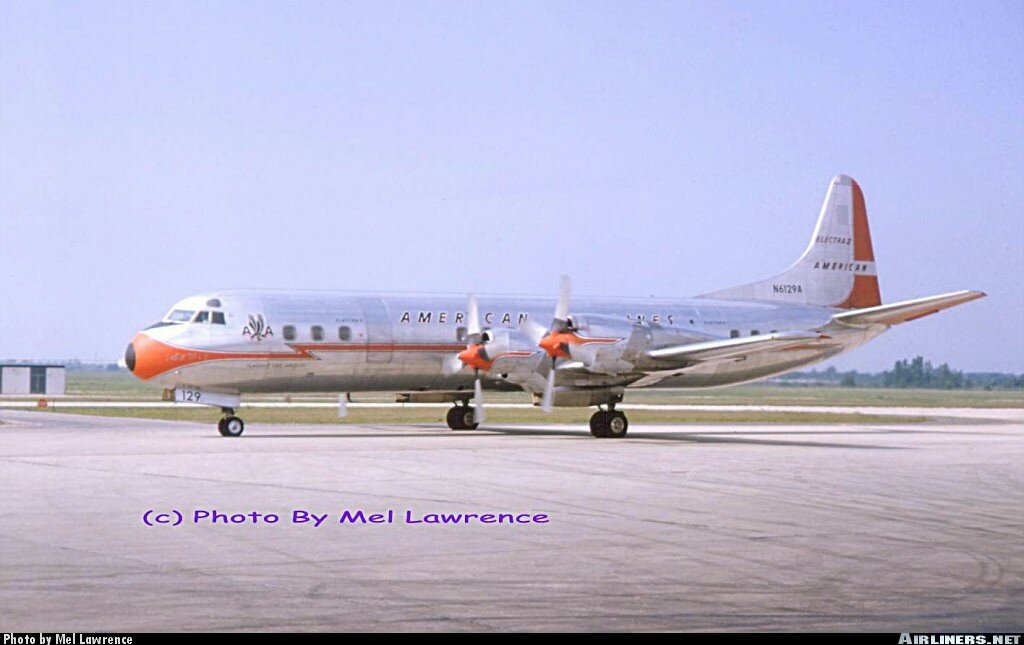 While the airport playsets included a nice variety of airplanes, the sets had only three types of large planes. These were the Lockheed L-188 Electra turboprop, the Boeing 707 jet, and the Corvair 990 Coronado astrojet. Marx selected these aircraft because its playset-partner American Airlines flew each of them. If airport playsets had stuck around longer, I'm sure we would have a greater variety of the large planes. Early sets included the Electra and 707; the 990 was added in late 1961 as American Airlines was adding it to the company's flying inventory.
While the airport playsets included a nice variety of airplanes, the sets had only three types of large planes. These were the Lockheed L-188 Electra turboprop, the Boeing 707 jet, and the Corvair 990 Coronado astrojet. Marx selected these aircraft because its playset-partner American Airlines flew each of them. If airport playsets had stuck around longer, I'm sure we would have a greater variety of the large planes. Early sets included the Electra and 707; the 990 was added in late 1961 as American Airlines was adding it to the company's flying inventory.For the most part, all three airplanes were made in silver hard plastic. They came in parts that had to be assembled: top of fuselage, bottom of fuselage, wheels, and -- for the Electra - propellers. A separate bag in playsets held wheels and properllors for aircraft, as well as ground vehicles. For some reason, a few of the Electra and 707 planes were made 1) with cut-out doors and 2) in white plastic. Despite using the small 35mm figures, all three planes were made in a smaller scale in order to keep the price of the playsets reasonable.
Sheets of decals could be used to decorate the large airplanes, as well as a few other accessories such as the hangars and fuel tank. At least two different sheets exist, changing when the 909 Coronado jet was added.
The Electra was the first large passenger turboprop plane built in the U.S. It was used by many U.S. airlines, starting in the mid-1950s, including American Airlines. The actual plane was about 105 feet long, so to be in scale with the set's 35mm figures, the Marx plane needed to be a little more than twice its 11-inch length.
 |
| Lockheed Electra About 11 inches long and 11 inches wide. Note that the decals applied to this one erroneously read "990 Astrojet." The owner obviously knew about as much about airplanes as I do! |
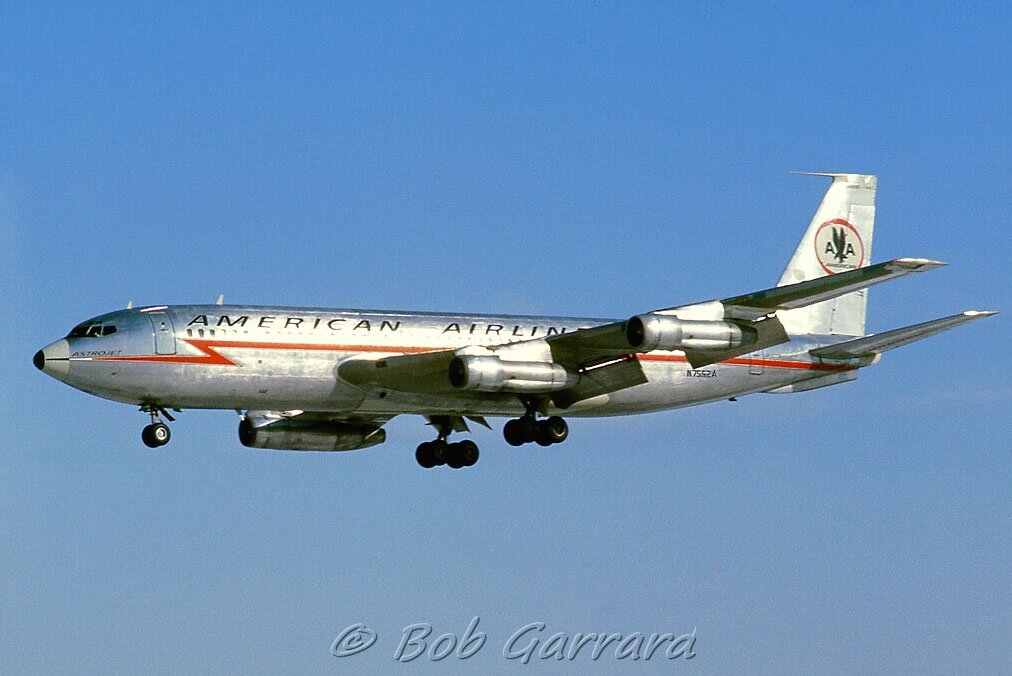 In the late 1950s, American Airlines adopted the Boeing 707 jet as its flagship. It was a major aircraft of air passenger travel in the 1960s and continued into the 1970s. Its actual length was about 150 feet; to make it in scale with the 35mm figures it needed to be almost three feet long, three times as long as the Marx plane.
In the late 1950s, American Airlines adopted the Boeing 707 jet as its flagship. It was a major aircraft of air passenger travel in the 1960s and continued into the 1970s. Its actual length was about 150 feet; to make it in scale with the 35mm figures it needed to be almost three feet long, three times as long as the Marx plane.Although the 909 Corondo astrojet replaced the 707 in Marx playsets in late 1961, the 707 was revived in the company's final airport set in 1963. That was the #4224, the largest airport set Marx made. Sold by Sears, it was the only set that included all three of the large aircraft. And it included two of each!
 |
| Boeing 707 Photo courtesy of collector Brad Farrell About 11-1/4 inches long |
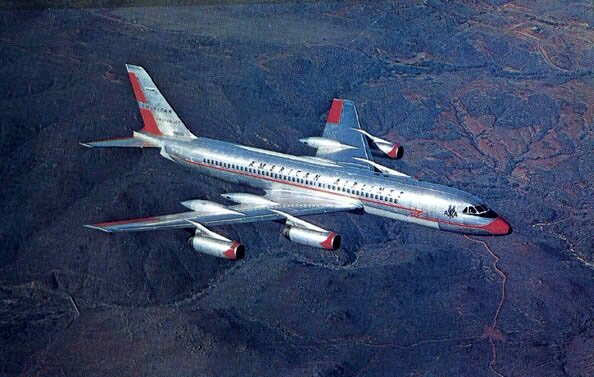 The Corvair 990 Coronado astrojet was made by General Dynamics. PFPC mistakenly attributes it to Boeing, but it was actually made by the Corvair Division of General Dynamics. As mentioned earlier, the plane was a short-lived experiment by American Airlines. It was a bad choice for American Airlines due to its earlier-mentioned problems, as well as for Marx, since no other U.S. airlines purchased 990s. By 1967, American Airlines was disposing of its 990 inventory.
The Corvair 990 Coronado astrojet was made by General Dynamics. PFPC mistakenly attributes it to Boeing, but it was actually made by the Corvair Division of General Dynamics. As mentioned earlier, the plane was a short-lived experiment by American Airlines. It was a bad choice for American Airlines due to its earlier-mentioned problems, as well as for Marx, since no other U.S. airlines purchased 990s. By 1967, American Airlines was disposing of its 990 inventory.Though actually slightly smaller than the 707, the Marx representation of the 909 is the largest of the three planes, just more than a foot long. It first appeared in Marx sets in late 1961, the same year that American Airlines began using it. With an actual length of 140 feet, it would need to be about two-feet-nine-inches to be in scale with the 35mm figures.
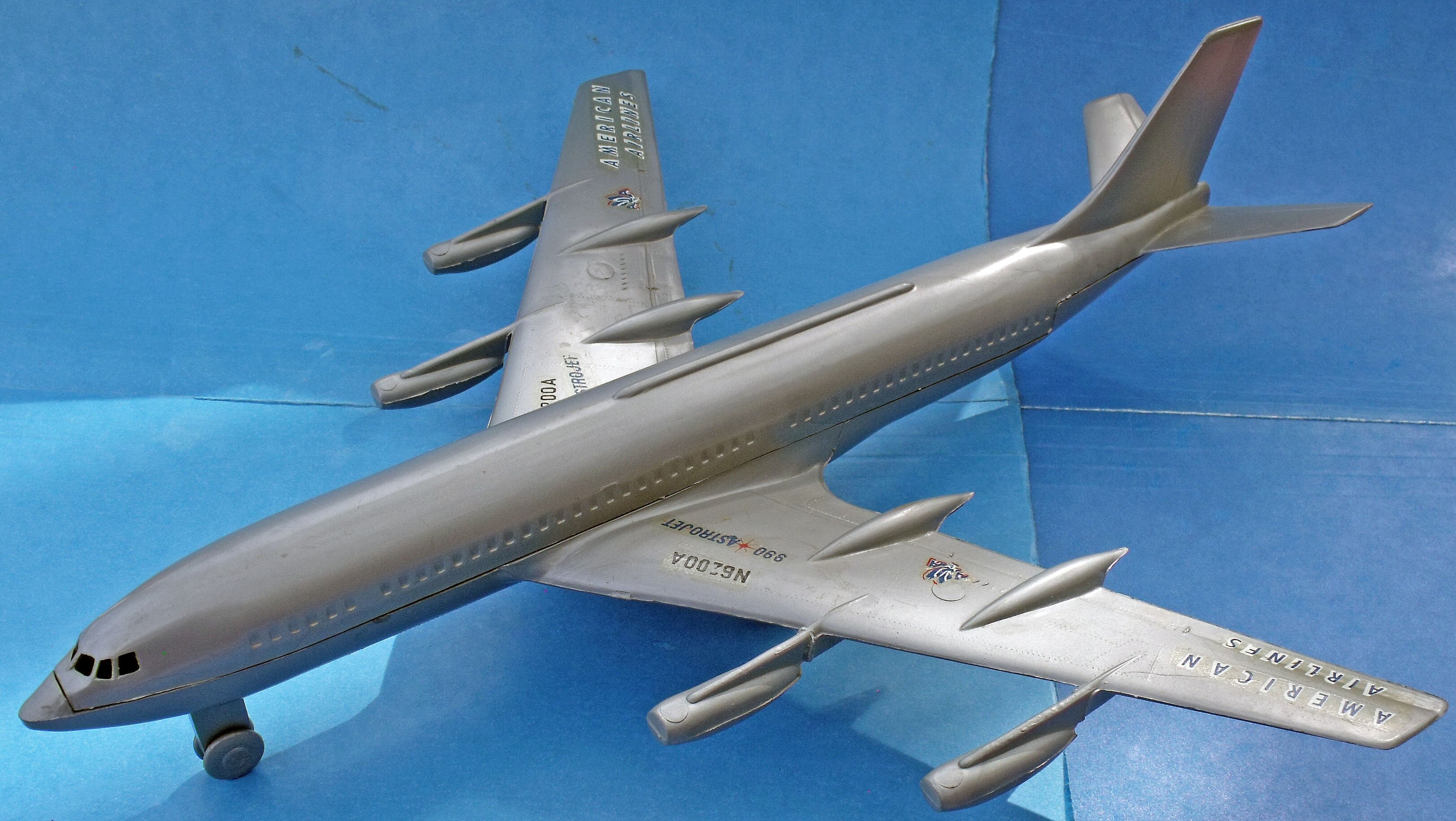 |
| 990 Astrojet About 12-1/4 inches long and 11 inches wide |
Small plastic planes
Other planes in the playsets were much smaller, and most resembled five-and-dime store bargain bin items more than Marx playset pieces. The were generally made in green, yellow, red, silver, and metallic blue soft plastic. They are more in scale with the 35mm figures, but still undersized.
This group is generally considered to have seven different aircraft, including the Vertrol 107 helicopter, which is shown below with the sets' flying helicopters.
The most interesting among these aircraft is the North American X-15 rocket-powered aircraft. Though Marx' version of the craft looks rather unimpressive, this experimental aircraft was
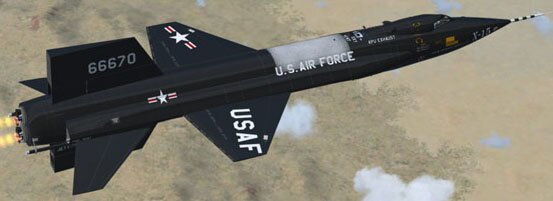 operated by the Air Force and NASA, setting both speed and altitude records in the 1960s. It reached the edge of space and still holds the speed record for a manned, powered aircraft as of 2015. The front of the plane was supported by a single, retractable wheel, while the back had two skids without wheels. The plane was designed to be carried aloft and drop-launched from the wing of a B-52. Its inclusion in a civilian airport set is odd, but perhaps adds a little excitement to it.
operated by the Air Force and NASA, setting both speed and altitude records in the 1960s. It reached the edge of space and still holds the speed record for a manned, powered aircraft as of 2015. The front of the plane was supported by a single, retractable wheel, while the back had two skids without wheels. The plane was designed to be carried aloft and drop-launched from the wing of a B-52. Its inclusion in a civilian airport set is odd, but perhaps adds a little excitement to it.The Convair F-102 Delta Dagger was designed as an interceptor aircraft, part of the Air Force's air defense in the 1950s. The Delta Dagger continued as part of the Air Force aircraft inventory until 1976, including service in Vietnam. Conversely, the North American F-107A was one of several entrants in the Air Force's tactical fighter-bomber design competition in the 1950s. The F-105 Thunderchief won out, and only three F-107A's were manufactured. Although Marx calls the F-107A a Thunderchief, that was never its name.
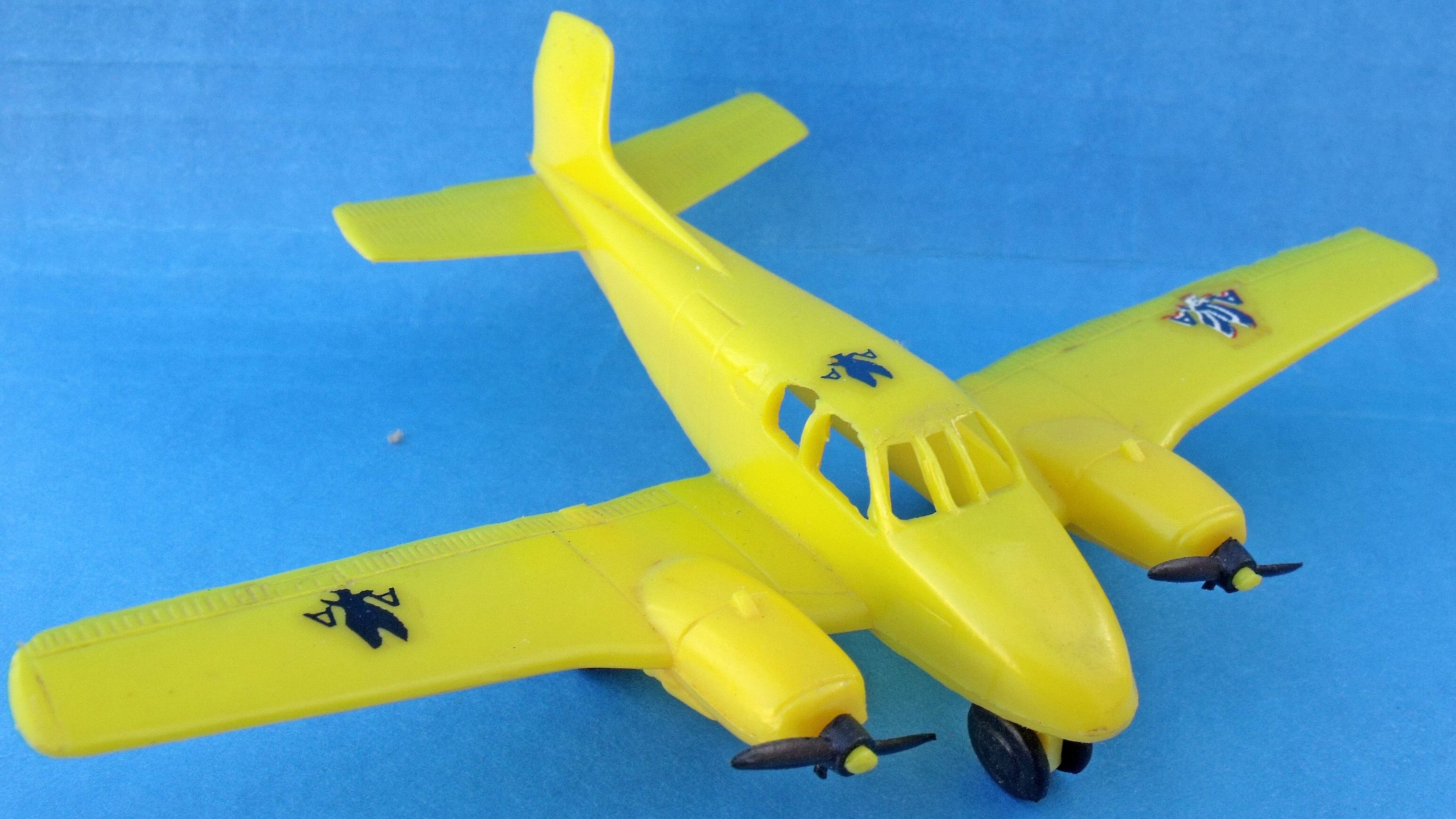 |
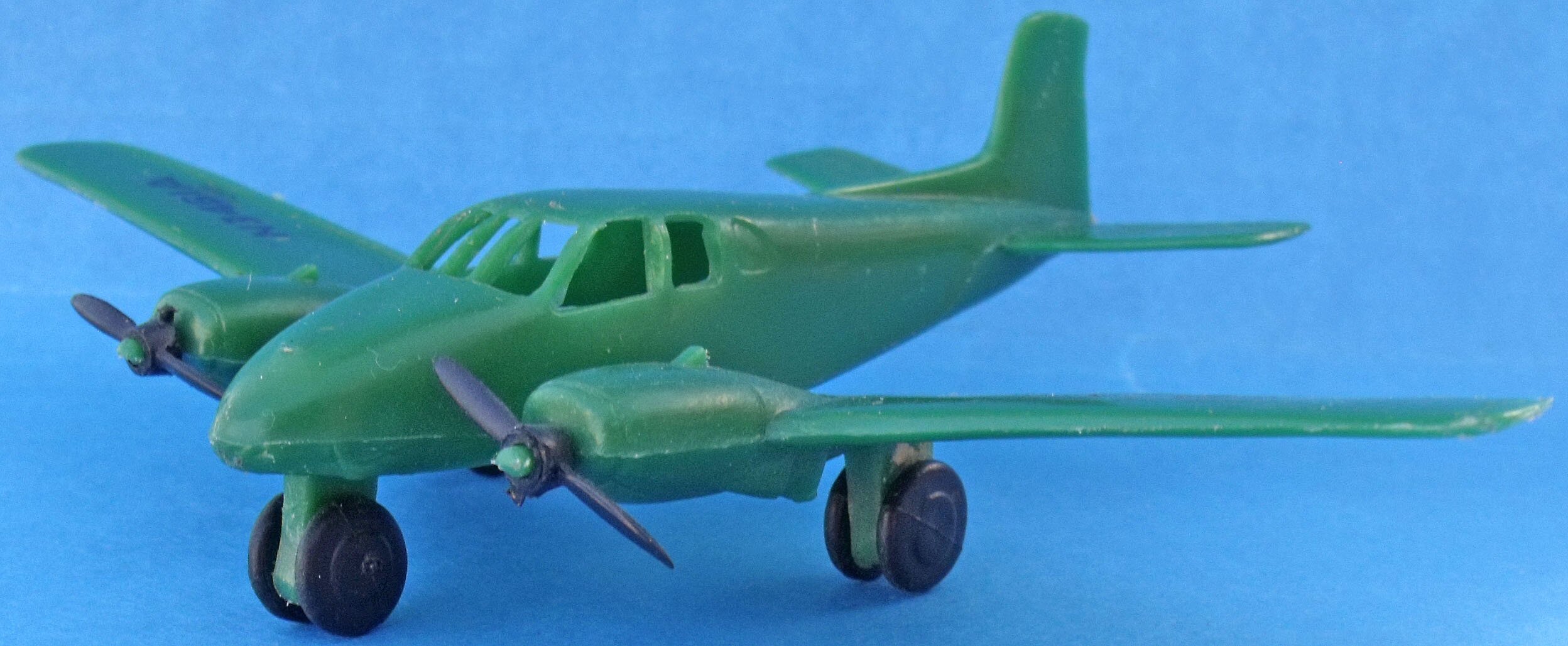 |
| Twin Beech aircraft - two views 3-3/4 inches long |
|
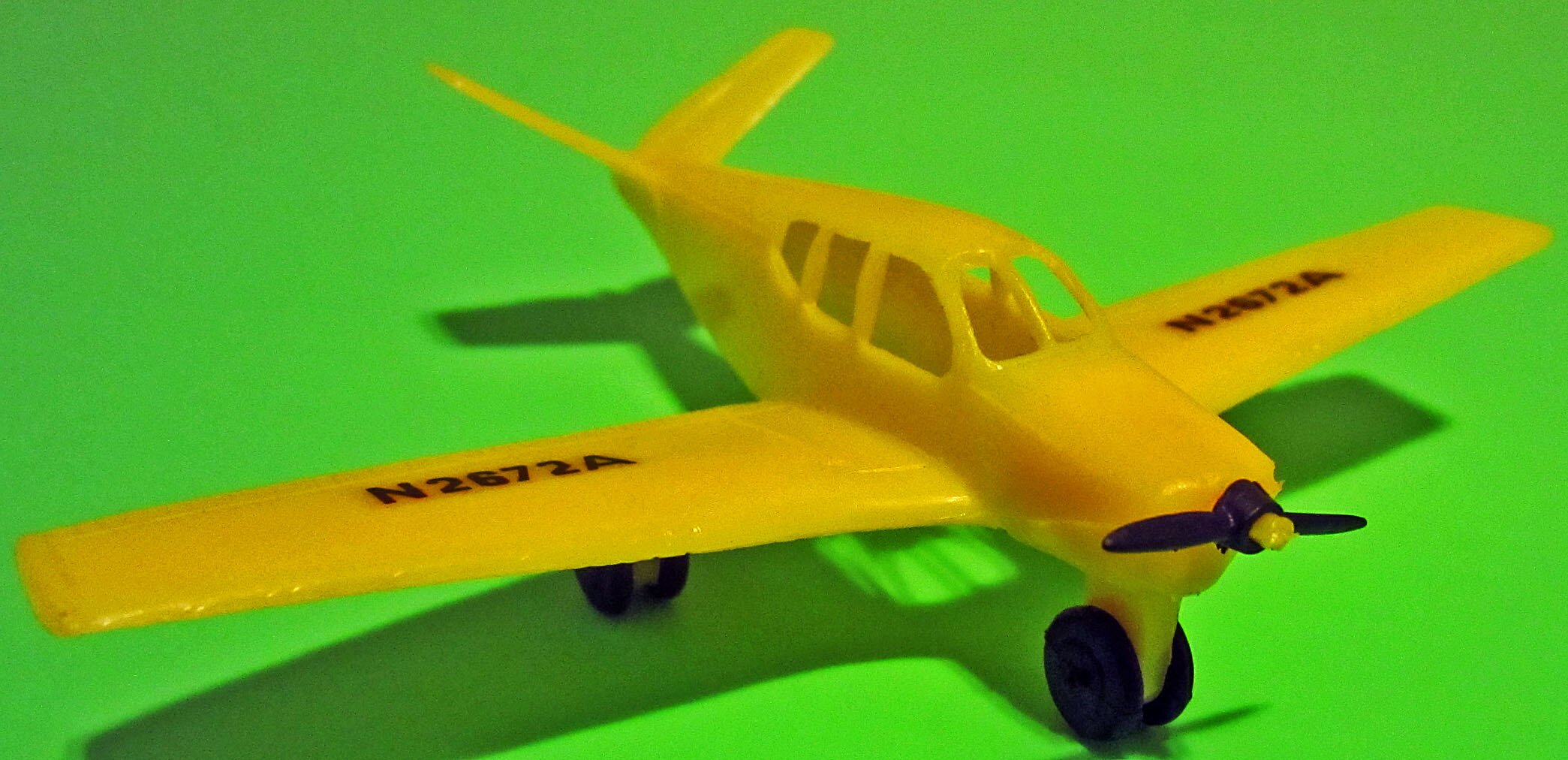 |
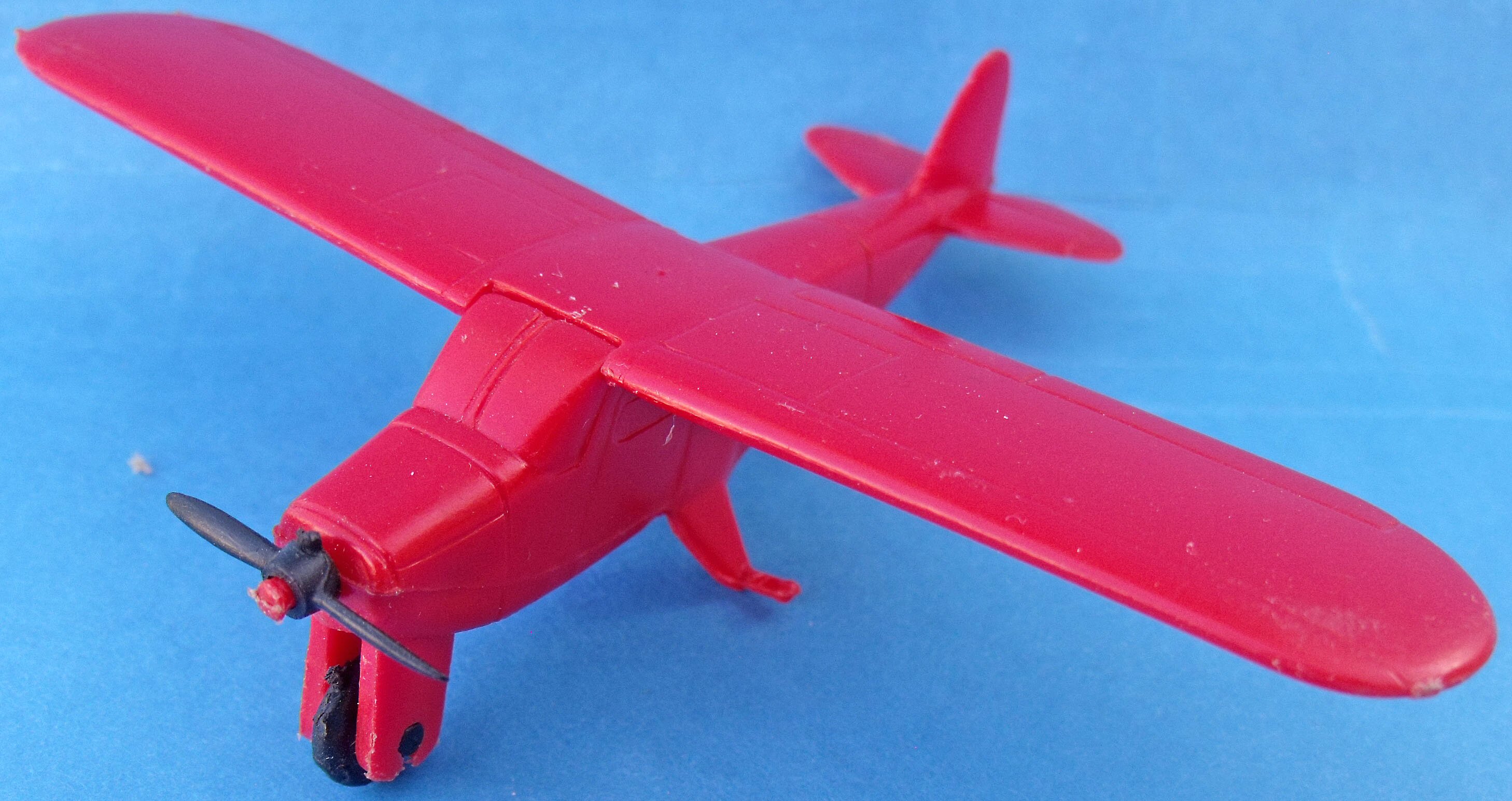 |
| Beechcraft Bonanza aircraft Photo courtesy of collector Phil Webb |
Piper Tri-tracer 3-1/4 inches long, rear wheels missing |
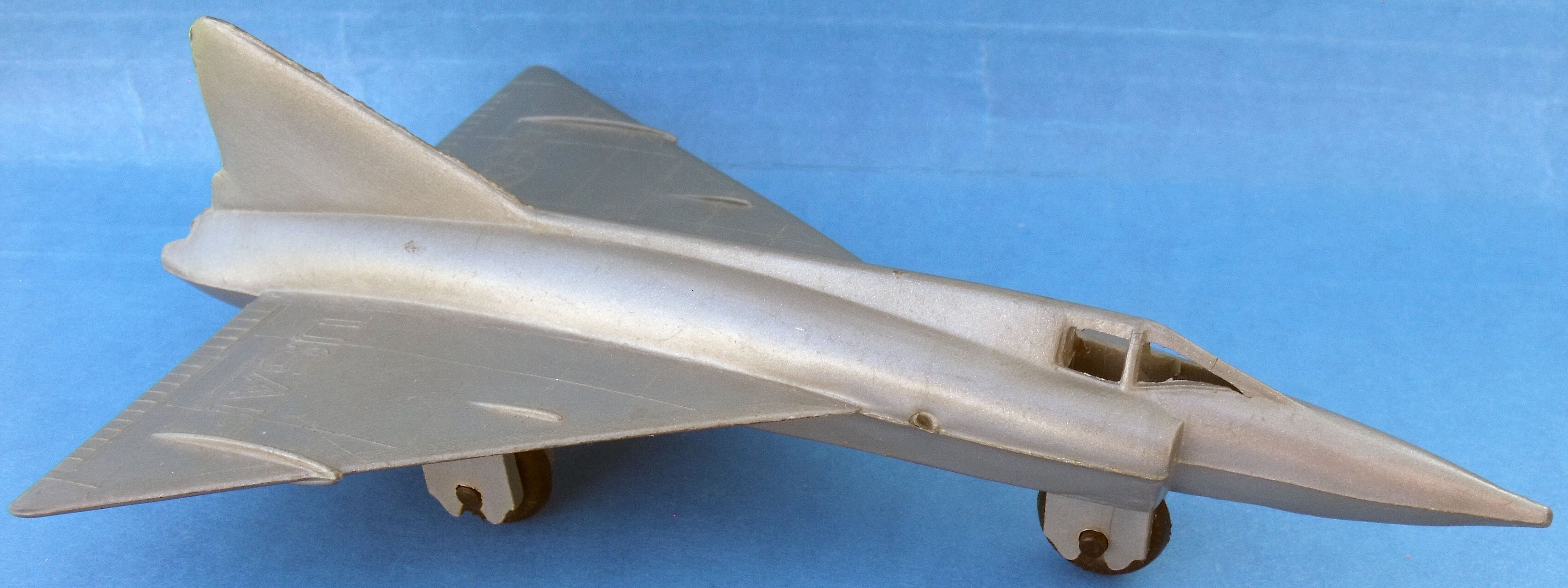 |
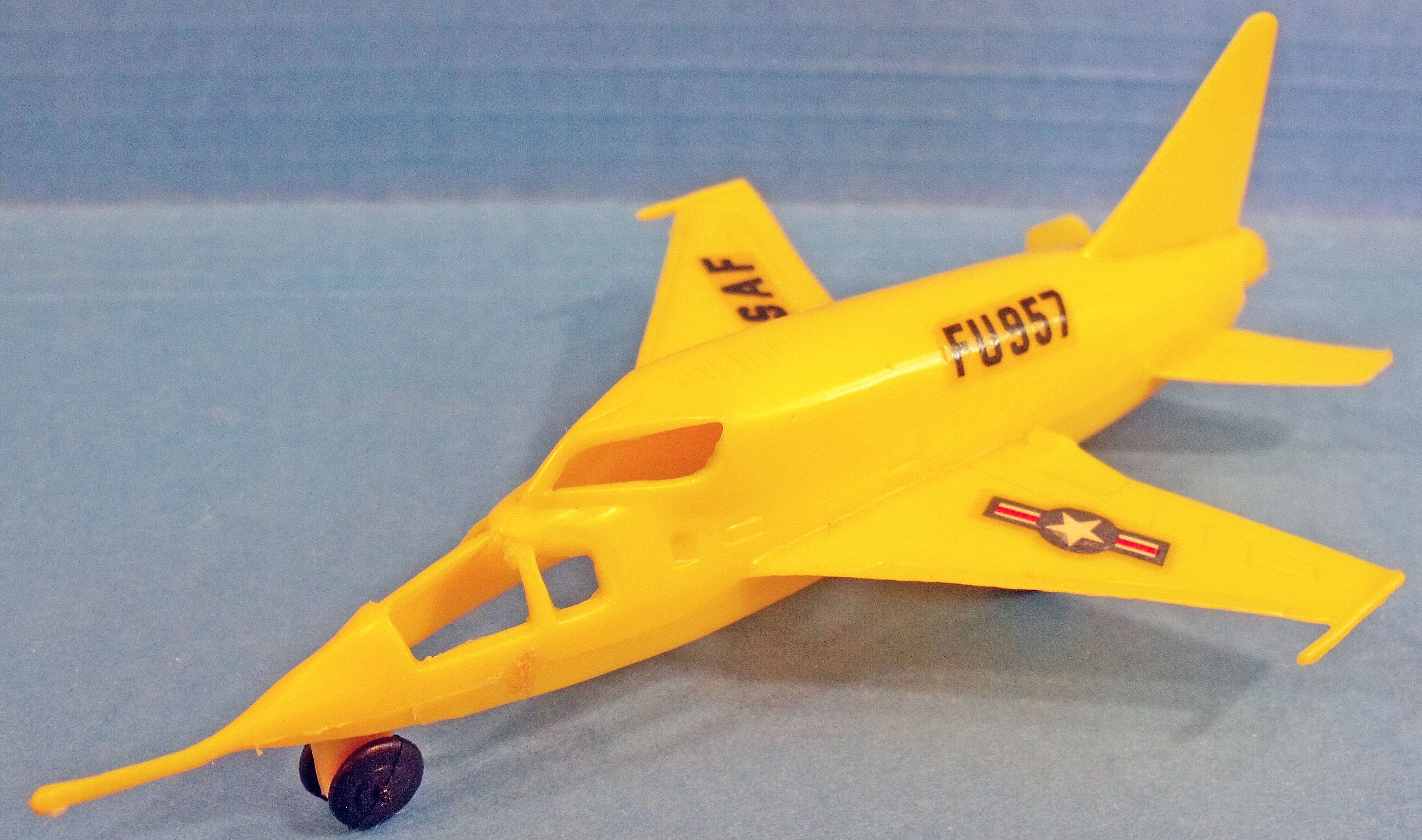 |
| Delta Dagger 5-1/2 inches long |
F107A "Thunderchief" 6-1/2 inches long |
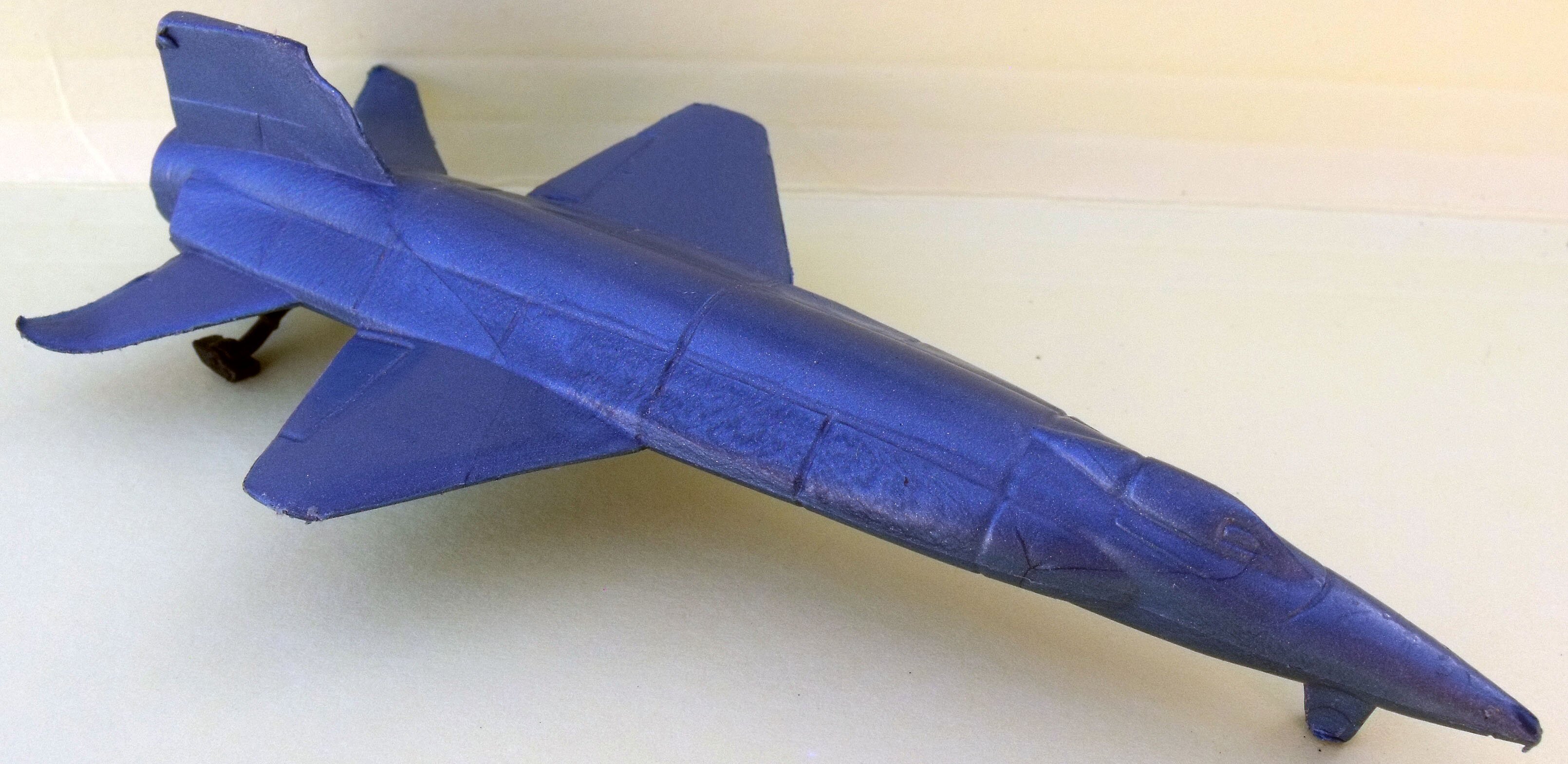 |
|
| X-15 experimental aircraft 4-1/2 inches long |
|
Helicopters
Most sets also included a pair of helicopters. One was similar to the other small aircraft, not really up to normal Marx quality. It is considered to be a part of the small plastic planes group above. This Vertrol 107 was the predecessor of the CH46 Sea Knight helicopter that was extensively used by the Navy and Marine Corps. Marx' version is significantly downsized, as it could hold about 25 troops plus crew.
The other helicopter, added to airport playsets in 1961, was the company's flying helicopter. This flying version was included in some military and space exploration playsets. PFPC reports that it is a 10-piece item, but once assembled it includes the rather large launching mechanism, the helicopter itself, and a stabilizer rod to keep the helicopter balanced on the launcher prior to flight. If you have one with its spring-powered mechanism still working, PFPC warns that you should not turn the mechanism more than four to six times prior to flight or it will break.
The idea of a flying helicopter seems good, but based on my experience, the helicopter's flight attempts are very erratic, very short, and more closely resemble a helicopter crashing than flying. Both the helicopters are hollow shells with little detail.
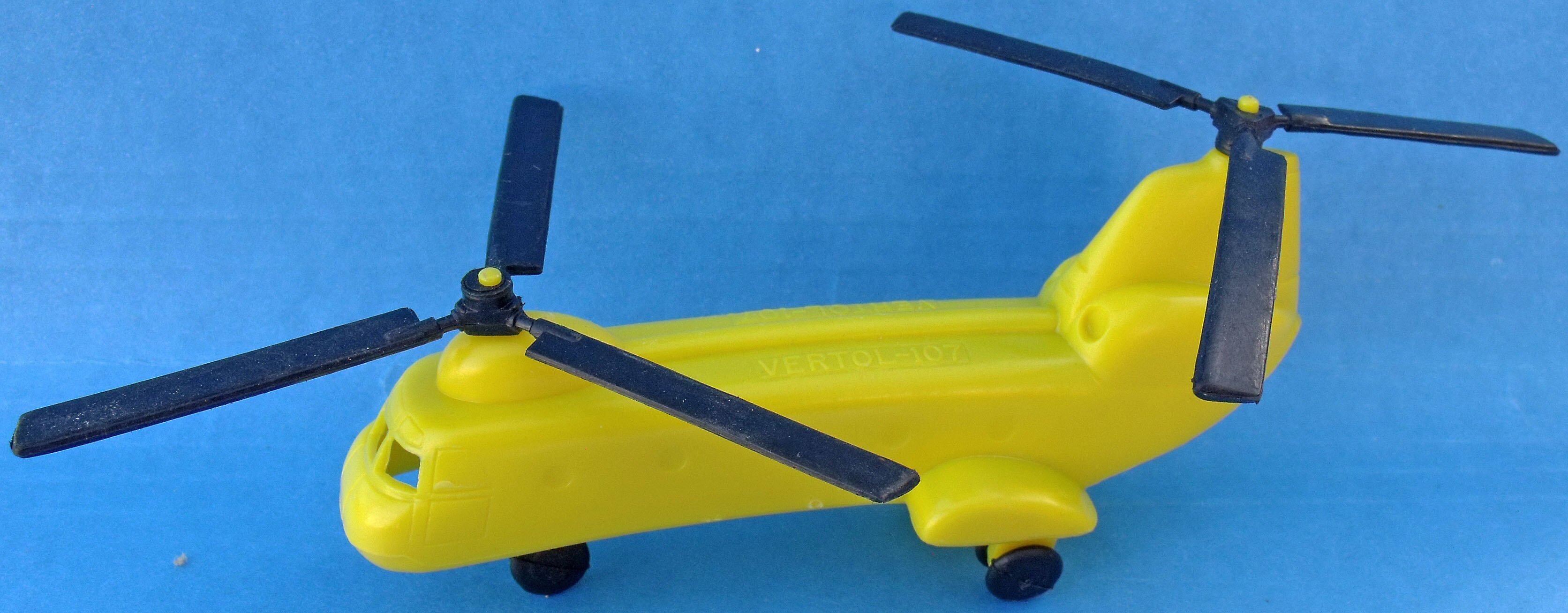 |
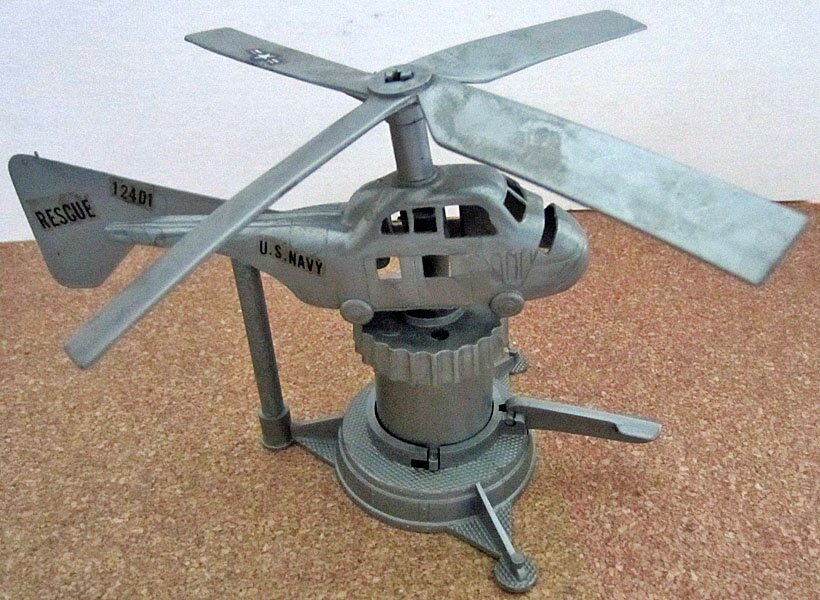 |
| Vertrol 107 helicopter 4-1/2 inches long, body only |
Flying helicopter (PL-1098 and 1098A) Photo courtesy of collector Phil Webb |
 A final plane was Marx's rocket-firing Delta Wing Jet, which also was in several military and space playsets. I am uncertain which specific airplane Marx' miniature represents, because there were several aircraft manufactured using the delta wing concept. Its inclusion in civilian airport sets is somewhat illogical, but I suppose that it did add a little play action to what I consider otherwise extremely tame playsets.
A final plane was Marx's rocket-firing Delta Wing Jet, which also was in several military and space playsets. I am uncertain which specific airplane Marx' miniature represents, because there were several aircraft manufactured using the delta wing concept. Its inclusion in civilian airport sets is somewhat illogical, but I suppose that it did add a little play action to what I consider otherwise extremely tame playsets.The plane is large, just over seven inches long, and generally came in silver hard plastic, though it occasionally was found in metallic blue. Watch out for its the small radar "antenna" projecting from its nose. The piece was molded on and is easily broken off, missing from many of these items on the market today. You can see it in the first photo below, but it is missing in the second photo.
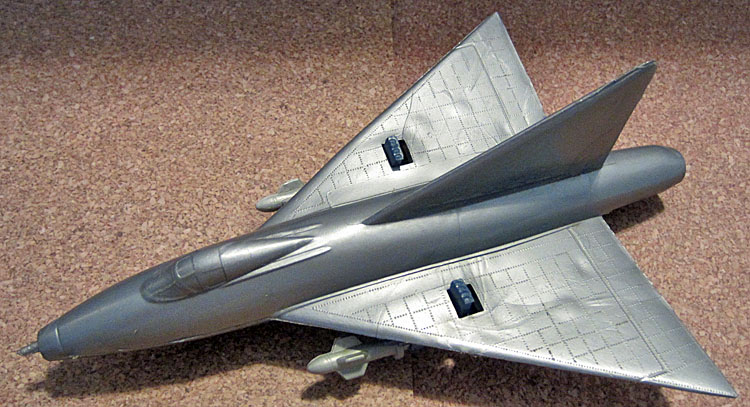 |
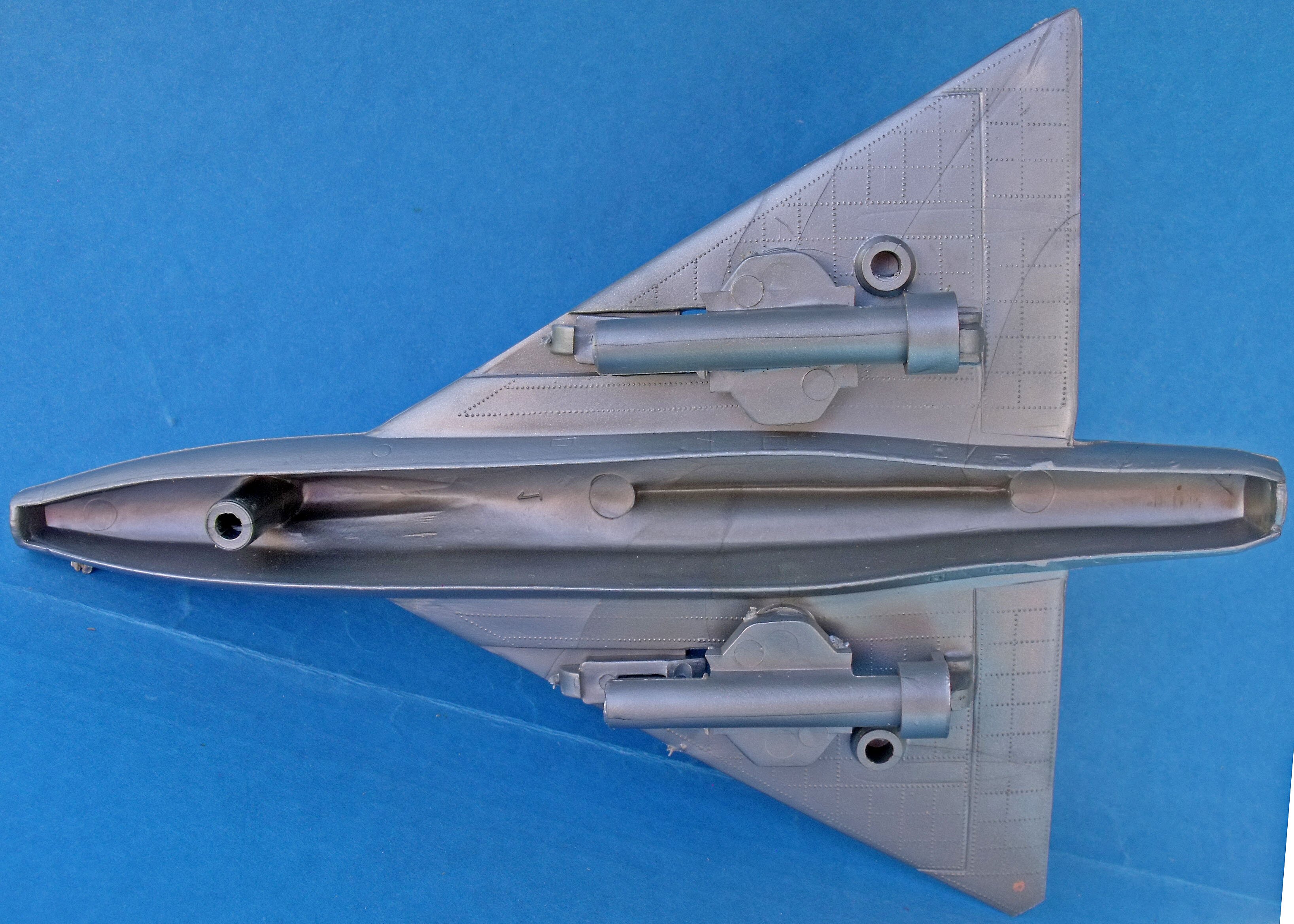 |
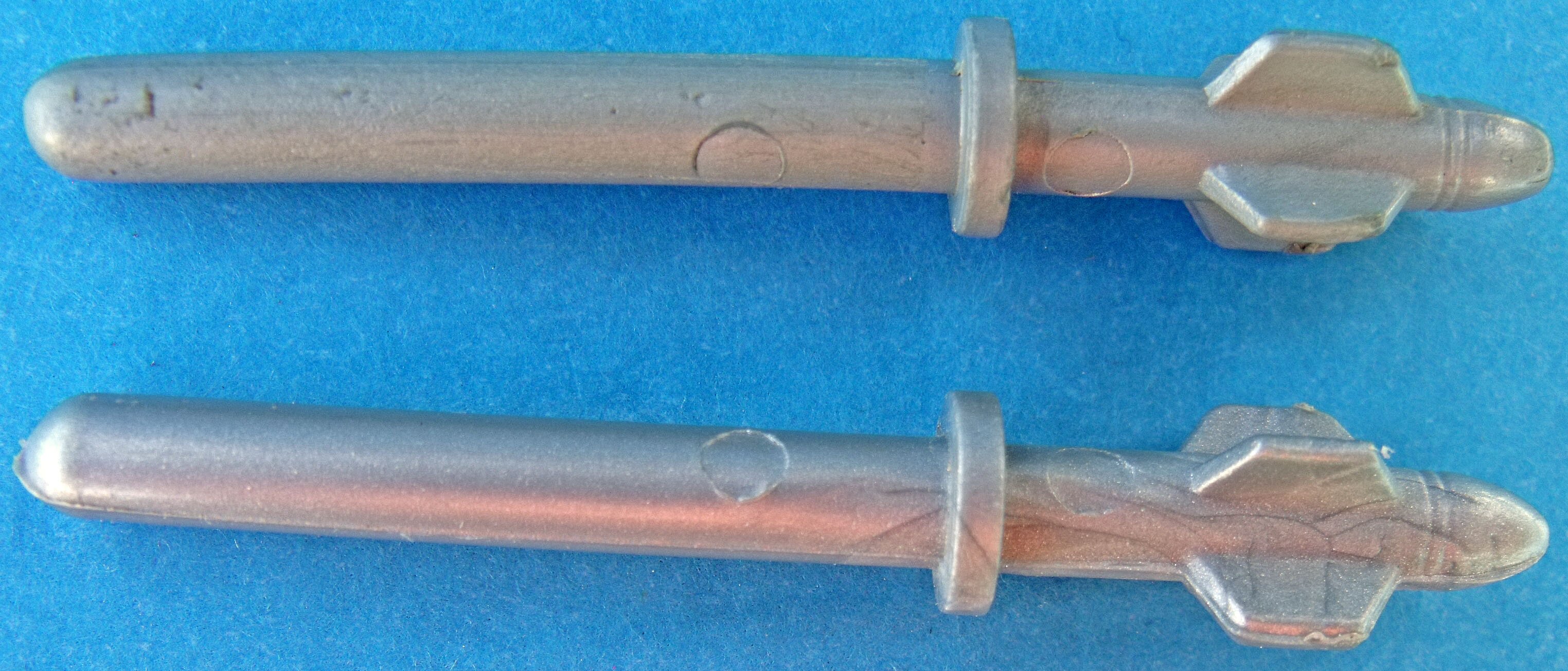 |
| Rocket-firing Delta Wing Jet aircraft Photo courtesy of Phil Webb |
Delta Jet underside | Missles for Delta Jet |
Friction powered planes
Most sets also included a friction-powered, tin litho jet plane. These, as well as the company's friction-powered ground vehicles, were made by Marx' Japanese subsidiary, Linemar. According to PFPC, two versions of the tin planes can be found, one in an X-15 style from the 1960 sets, and a more "sporty fighter model" labeled SV-3 in 1961 and later. Of course, the friction power only allowed the plane to race along on the floor, but I'm sure it was still pretty cool to us kids back in the 1960s. Just imagine a race between the friction-powered airplane and the friction-powered airport bus (see later on this page)!
 |
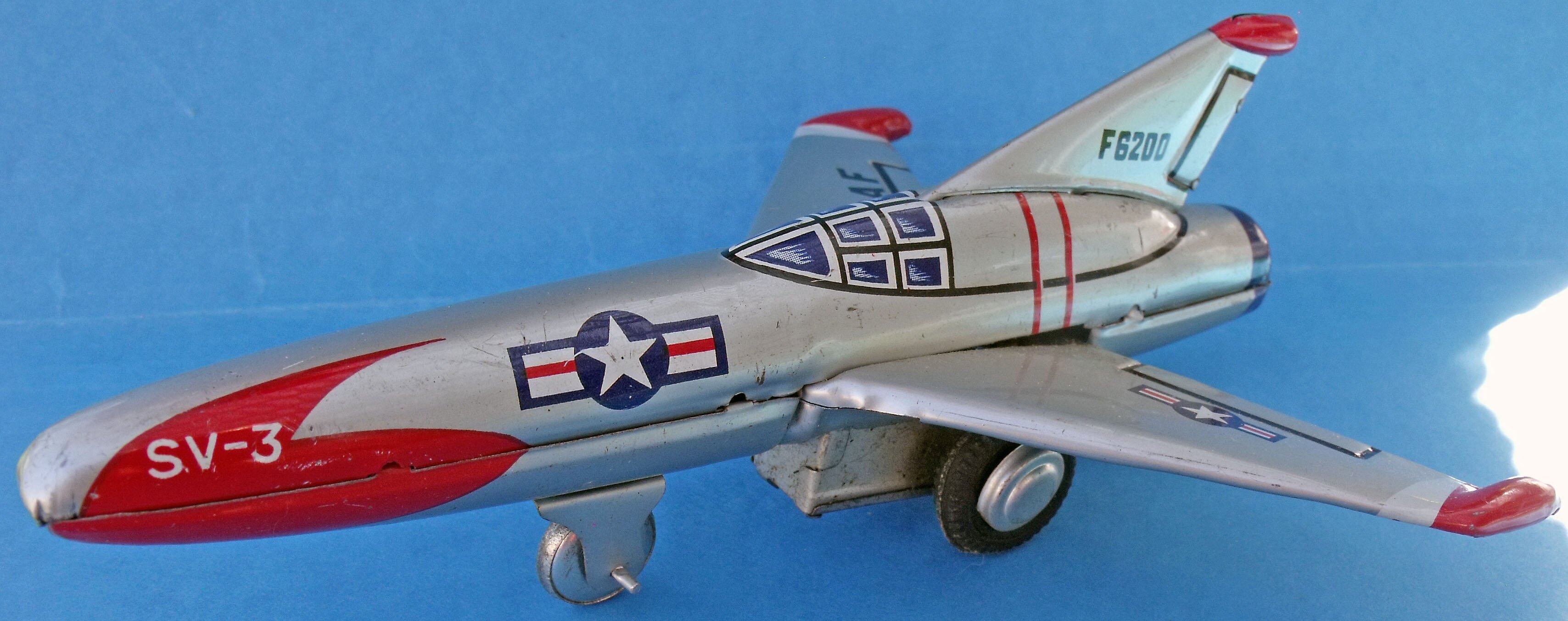 |
| First friction-powered X-15 jet plane Photo courtesy of collector Carlos Olmos, Ebay ID coco333 Top of tail is missing. |
Second friction-powered SV-3 jet plane about 6 inches long |
 |
|
| X-15 tail wing showing Linemar logo Photo courtesy of collector Carlos Olmos, Ebay ID coco333 |

| Figures |
A group of 24 figures used for airport playsets was a mix of figures both 1) designed specifically for the airport group and 2) previously used in construction, service station, train, and the Sears Store sets. PFPC reports that seven figures were designed specifically for the airports group. The mold included no duplicate poses, and also had a hand cart to go with a figure that is pushing the cart (to make a total of 25 items in the mold).
The figures were made in a cream plastic and are referred to as 35mm scale, though I find them to be generally 40mm. Playsets included either one or two groups.
A special touch for all airport sets is that the group has a seated air traffic controller who fits perfectly into the control tower to guide all the aircraft. I believe that he came only in airport sets. Funny thing is that until I bought the set, I thought the guy was supposed to be a pilot; even Geppert's Guide lists him as a pilot! With the number of aircraft that are included in airport sets, they really do need some guidance with the small number of runways available, all crossing right in the middle of the airfield!.
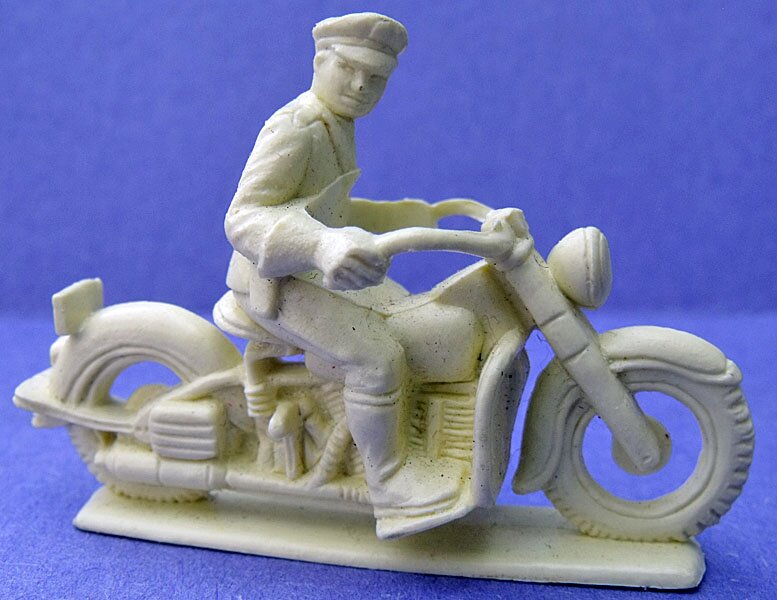 |
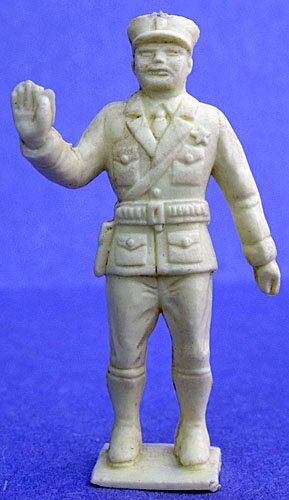 |
 |
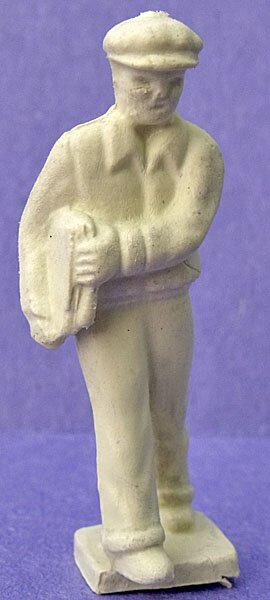 |
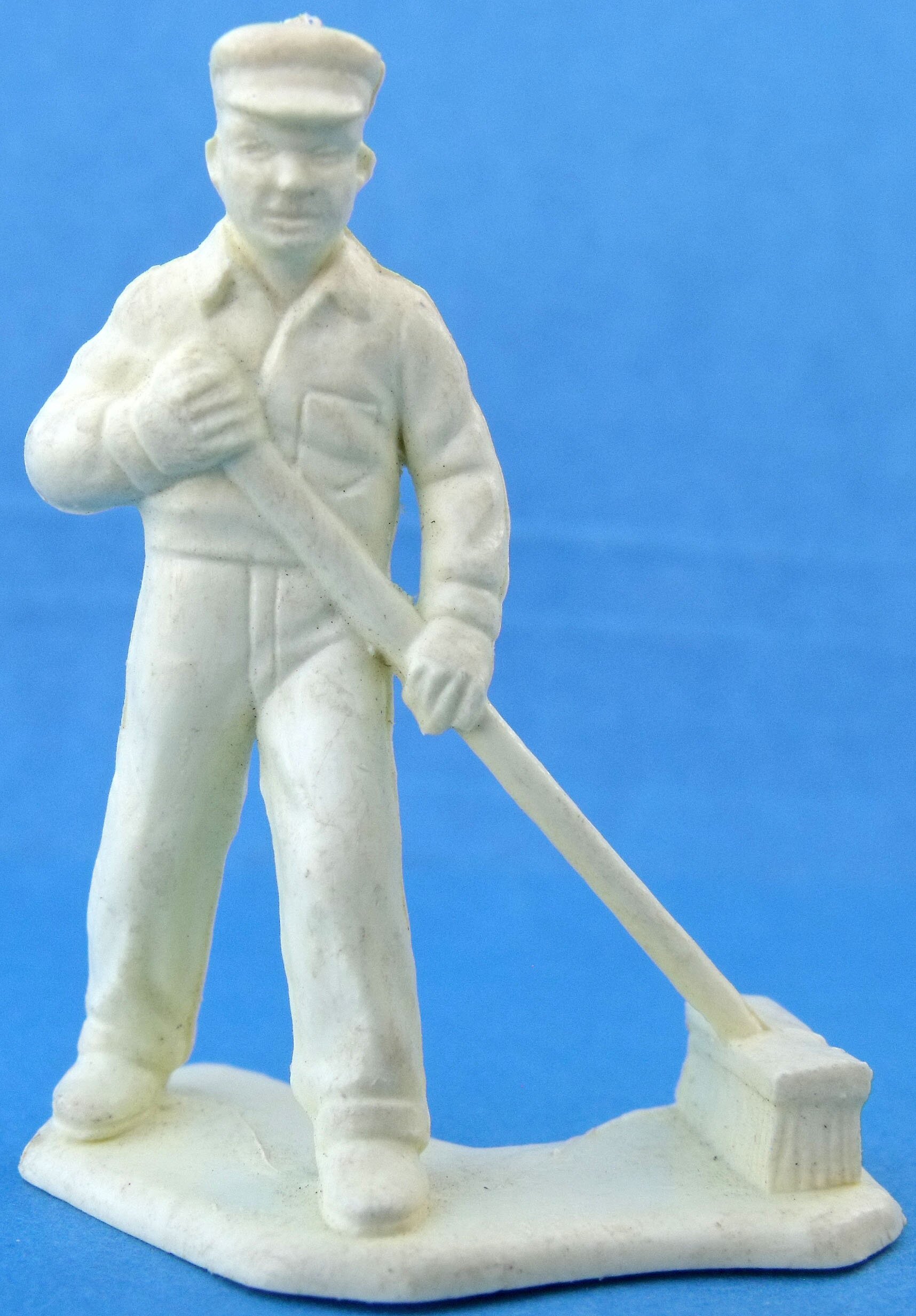 |
| 1. Policeman on motorcycle | 2. Policeman standing, right hand up | 3. Man carrying box on shoulder | 4. Newsboy | 5. Man pushing broom |
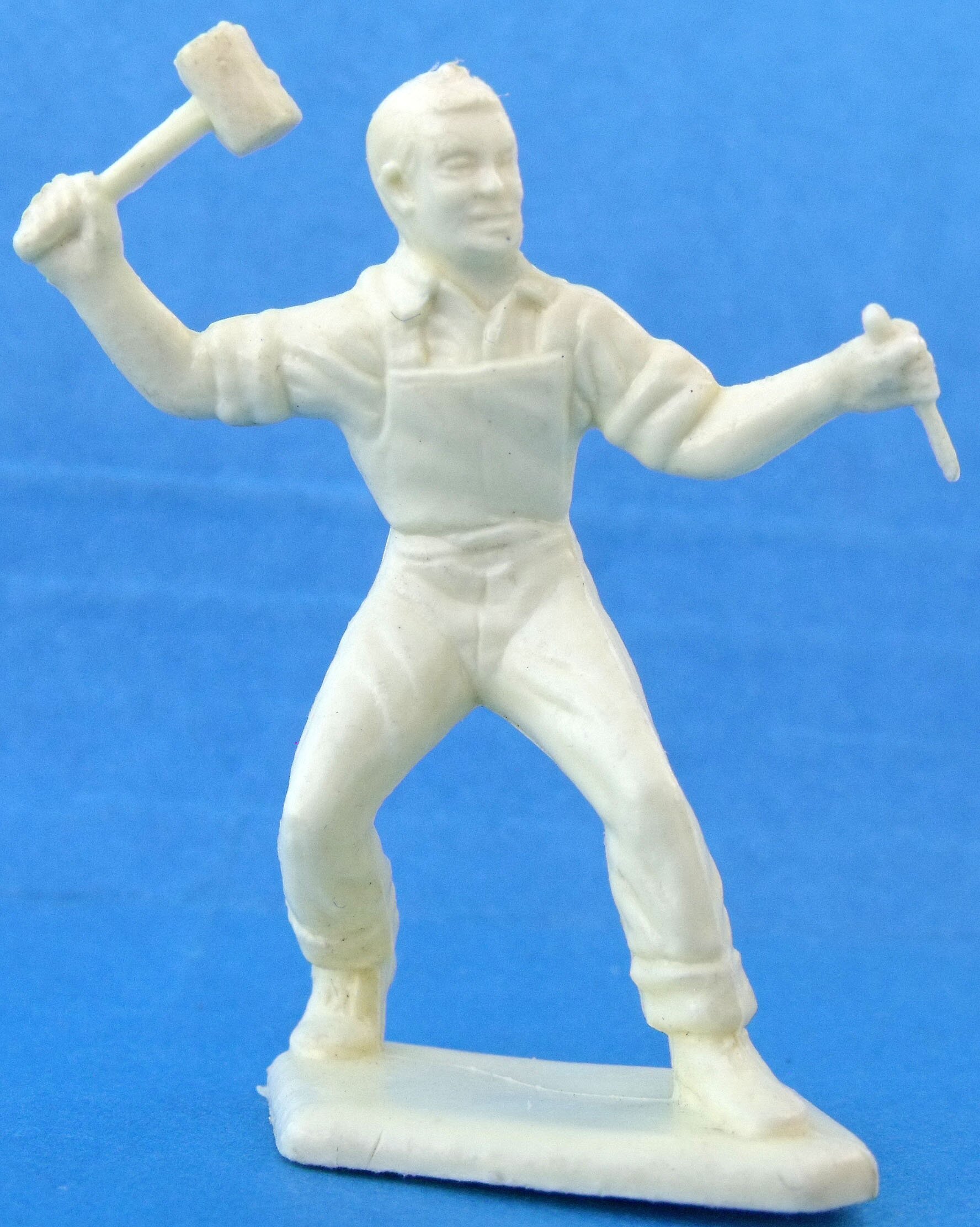 |
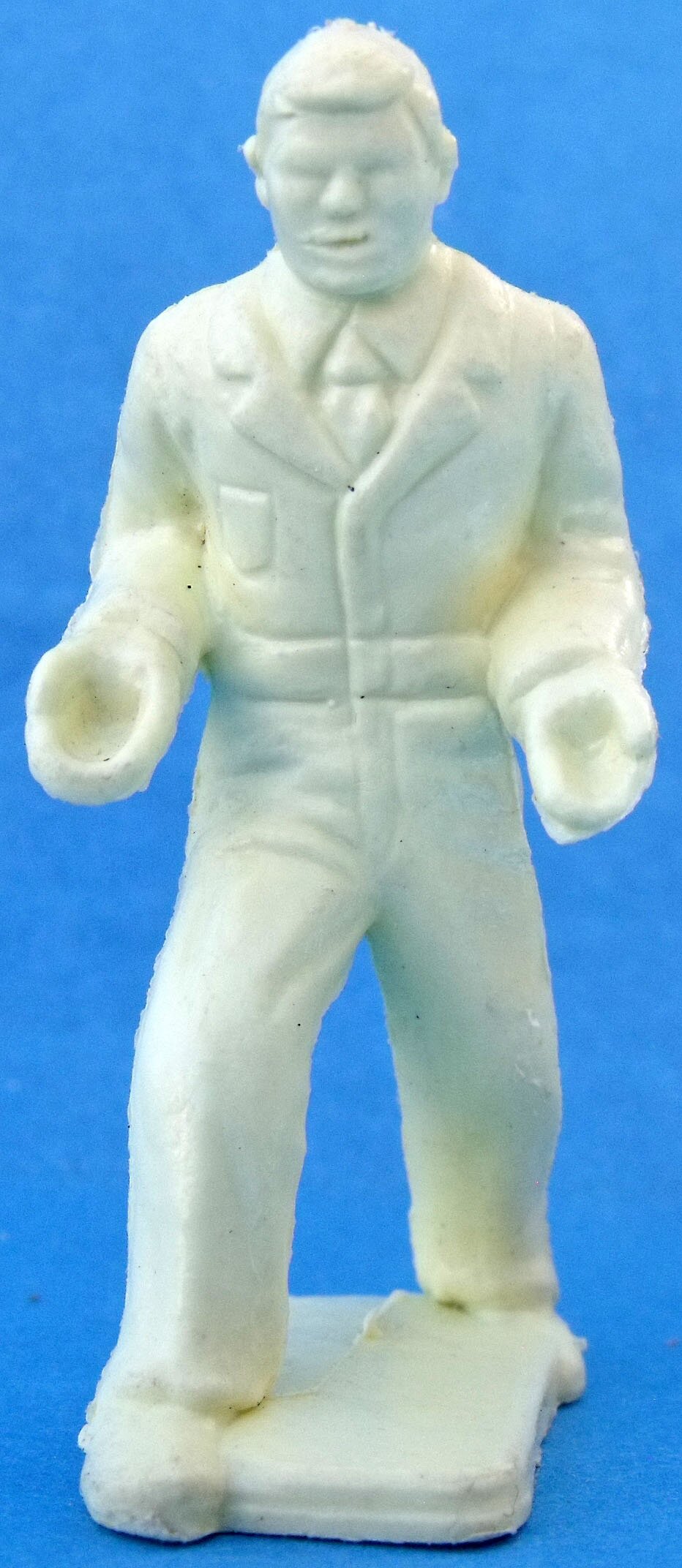 |
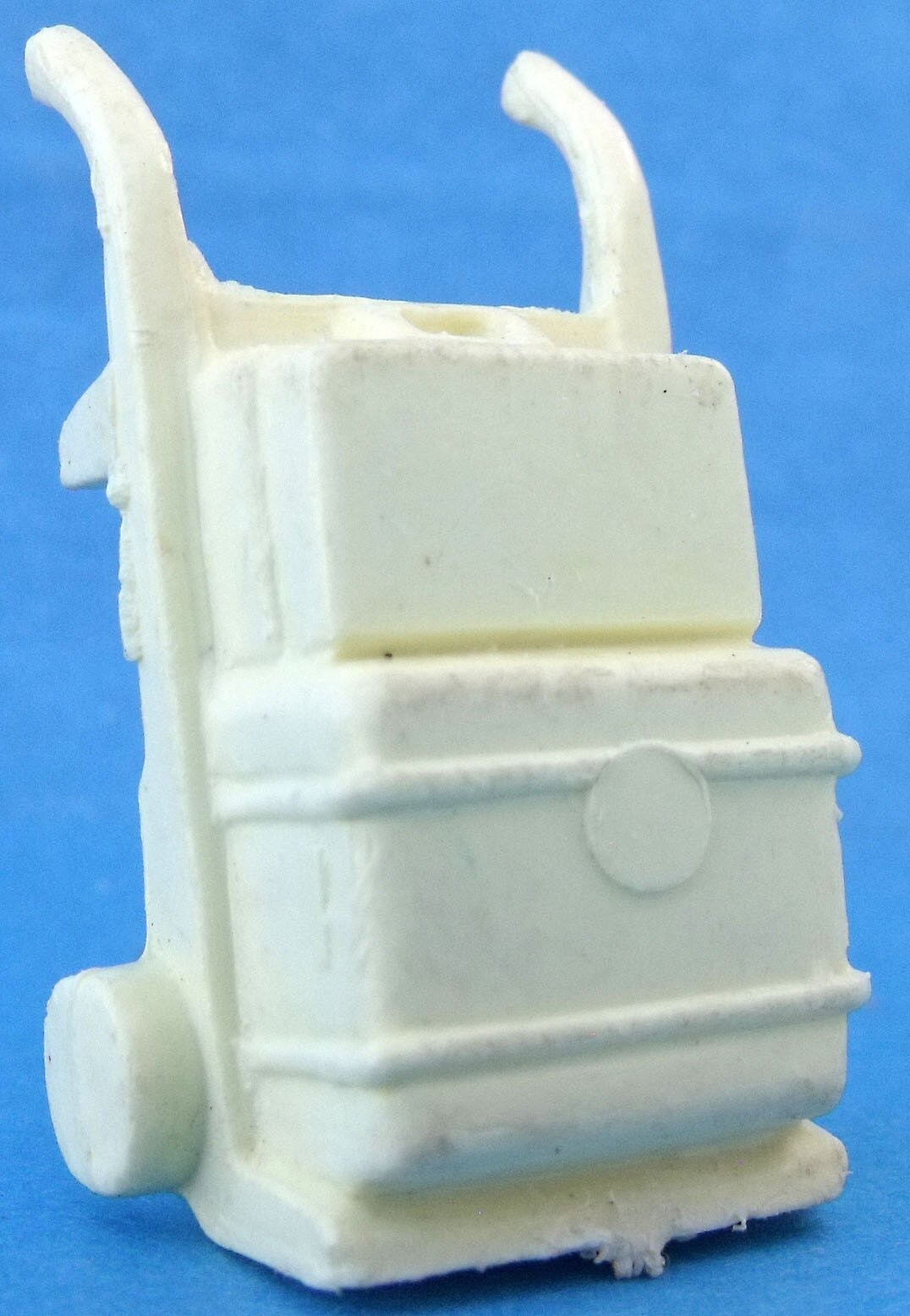 |
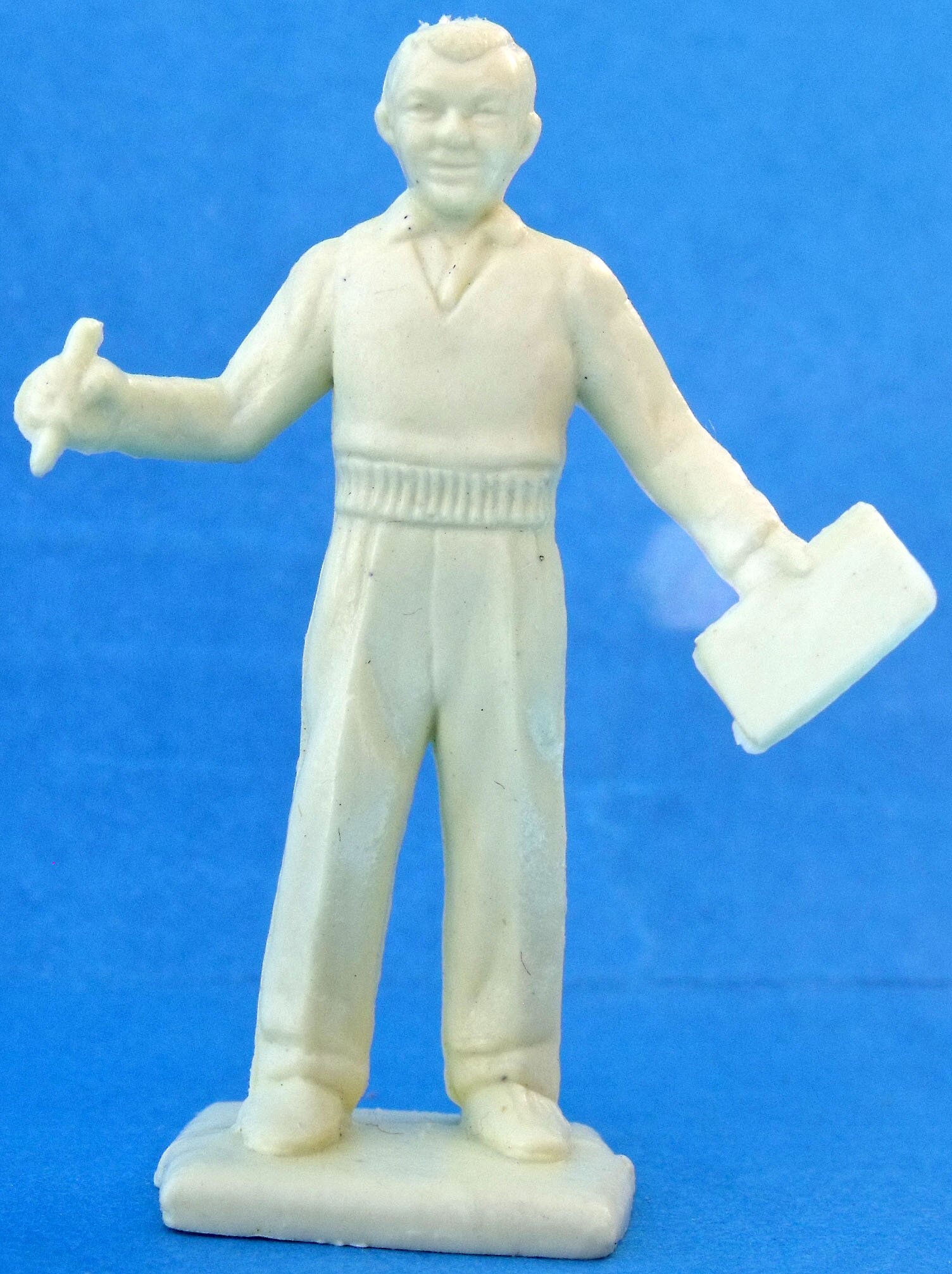 |
 |
| 6. Man with hammer and chisel | 7. Man pushing hand cart | 8. Hand cart | 9. Man with pencil and paper | 10. Man with paper, right arm extended |
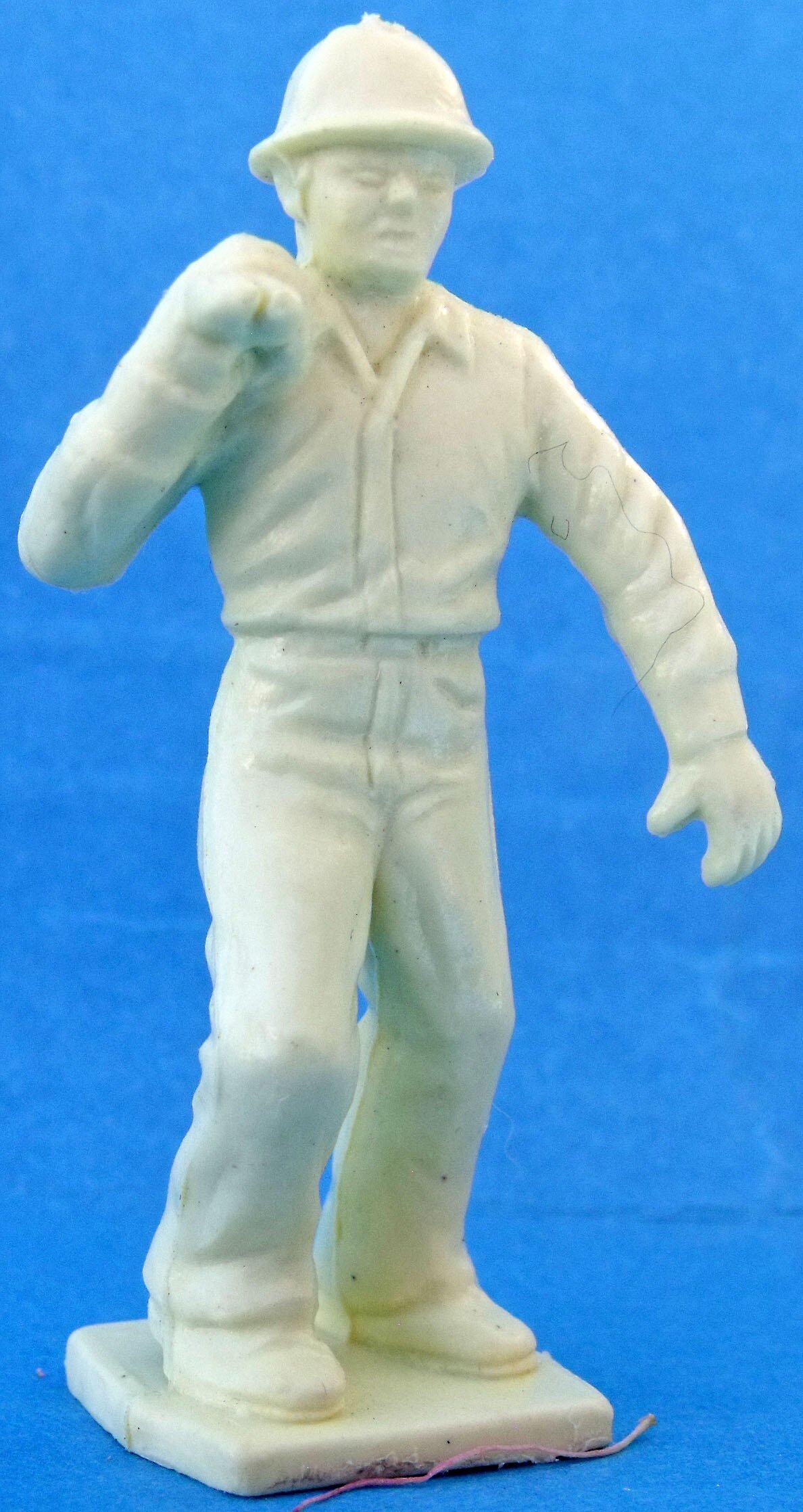 |
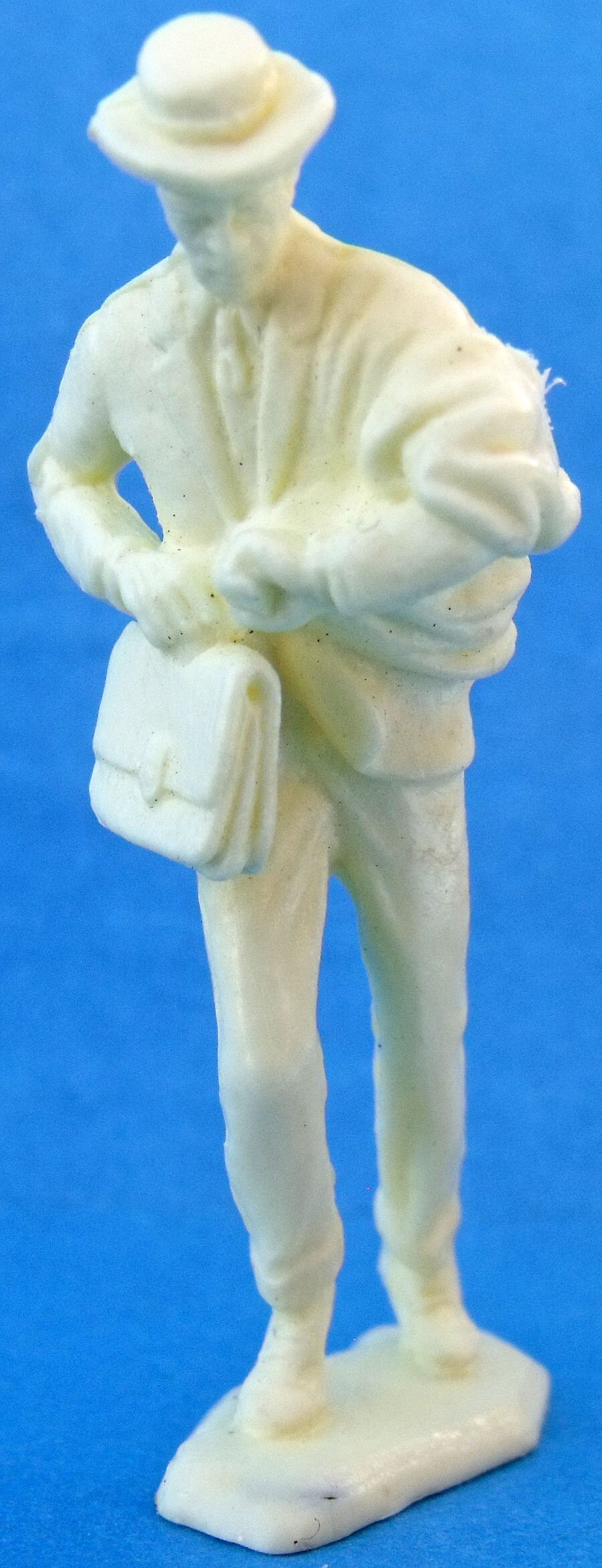 |
 |
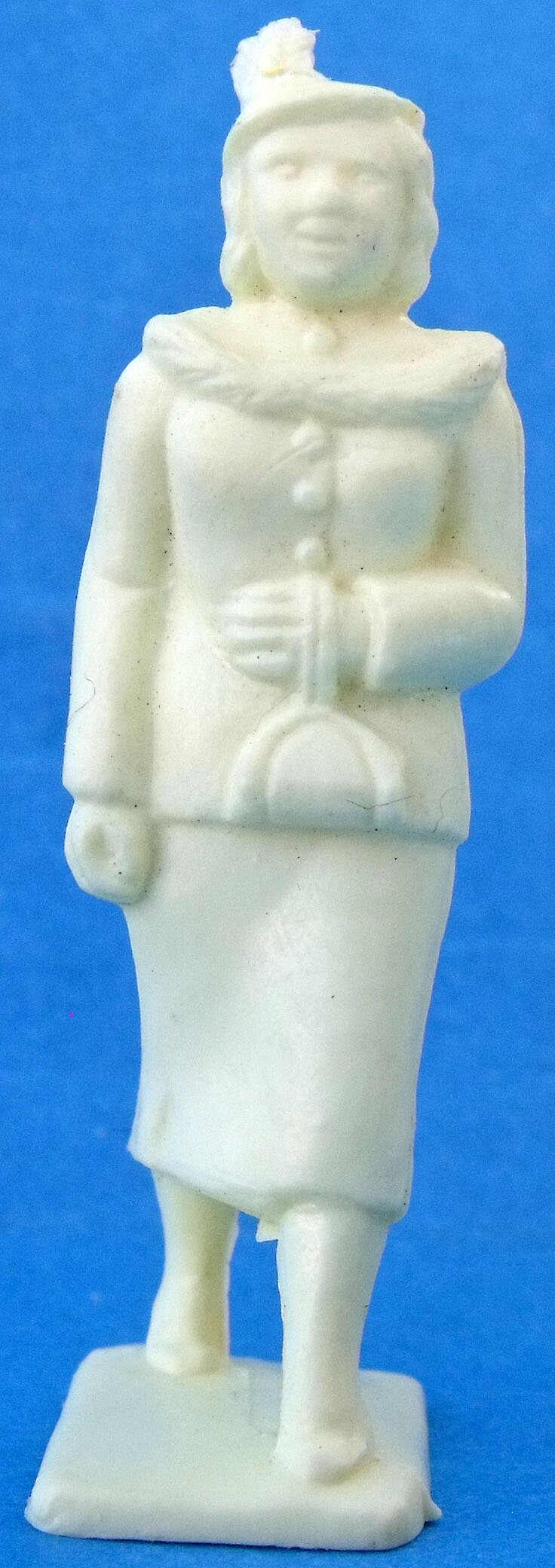 |
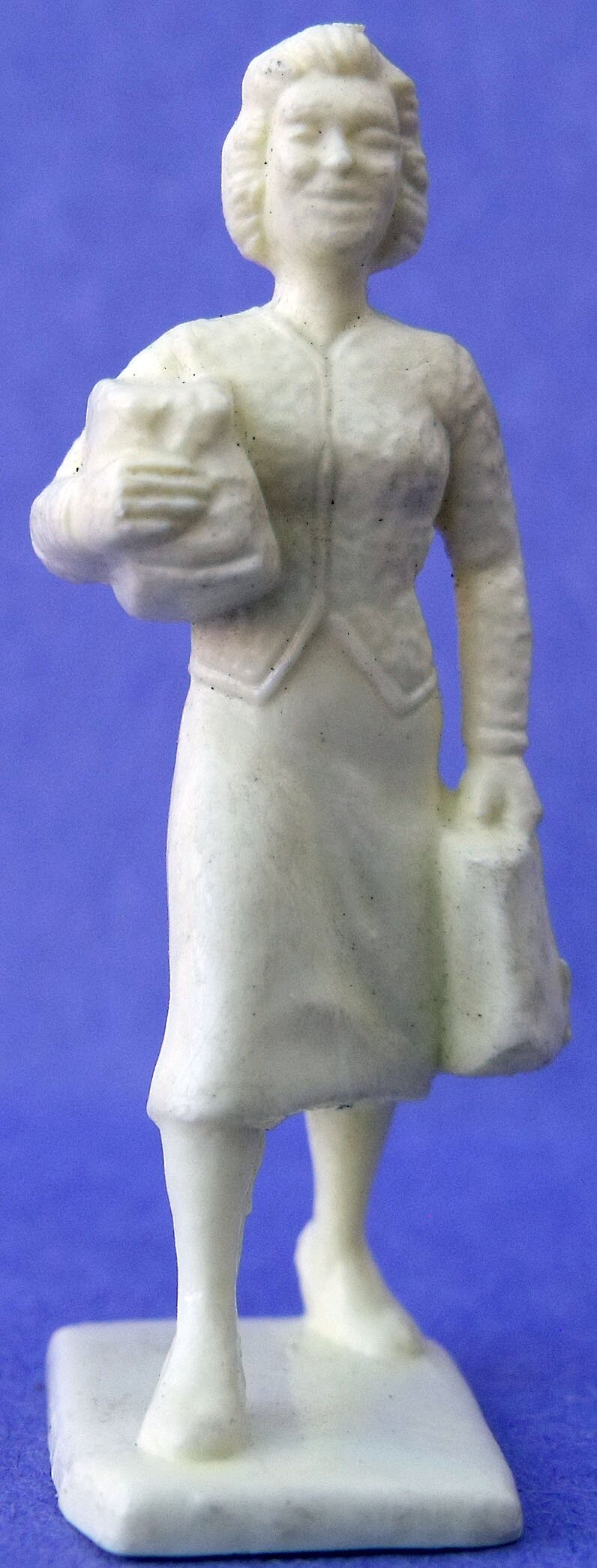 |
| 11. Man in hard hat, wrench on shoulder | 12. Man in suit, looking at watch | 13. Woman pushing baby stroller | 14. Woman wearing hat with purse | 15. Woman carrying grocery bags |
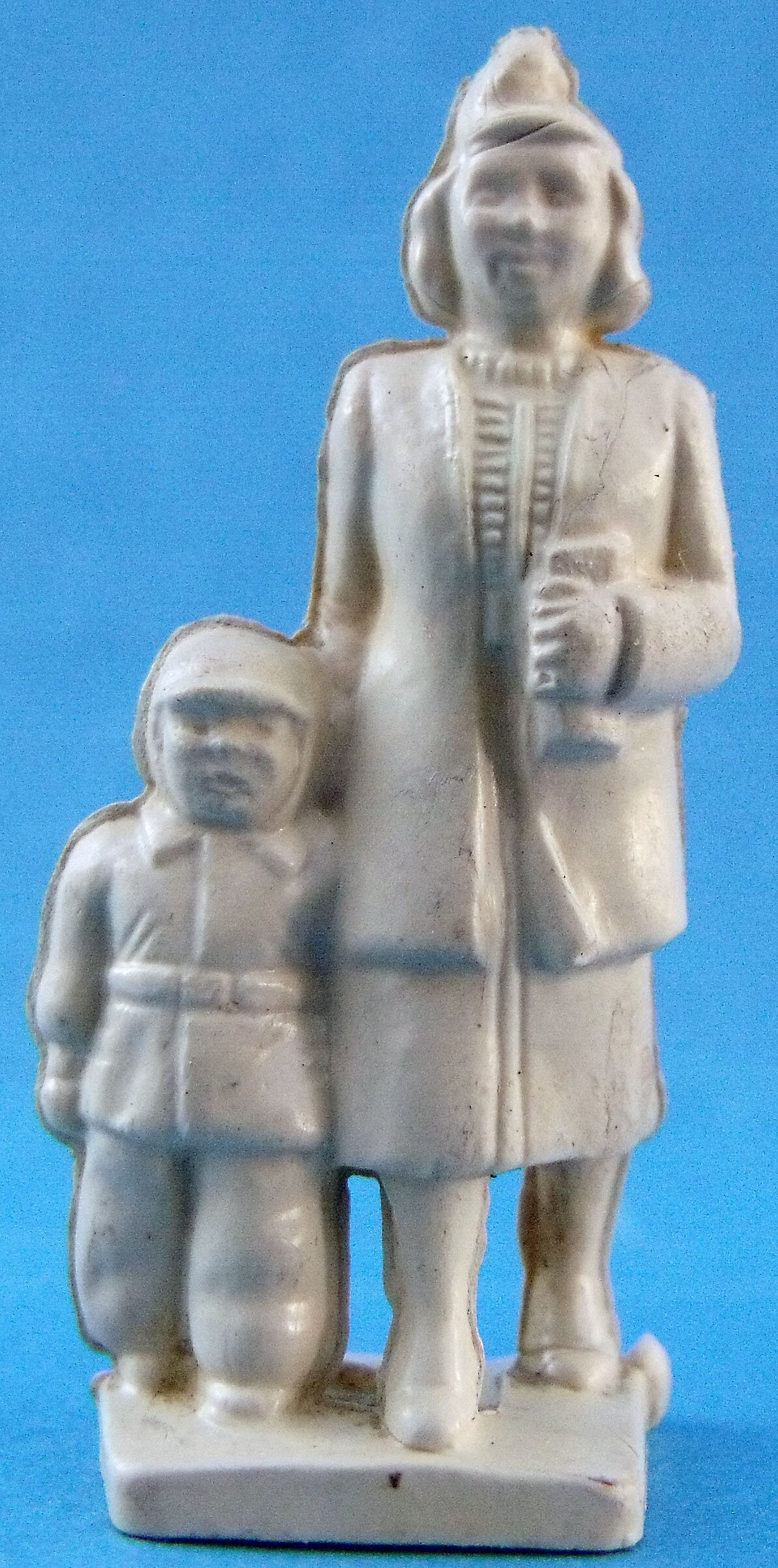 |
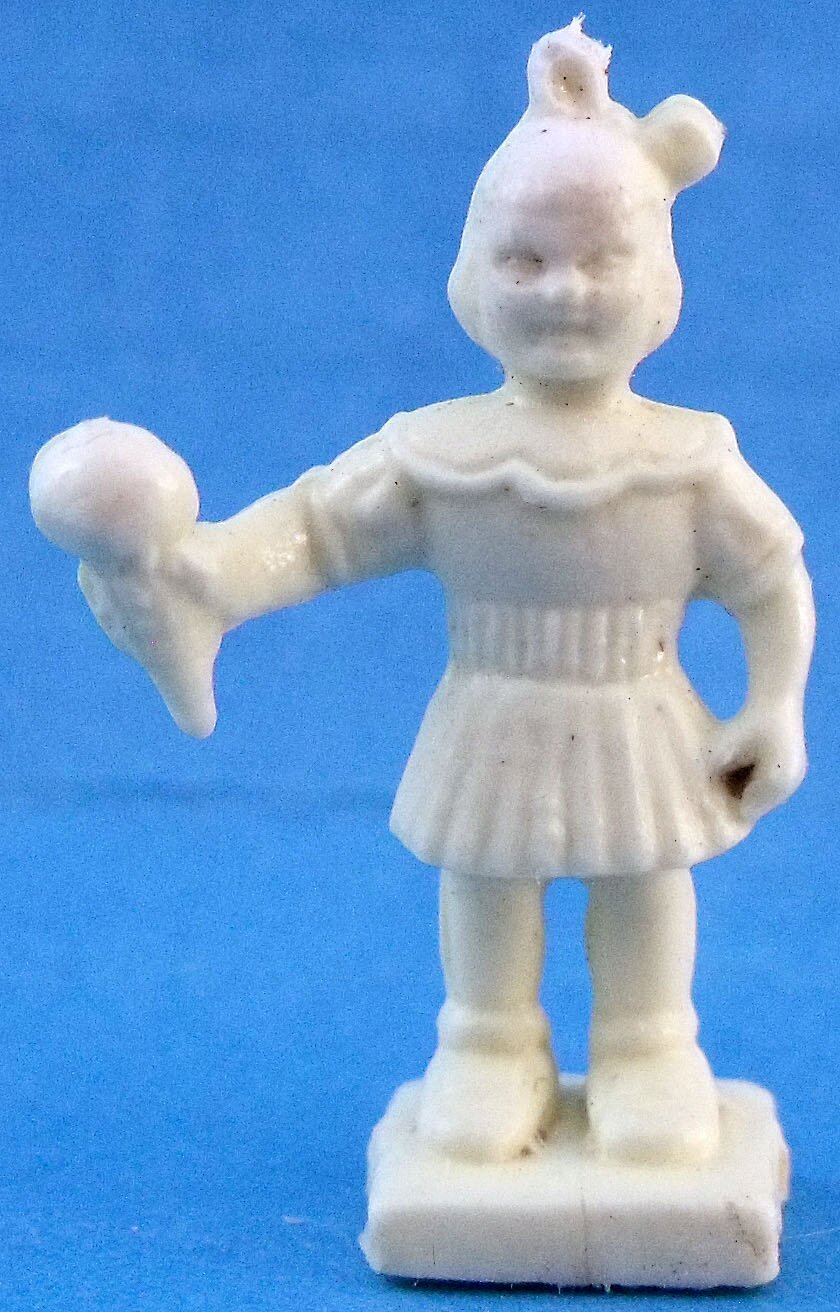 |
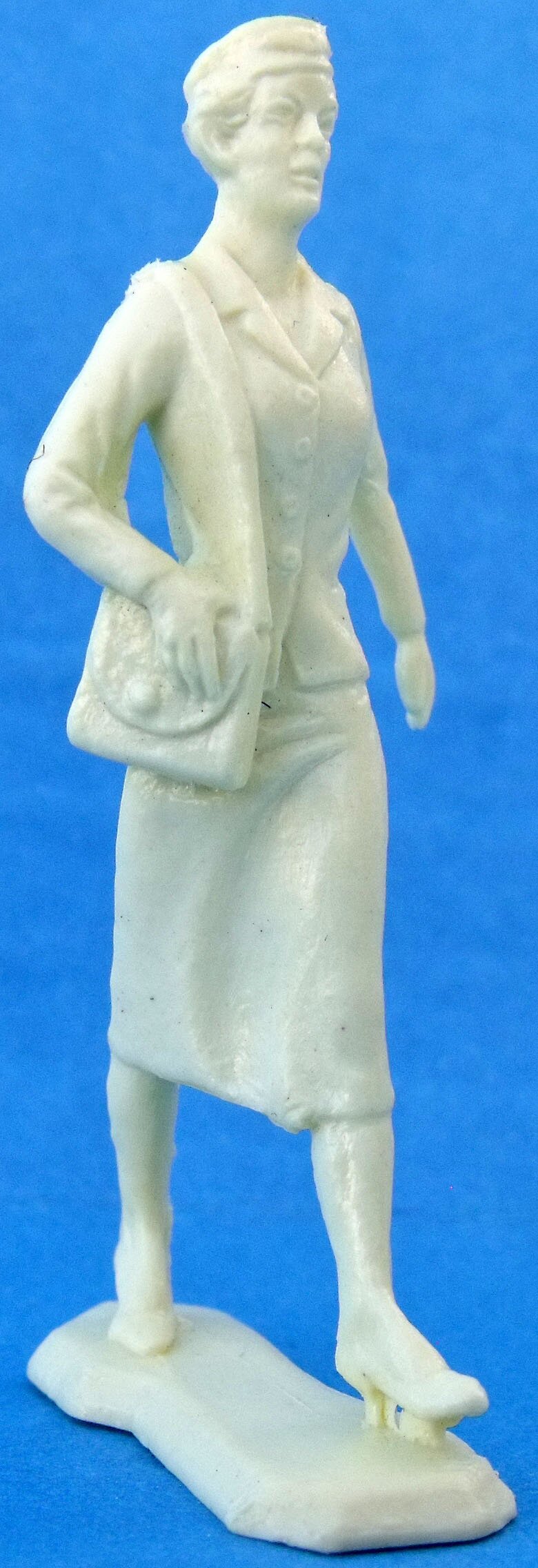 |
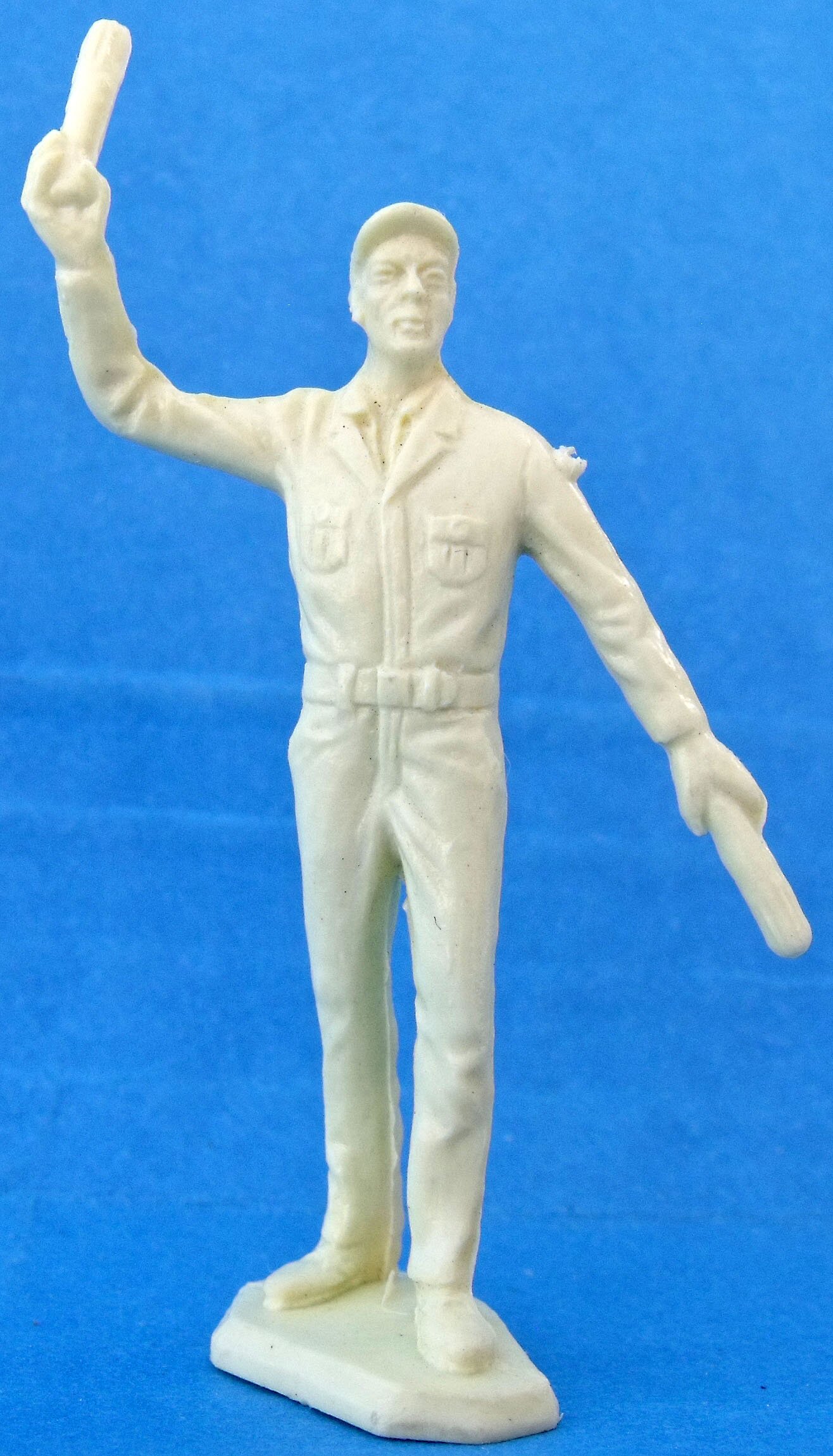 |
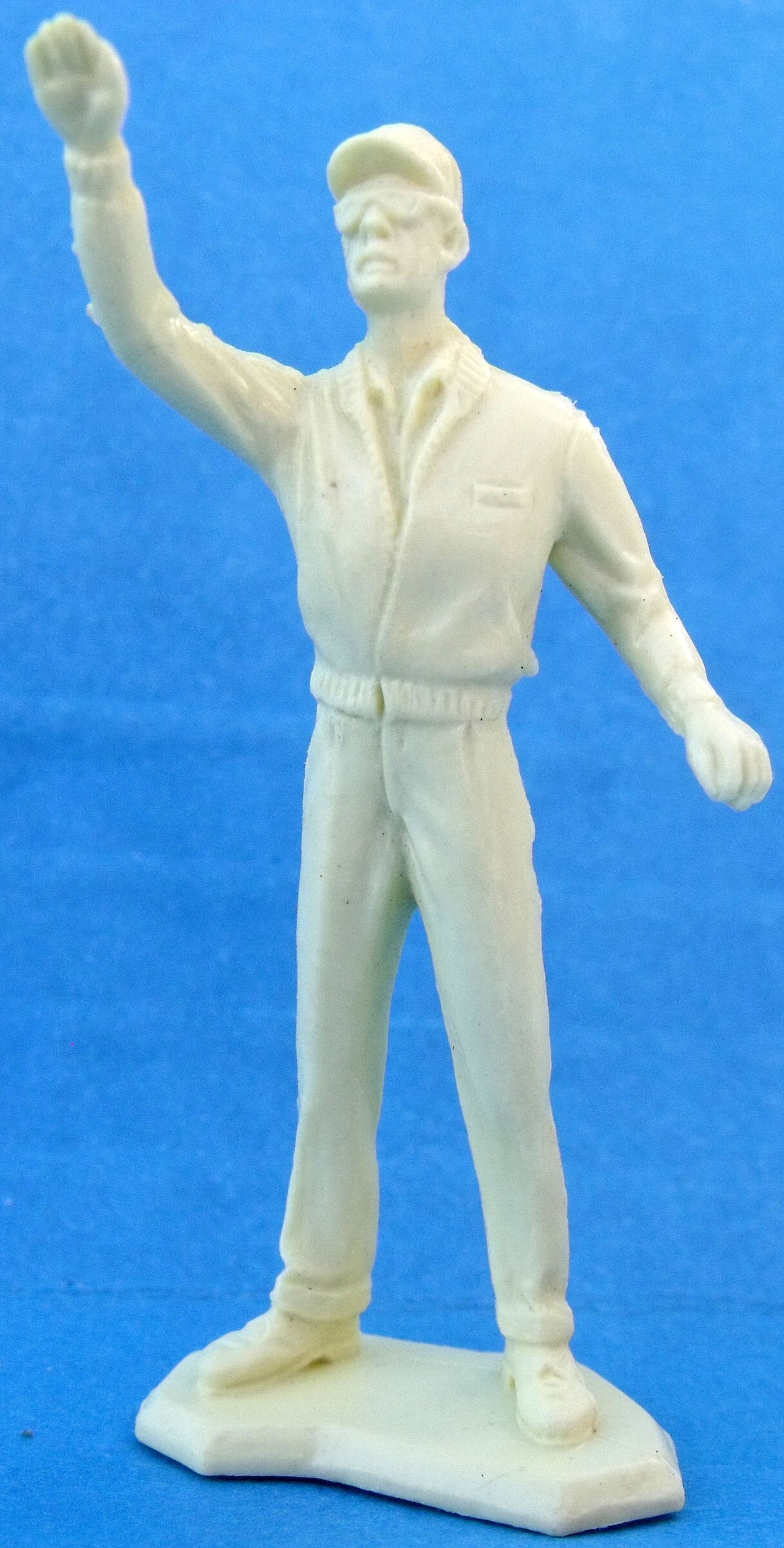 |
| 16. Woman standing with child | 17. Girl with ice cream cone | 18. Stewardess with shoulder bag | 19. Ground crew with batons | 20. Ground crew wearing goggles, right hand up |
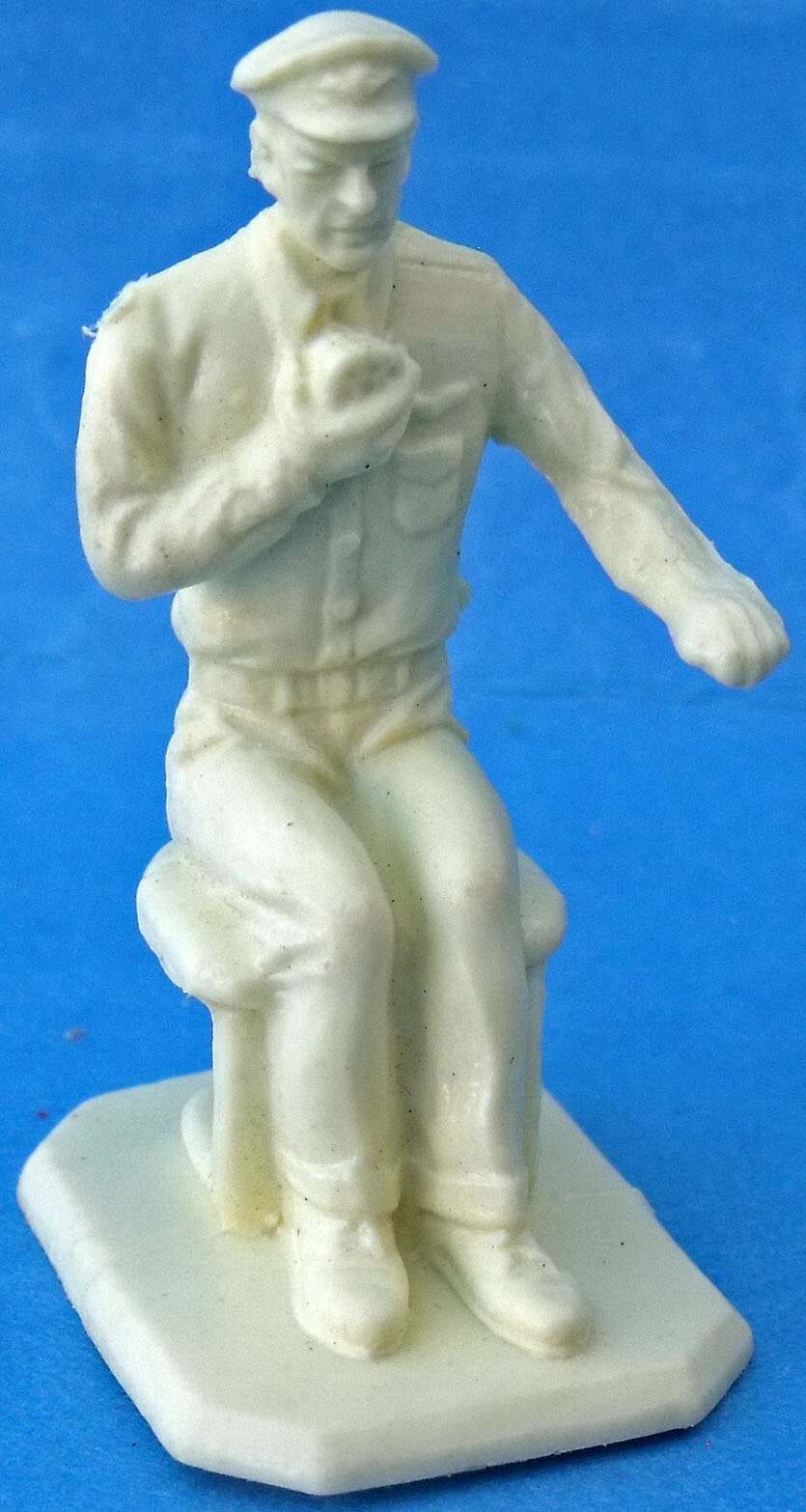 |
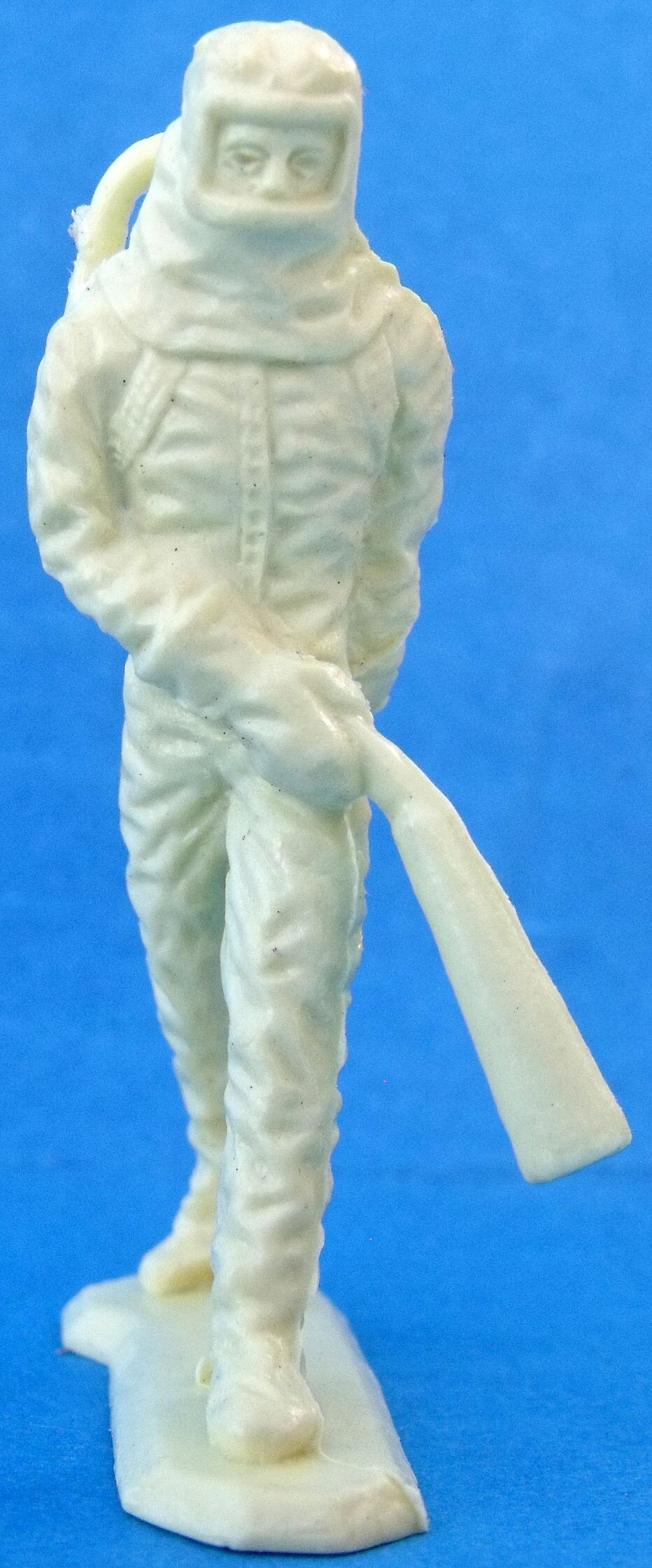 |
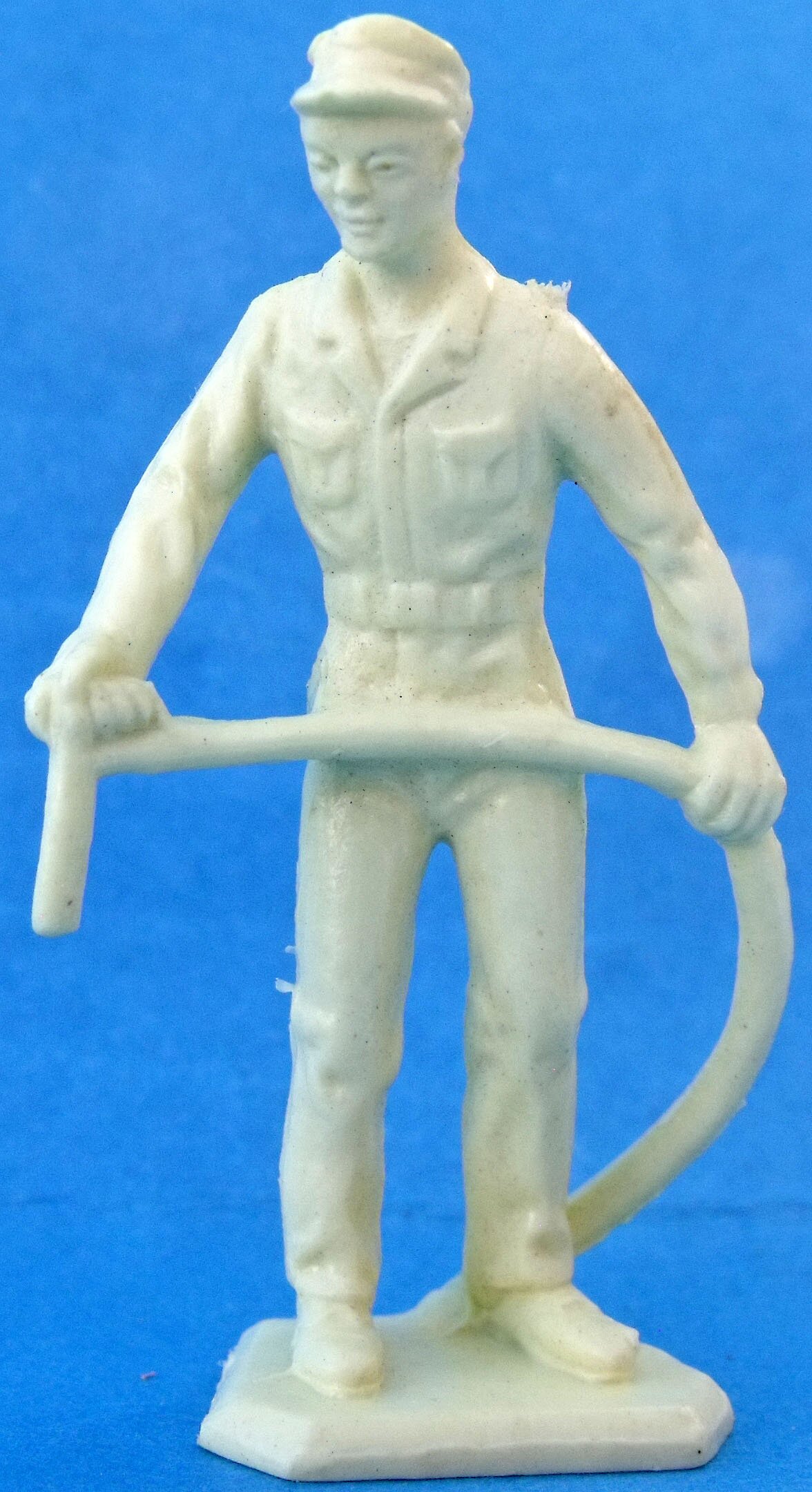 |
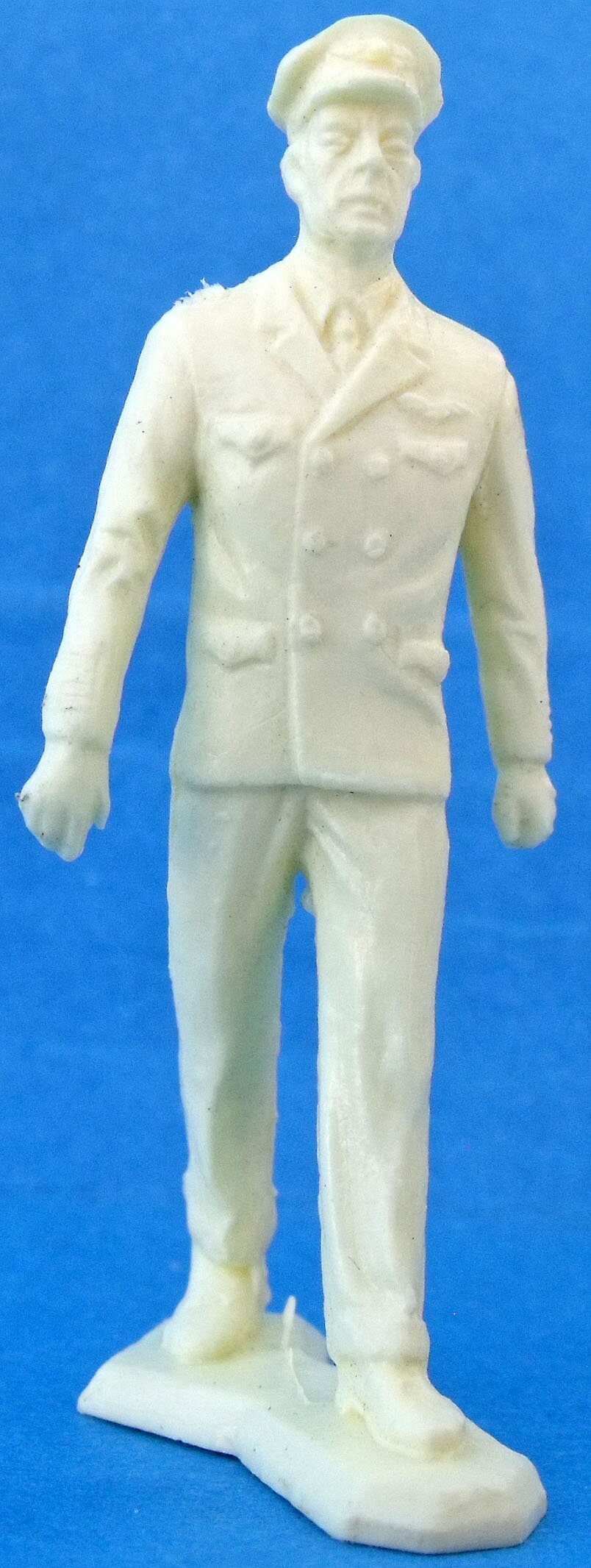 |
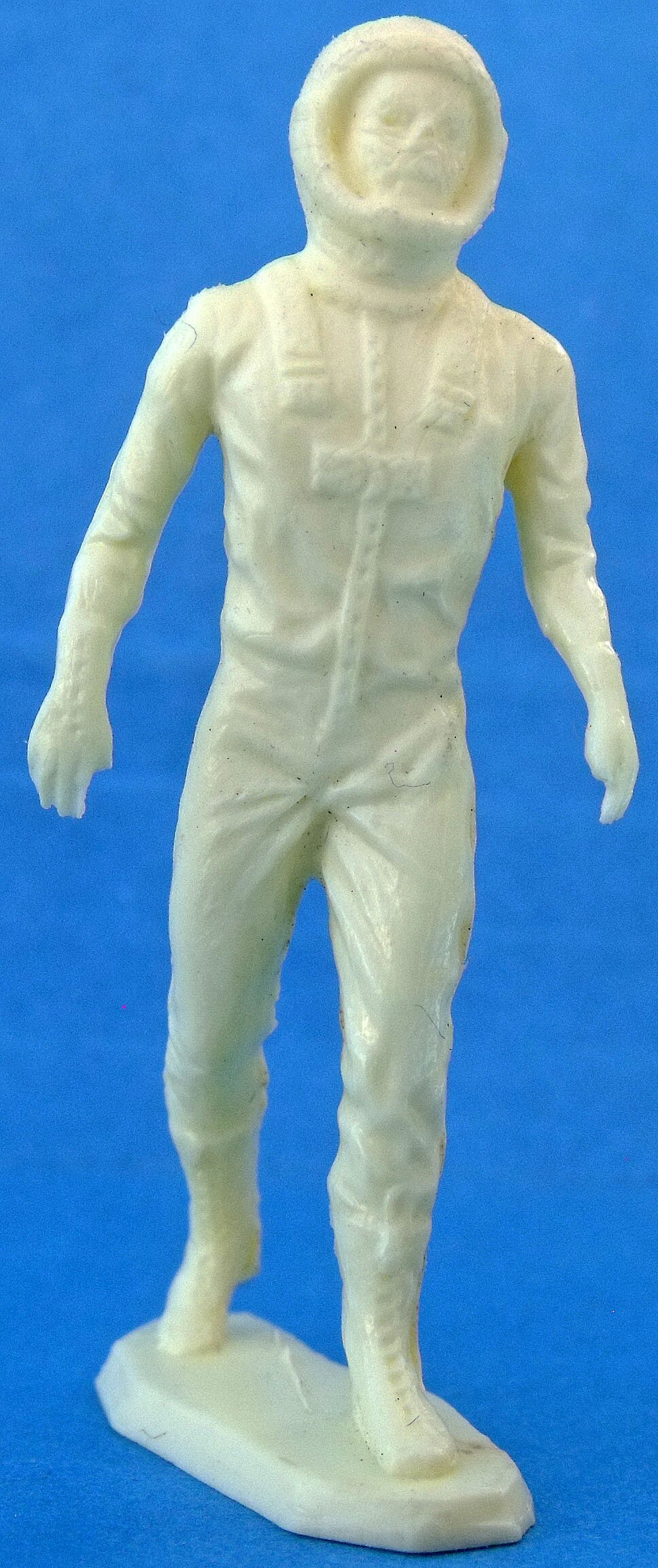 |
| 21. Traffic controller, seated | 22. Emergency crewman with fire extinguisher | 23. Ground crew with fuel hose | 24. Pilot, walking | 25. Jet pilot in high altitude suit |

| Small Accessories |
Small accessories for airport playsets are plentiful. These came in four groups, including a wide variety of items ranging from small runway lights to airport ground vehicles to a radar tower. The 1960 accessories came in a flat, very deep red and silver plastic; later ones were often red-orange, sometimes in a flourescent shade. Pieces in the blue accessory group, of course, were blue, initially powder blue, but later a lighter, less-attractive light or waxy blue.
Searchlight Group
Besides the tall searchlight tower and ground equipment, this group included an operating baggage conveyor. The crank and rollers for it came as part of the Secondary Accessory Group below. The conveyor belt appears to be a wide rubber band.
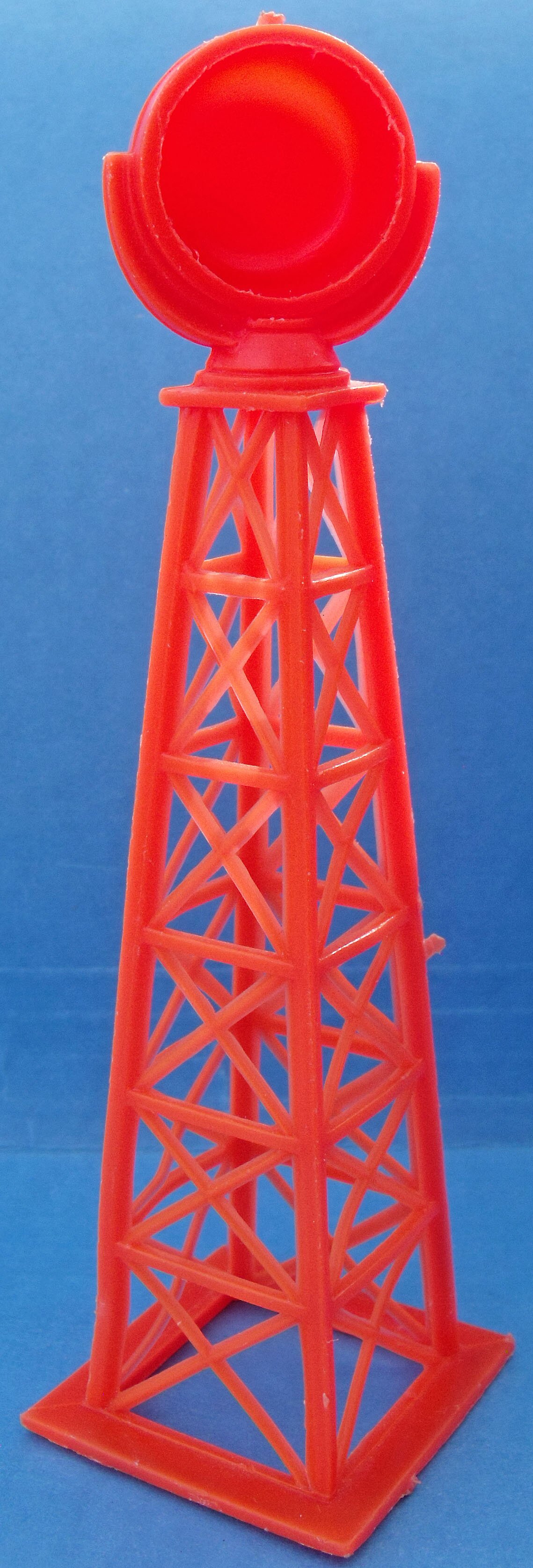 |
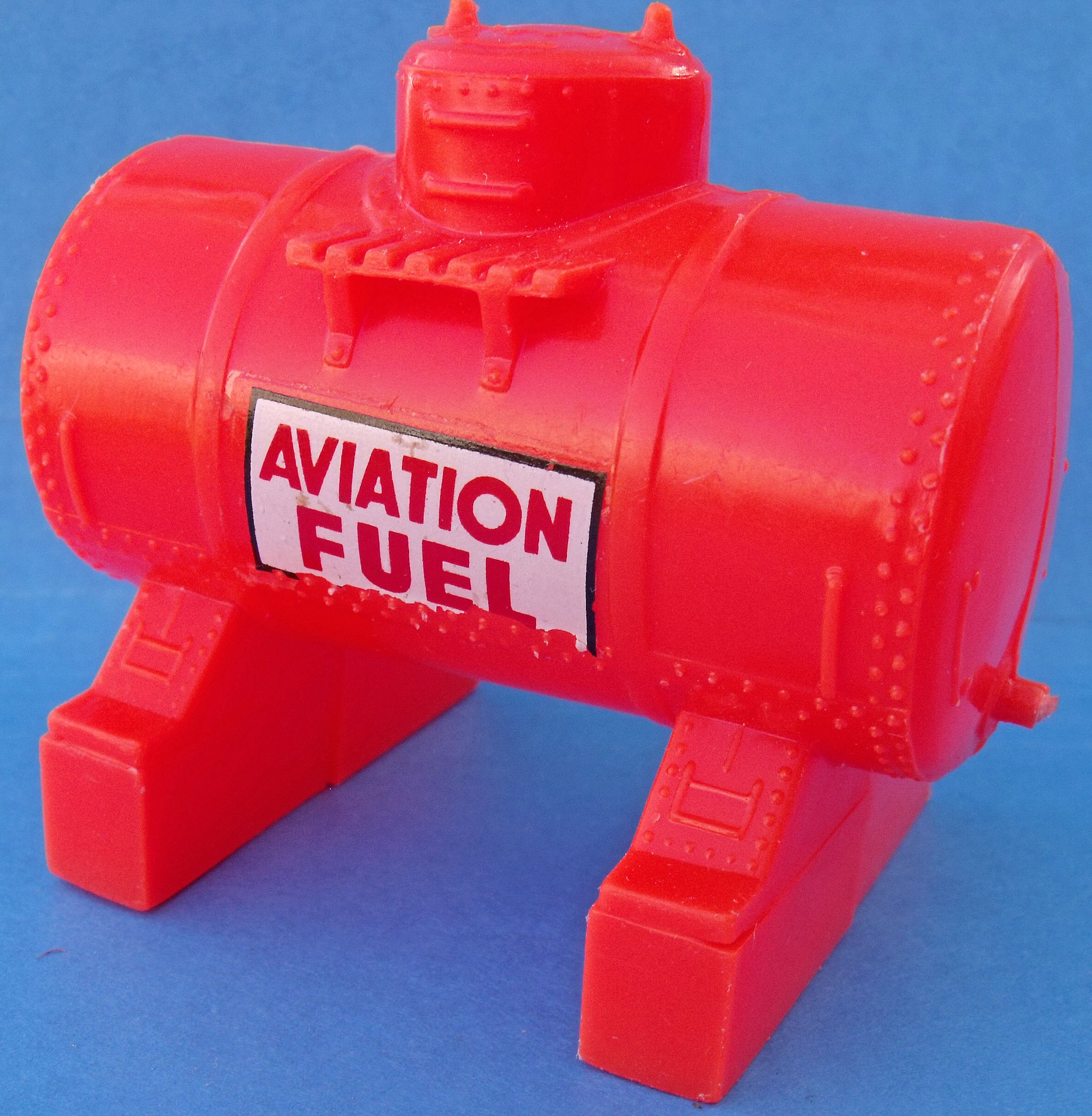 |
 |
| 1. Searchlight tower 5-1/4 inches tall, shown slightly smaller in scale than other accessories |
2. Fuel stand 3 inches wide |
3. Boarding stairs 1-3/8 inches tall |
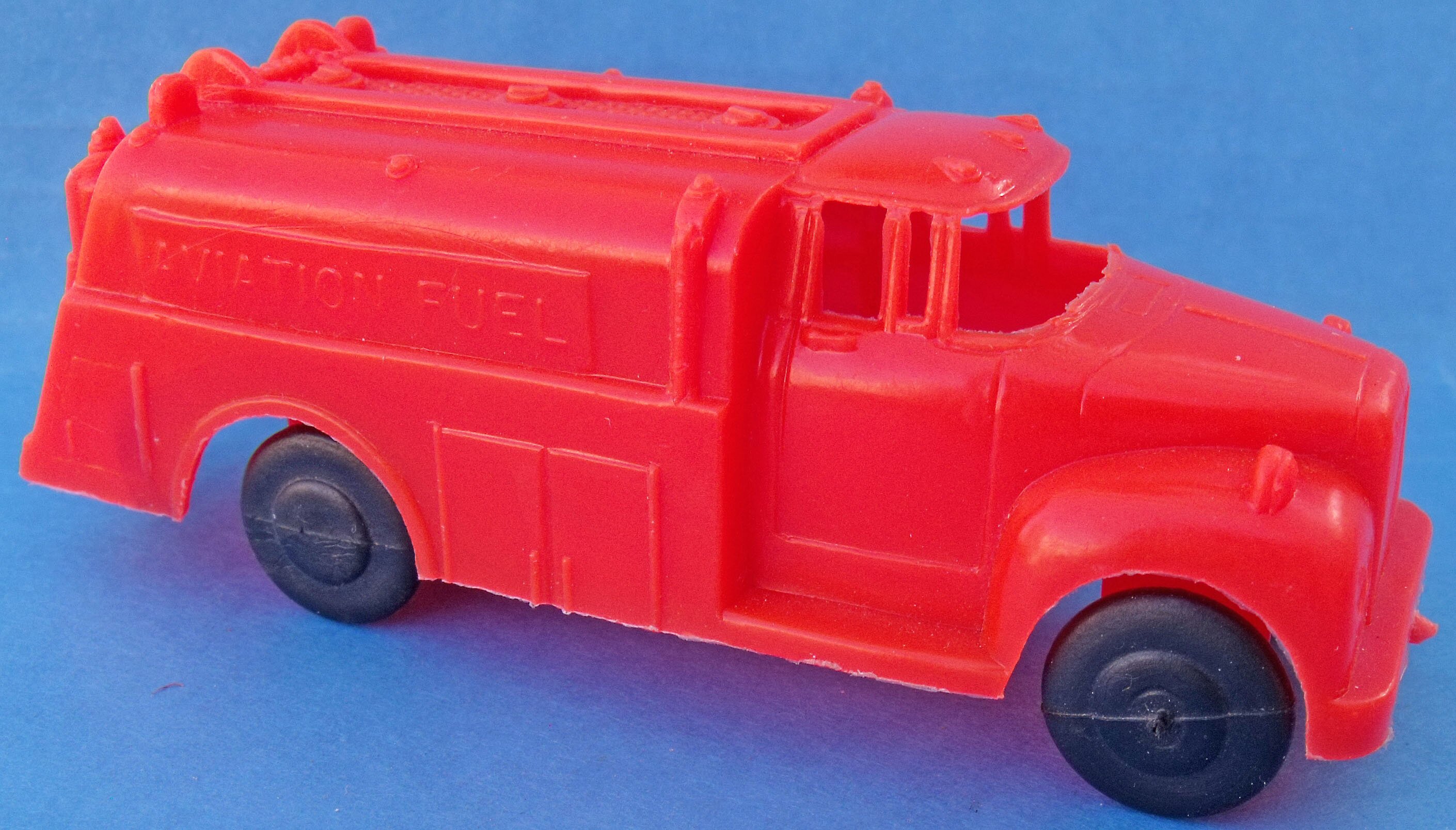 |
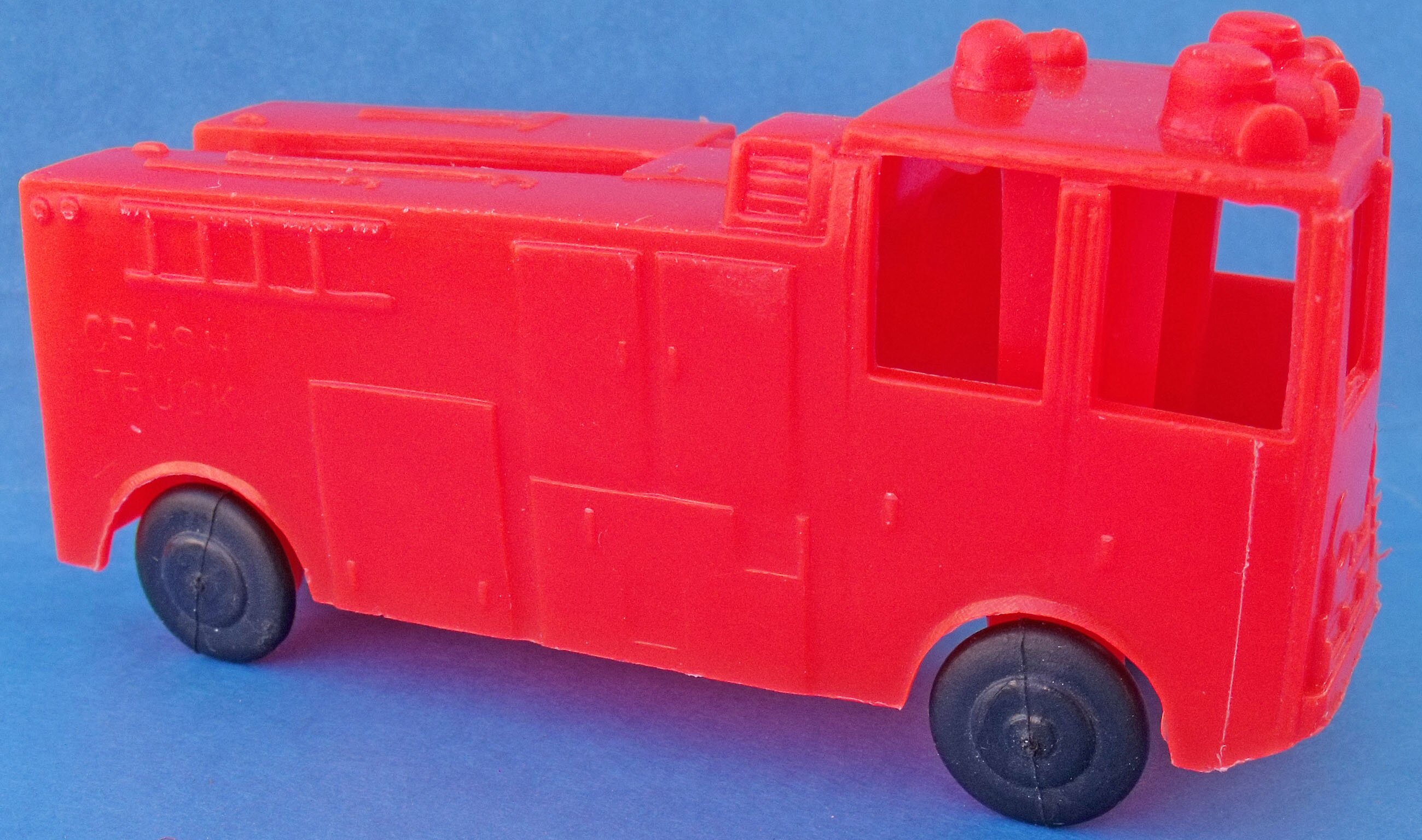 |
| 4. Fuel truck 4 inches long |
5. Crash truck 4 inches long |
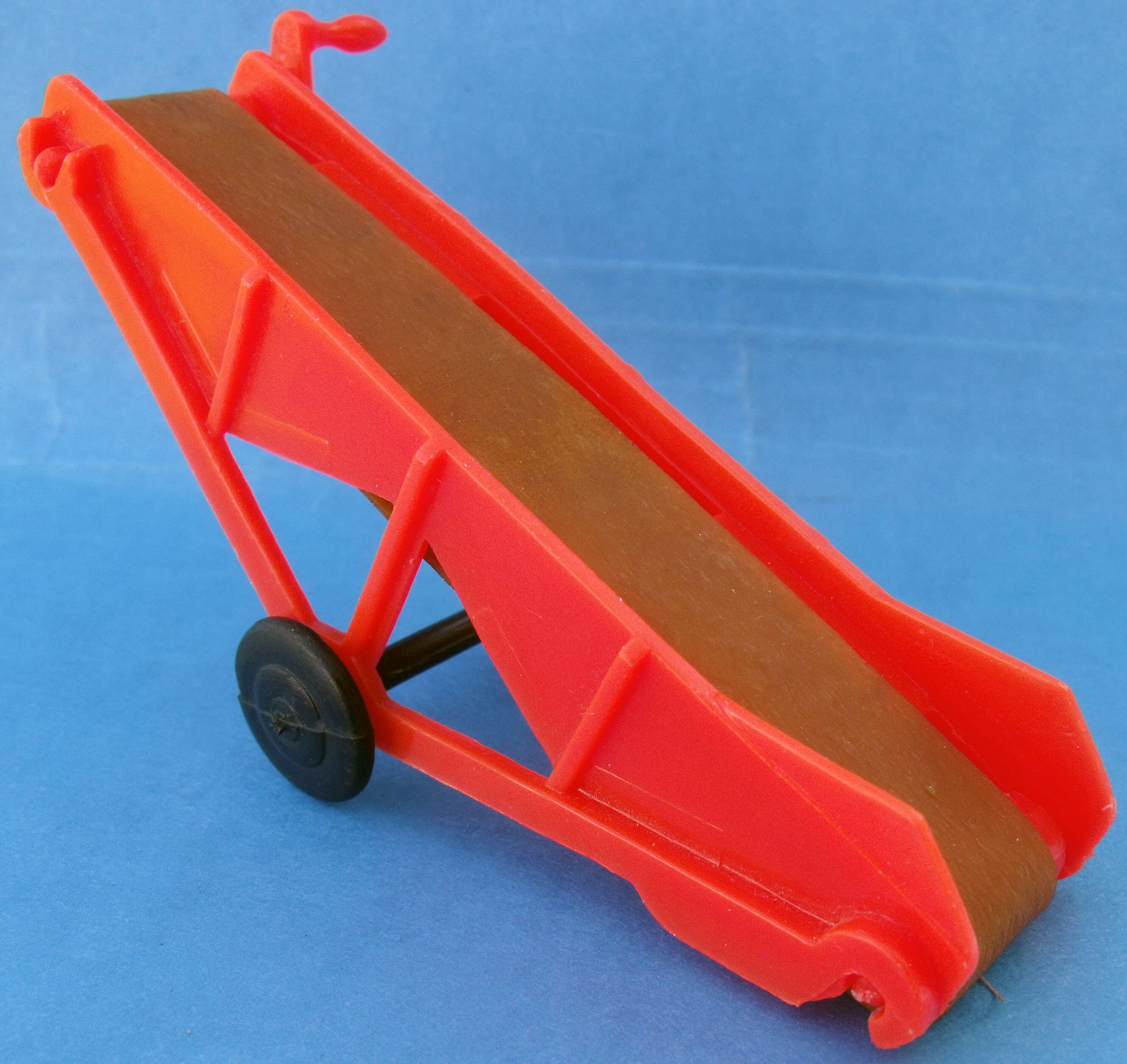 |
| 6. Multi-piece conveyor 3-1/4 inches long |
Radar Group
This group includes the radar tower, a forklift, and a 4-piece baggage train. It also has a second boarding ramp and other ground equipment.
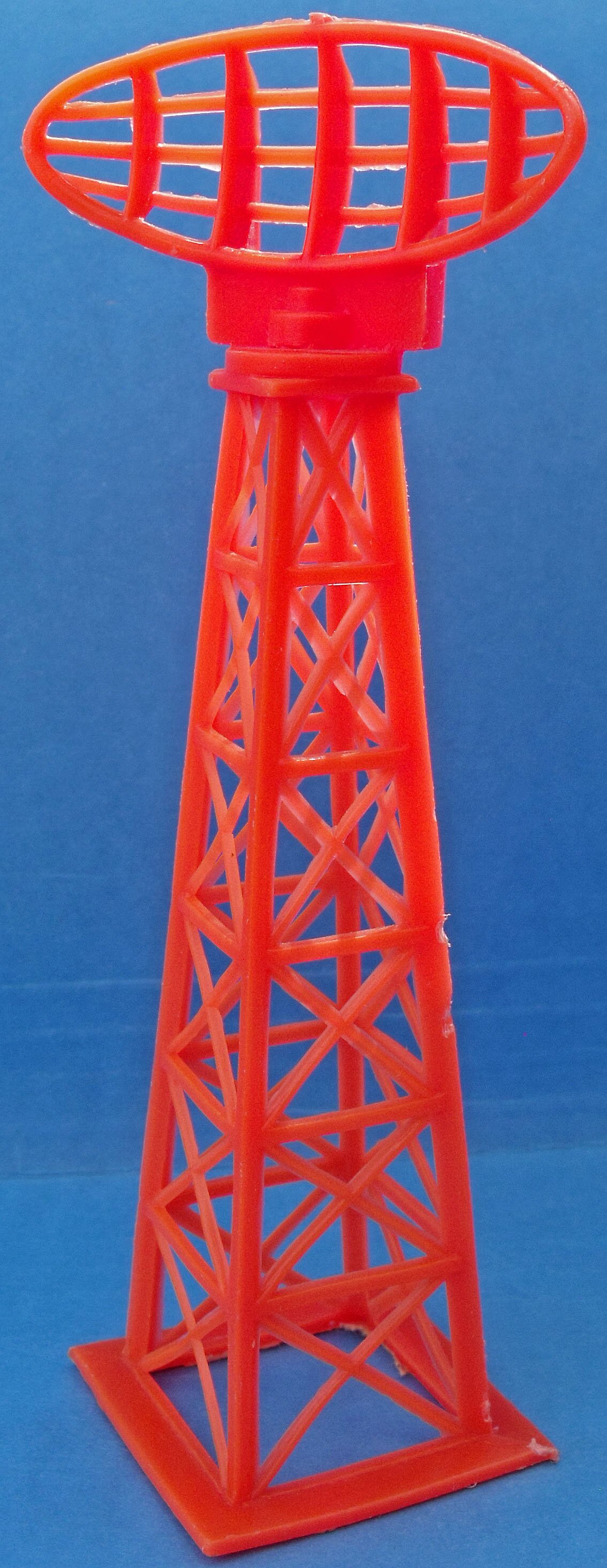 |
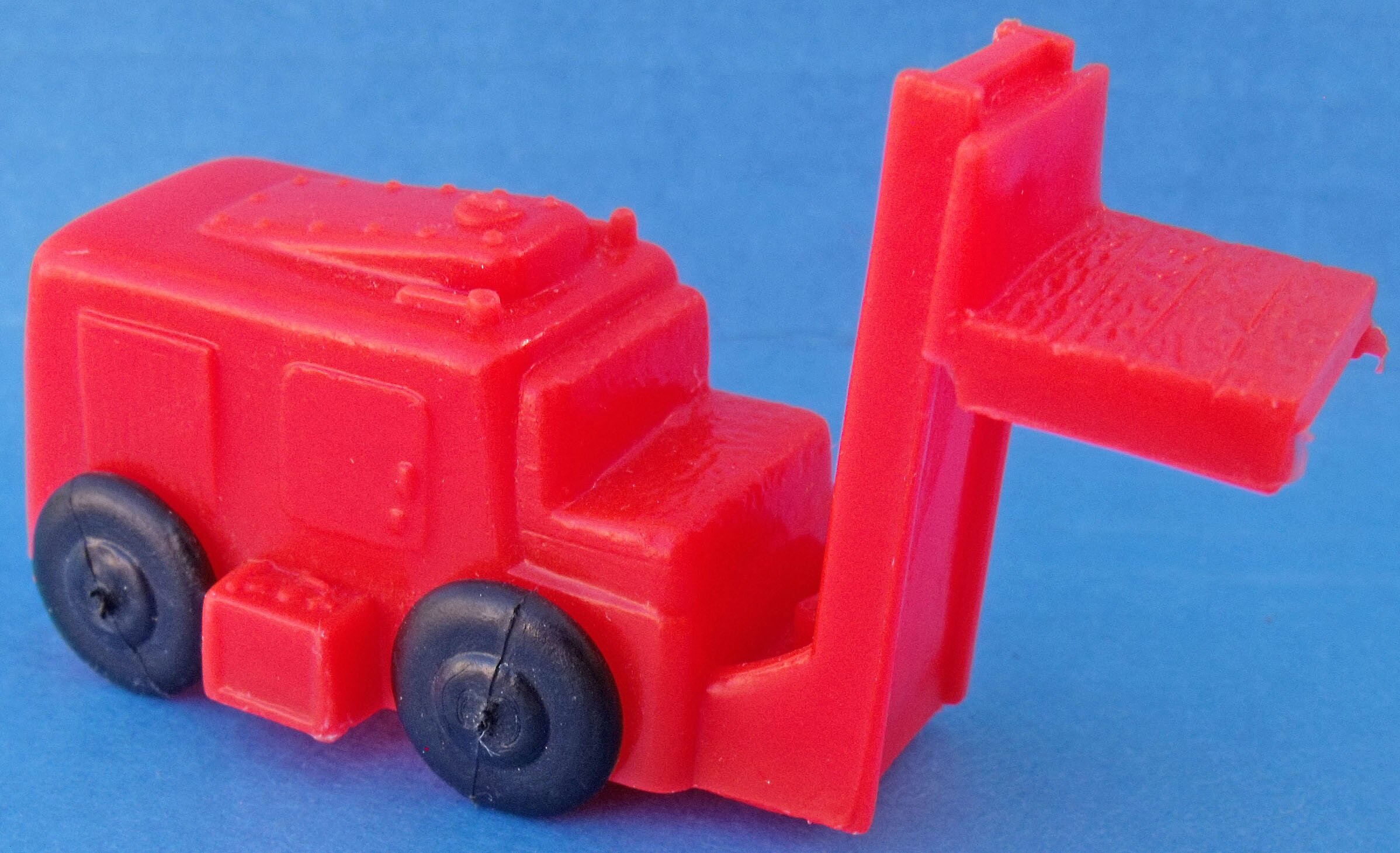 |
 |
| 1. Radar tower 5-1/4 inches tall, shown slightly smaller in scale than other accessories |
2. Forklift 2-1/2 inches long |
3. Boarding stairs 1-3/8 inches tall |
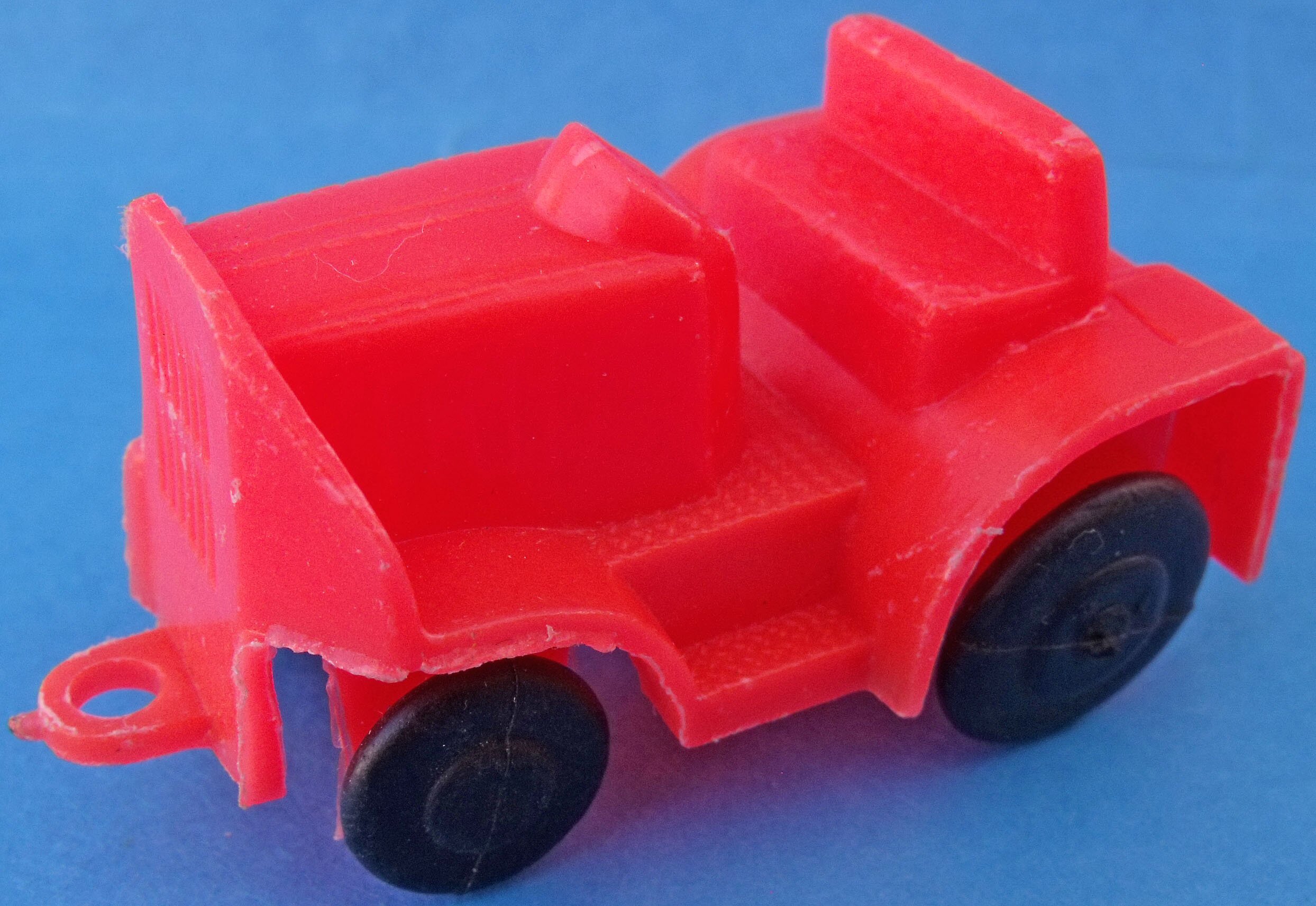 |
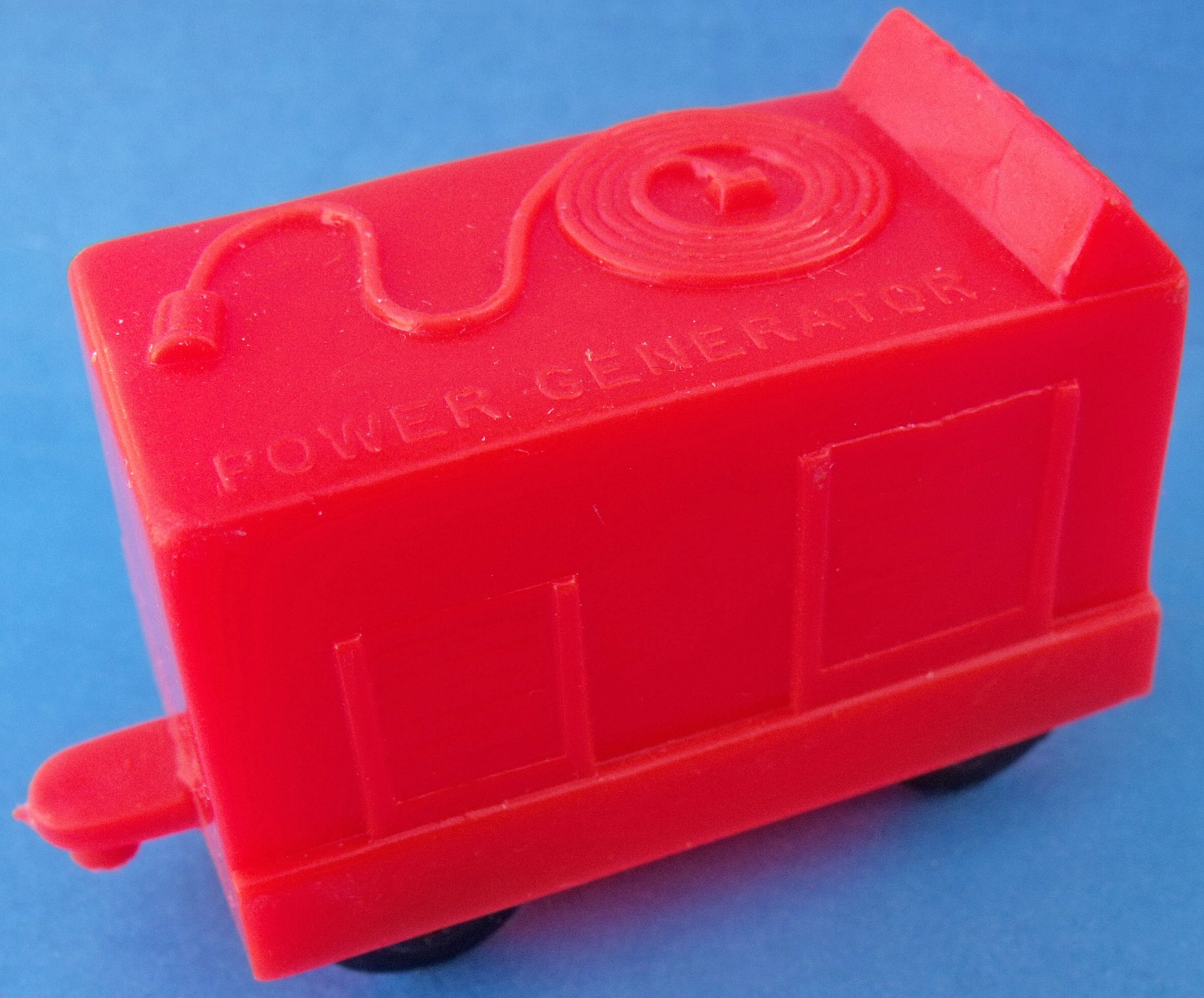 |
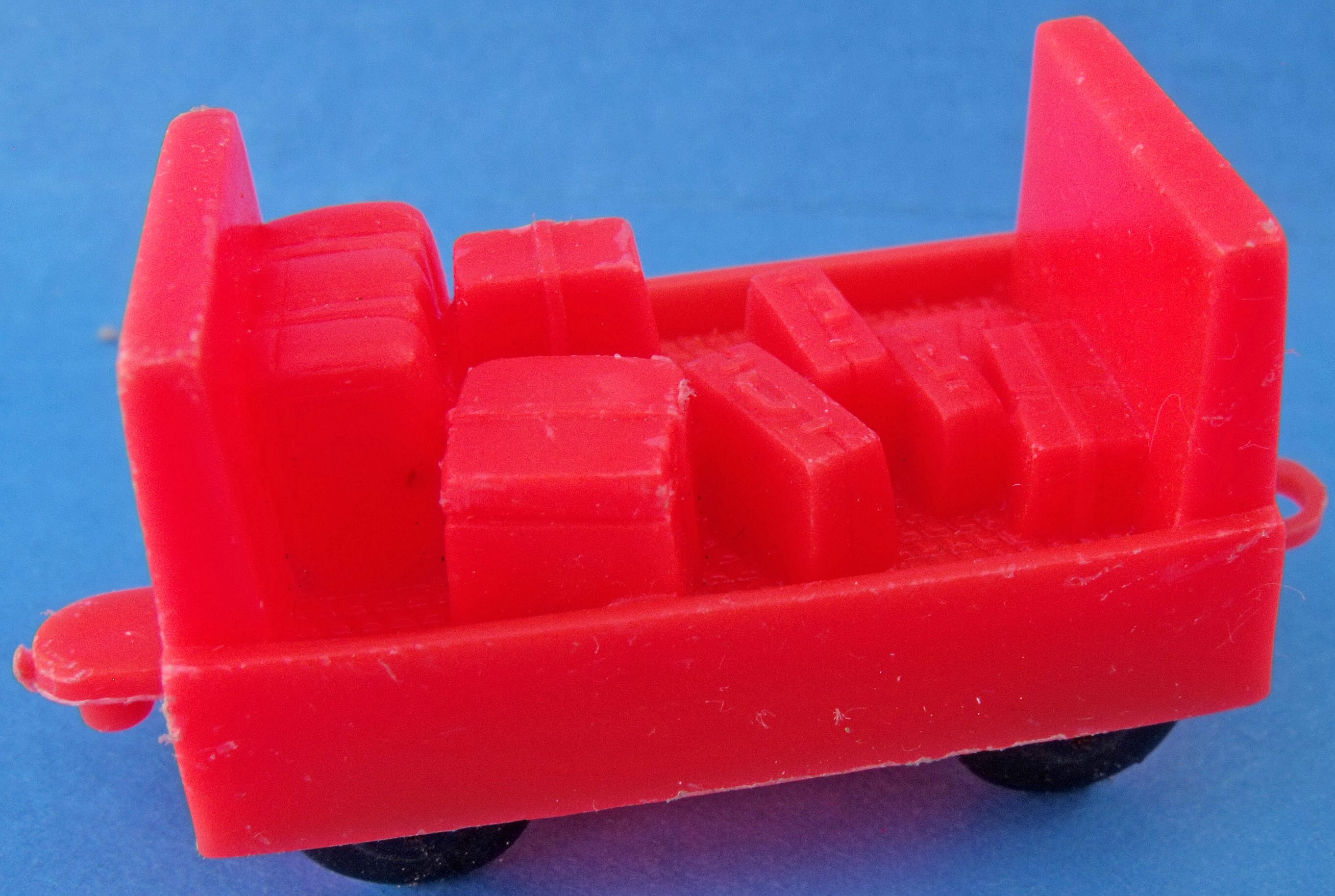 |
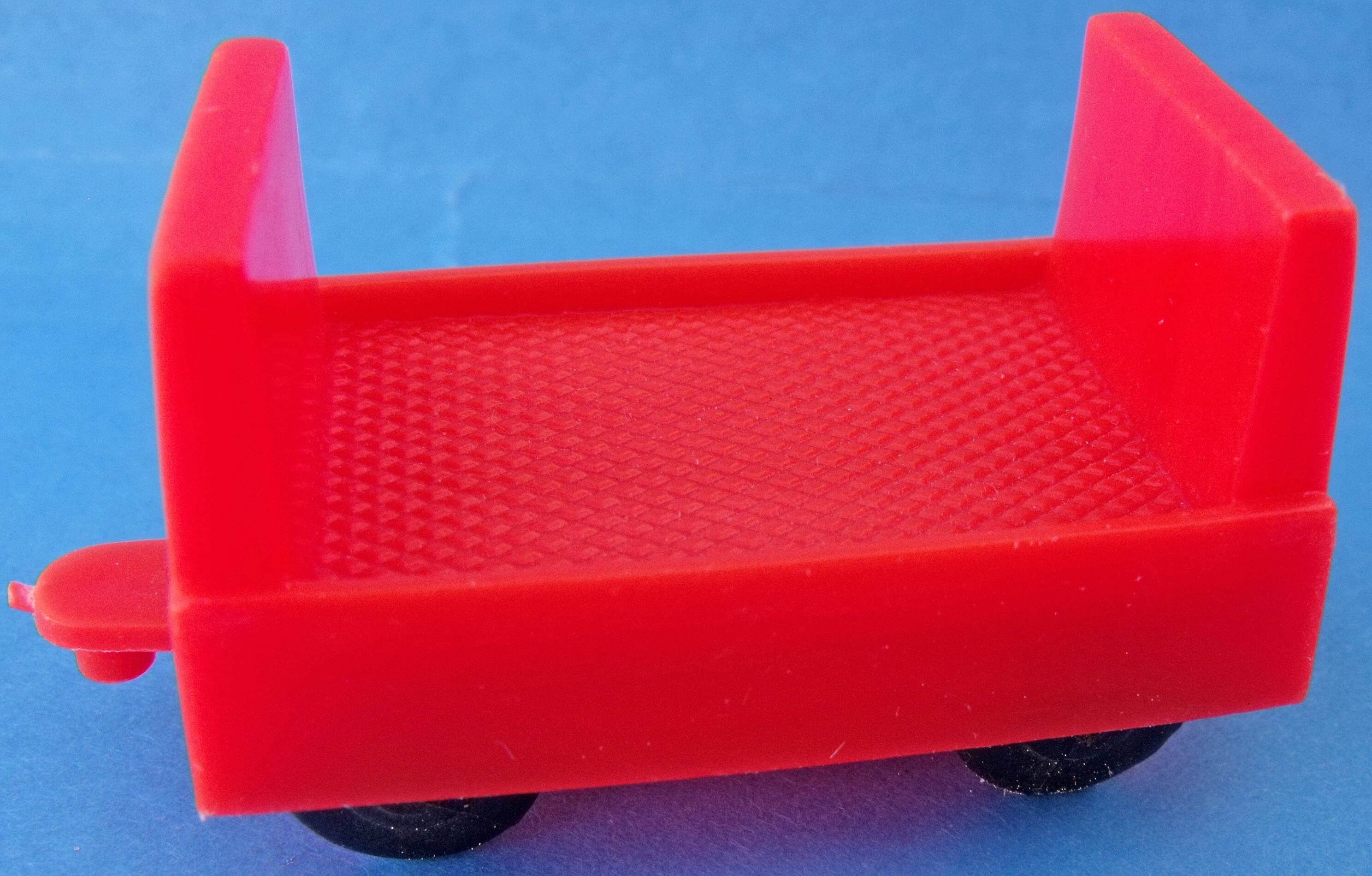 |
| 4. Tractor 2-1/2 inches long |
5. Portable generator 2-1/2 inches long, but taller than the tractor as shown |
6. Loaded luggage cart 2-1/2 inches long |
7. Empty luggage cart 2-1/2 inches long |
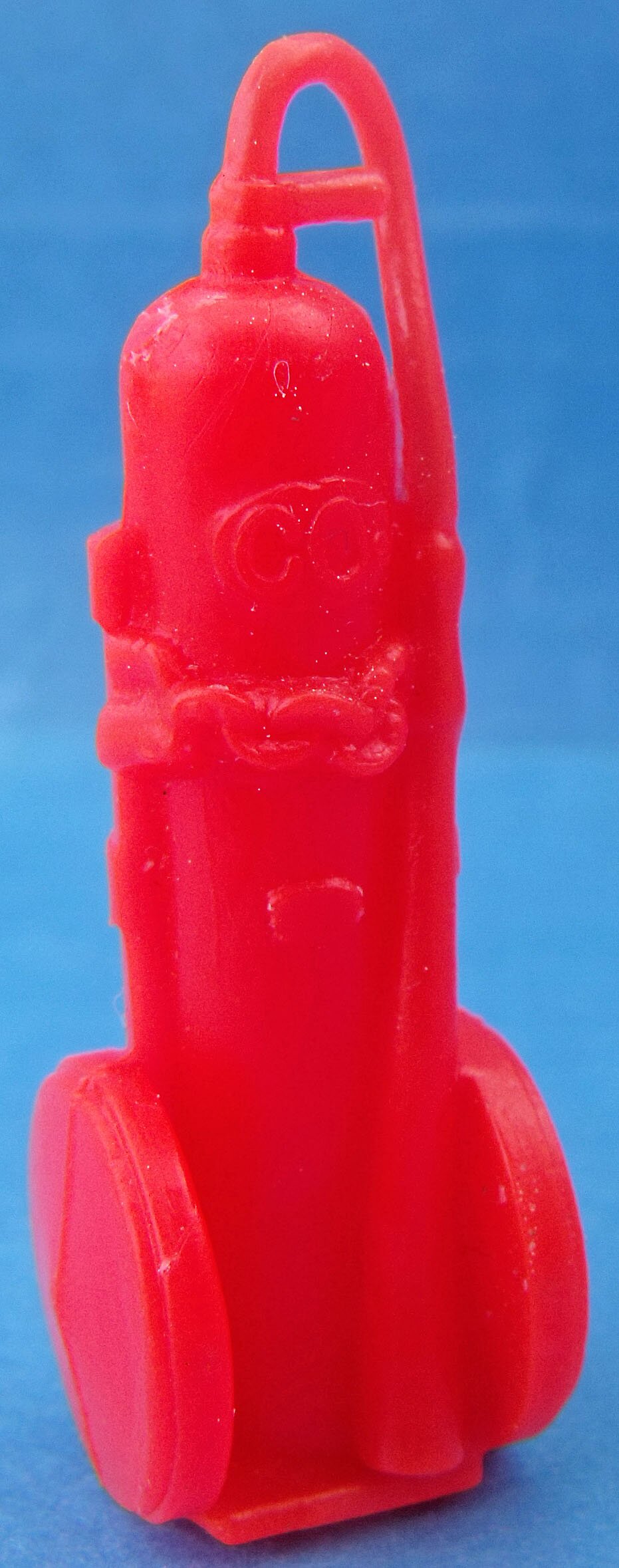 |
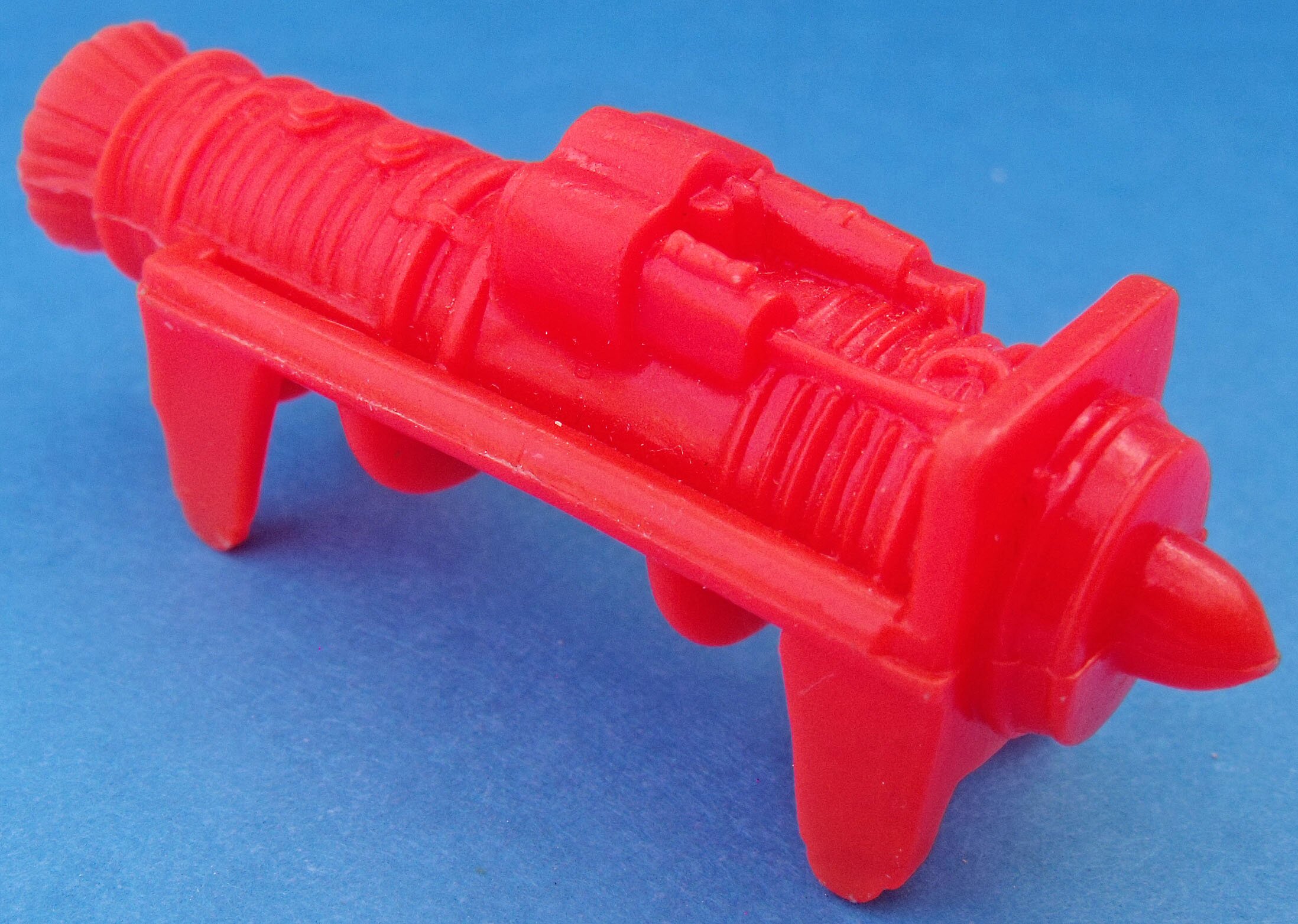 |
|
| 8. Aircraft ladder | 9. Fire extinguisher 1-1/2 inches tall |
10. Engine on stand 2 inches long |
Secondary Accessory Group
I have no idea why this little group is called Secondary, but it includes several smaller items on a sprue. The sprue included 10 tiny runway lights, three pieces of luggage, two crates, a 2-piece wind vane, and a hand crank and roller that were part of the baggage conveyor in the Searchlight Group. The conveyor with the crank and rollers attached can be seen as part of the converyor above.
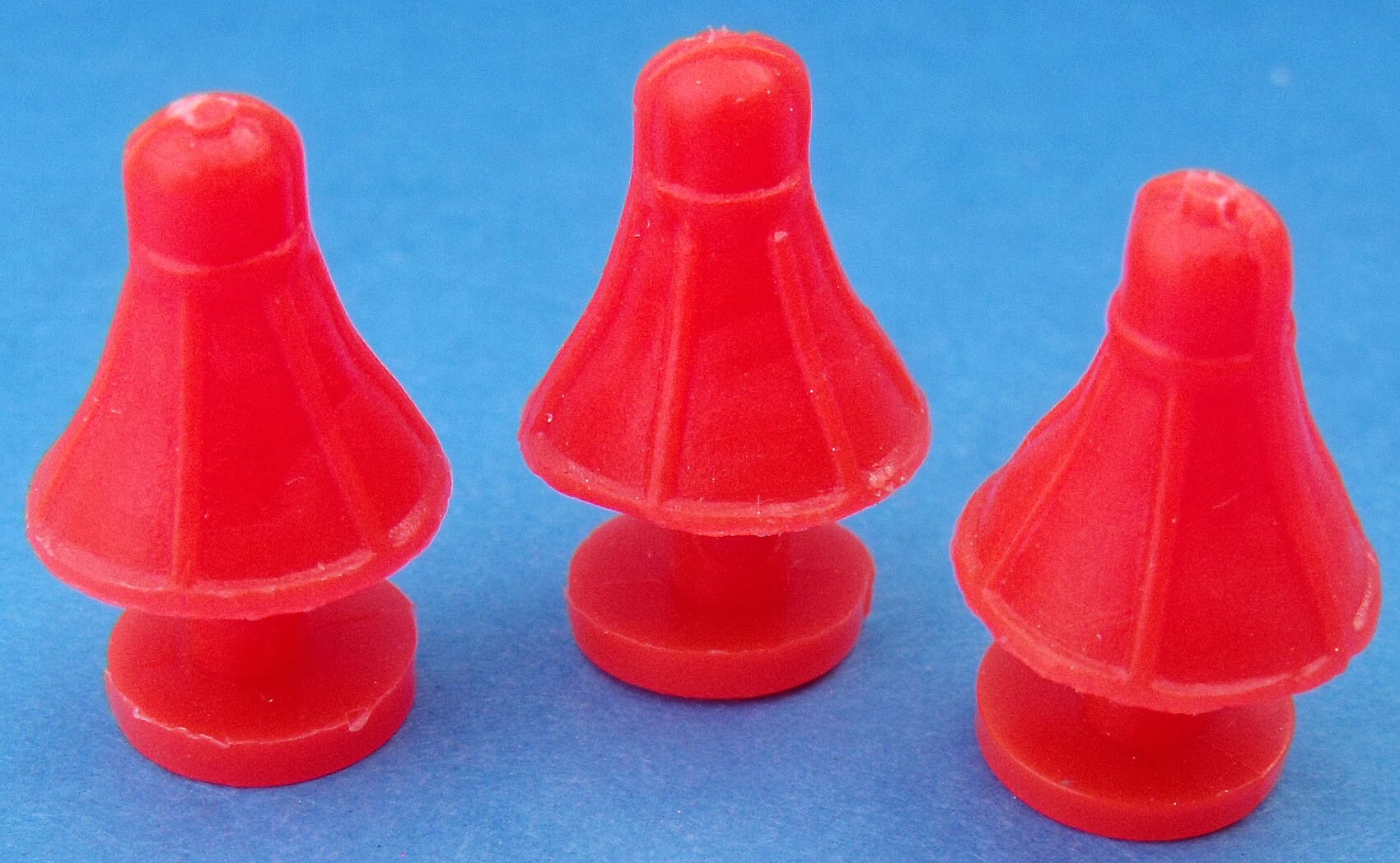 |
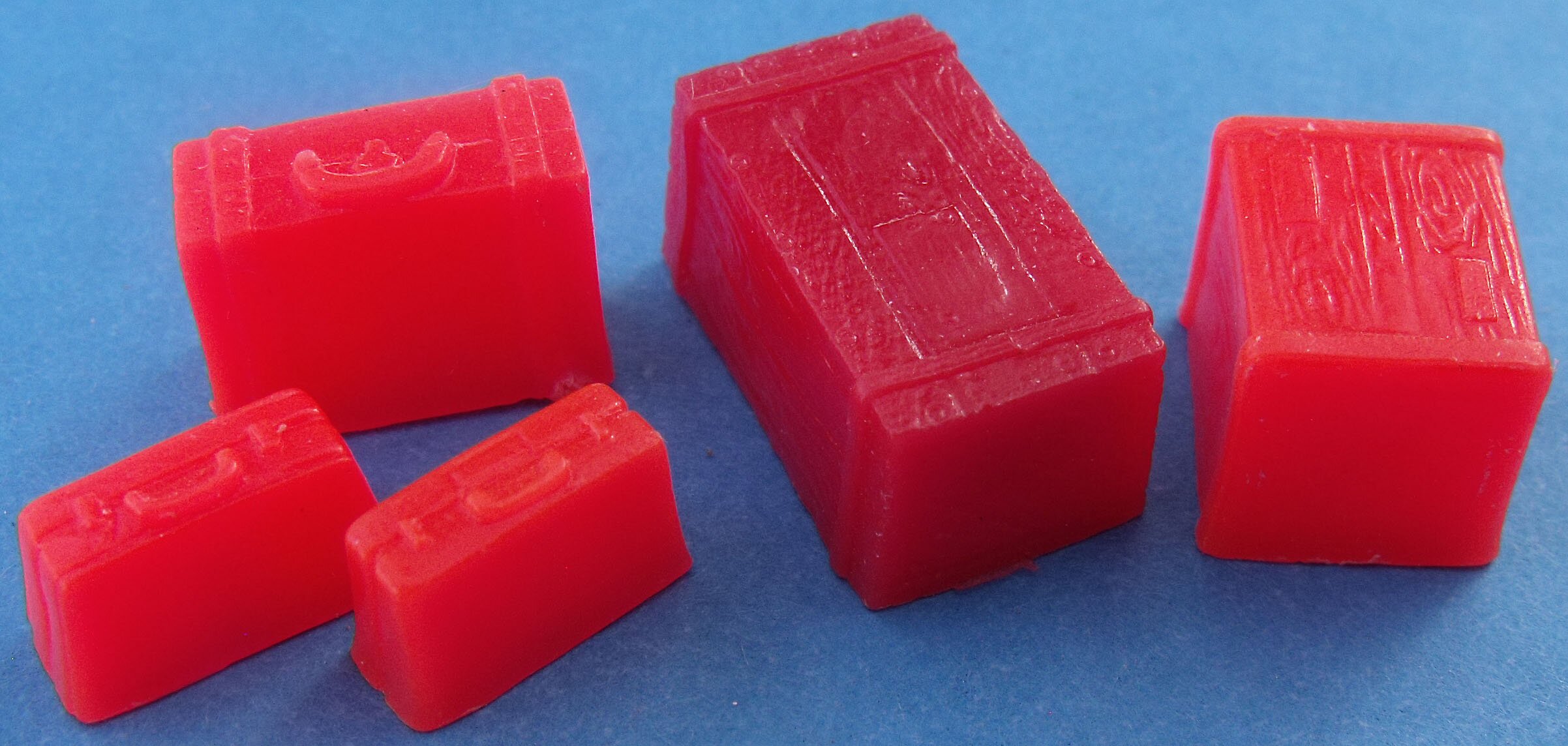 |
| Runway lights 5/8 of an inch tall |
Luggage and crates These are tiny pieces; the brief cases in front are 3/8 of an inch by 1/4 of an inch. The crate in the middle is the early deep red color; others are the red-orange. |
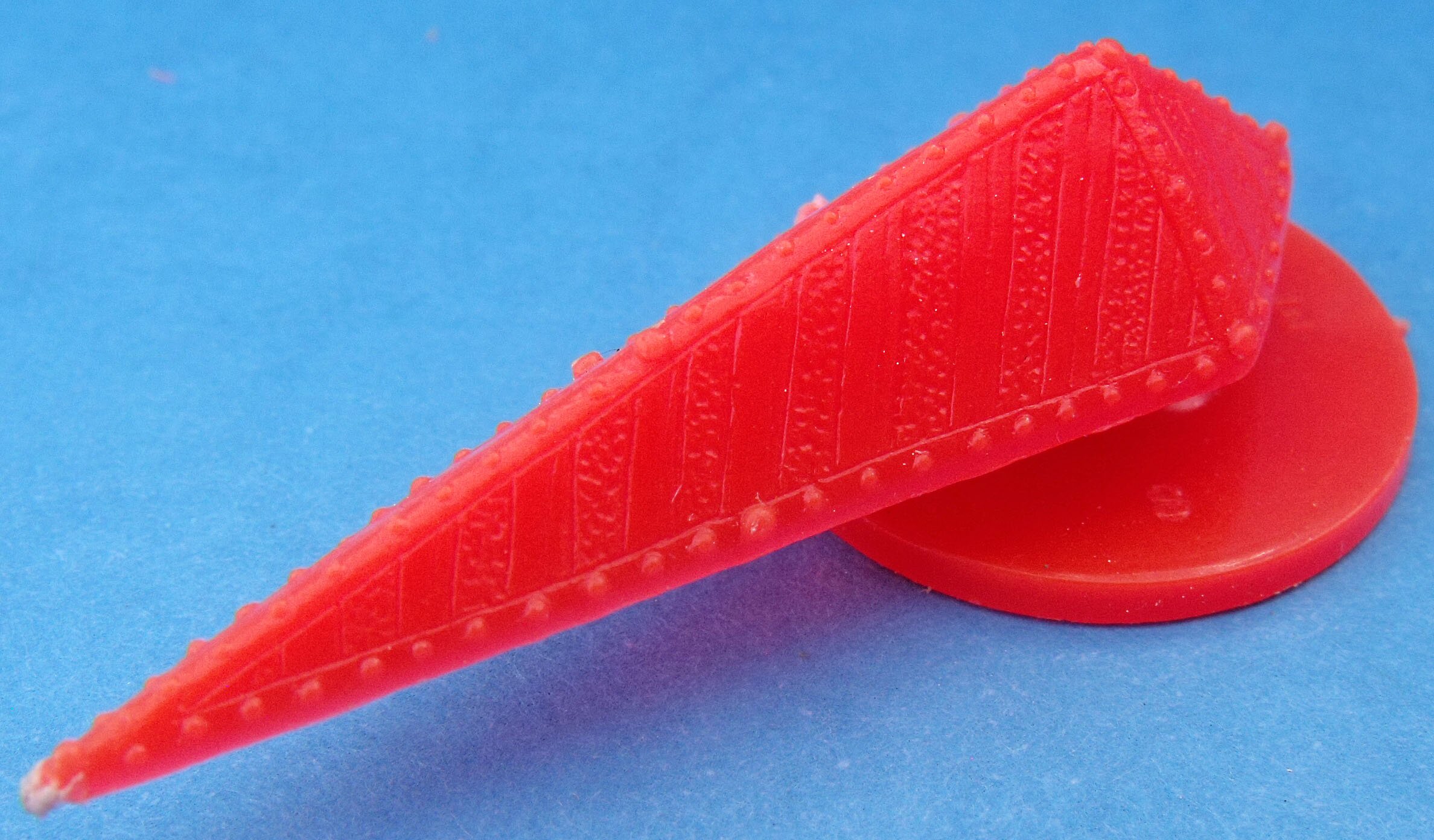 |
| 2-piece wind vane 2 inches long |
Blue Accessory Group
This group has nine pieces for the blue control tower, the terminal awning, rooftop fronts for the small hangars, and four sections of pipe rail fencing. The fact that these pieces were made in soft plastic rather than hard platic has it pluses and minuses. The plus is that the three components of the control tower fit together rather easily. The minus is that small thin pieces like the tower antennas and pipe rail fence tend to warp. The pipe rail fence was a really nice thought, but it is so small and warped that it looks a bit silly.
The pieces were made in numerous shades of blue.
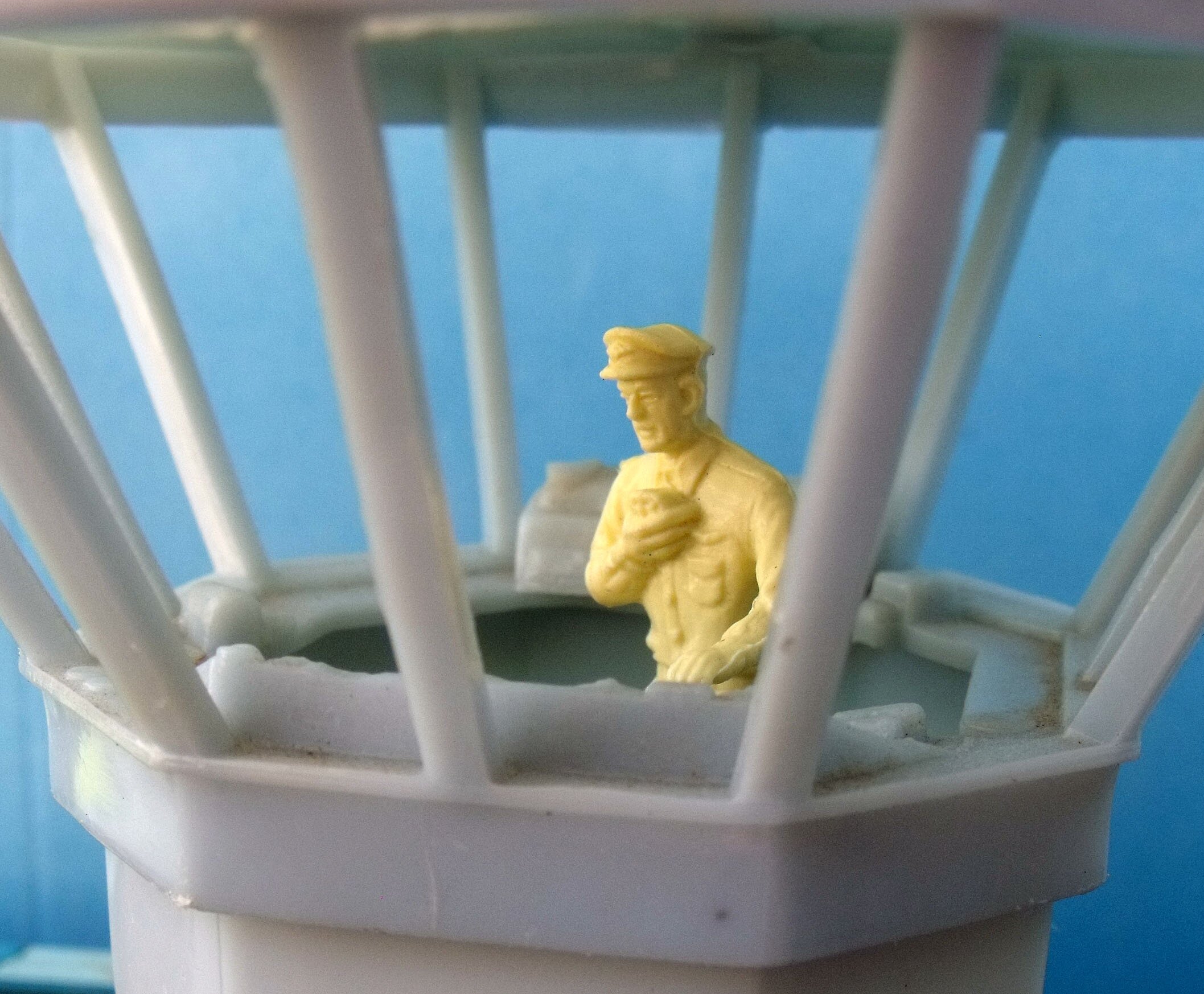 |
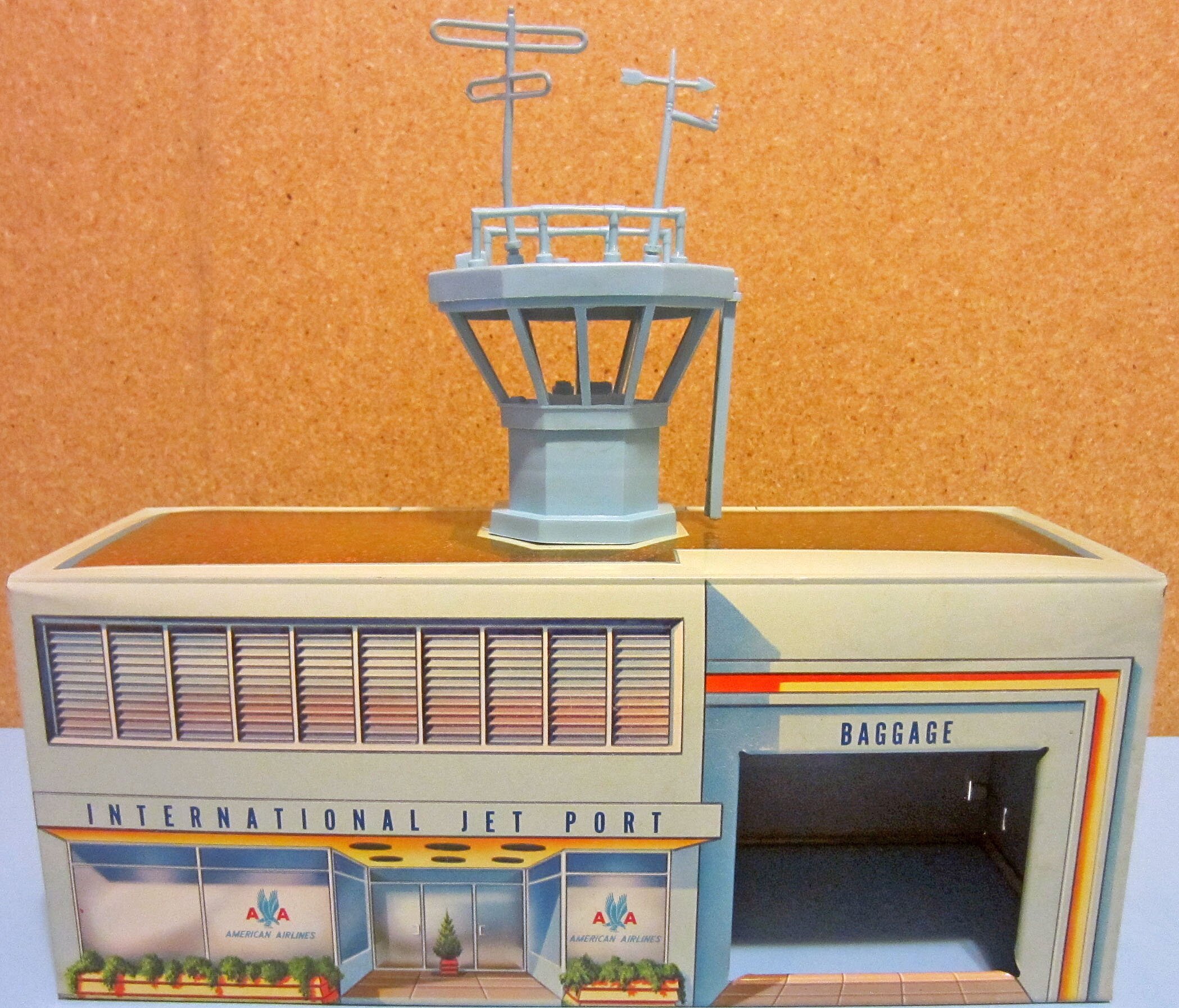 |
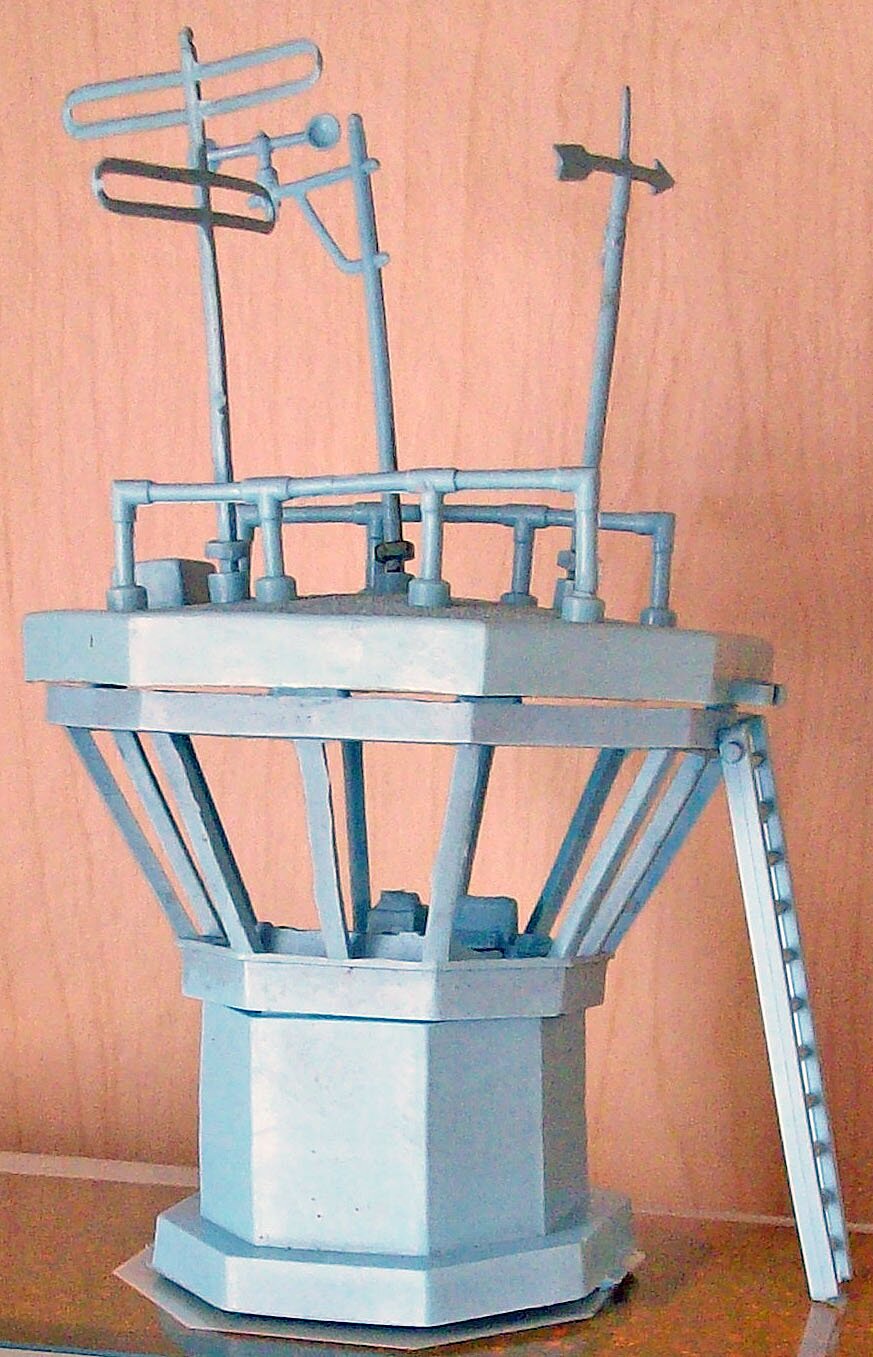 |
| Control tower | Terminal with full control tower on top Photo courtesy of collector Phil Webb |
Close up of control tower Photo courtesy of collector Brad Farrell |
 |
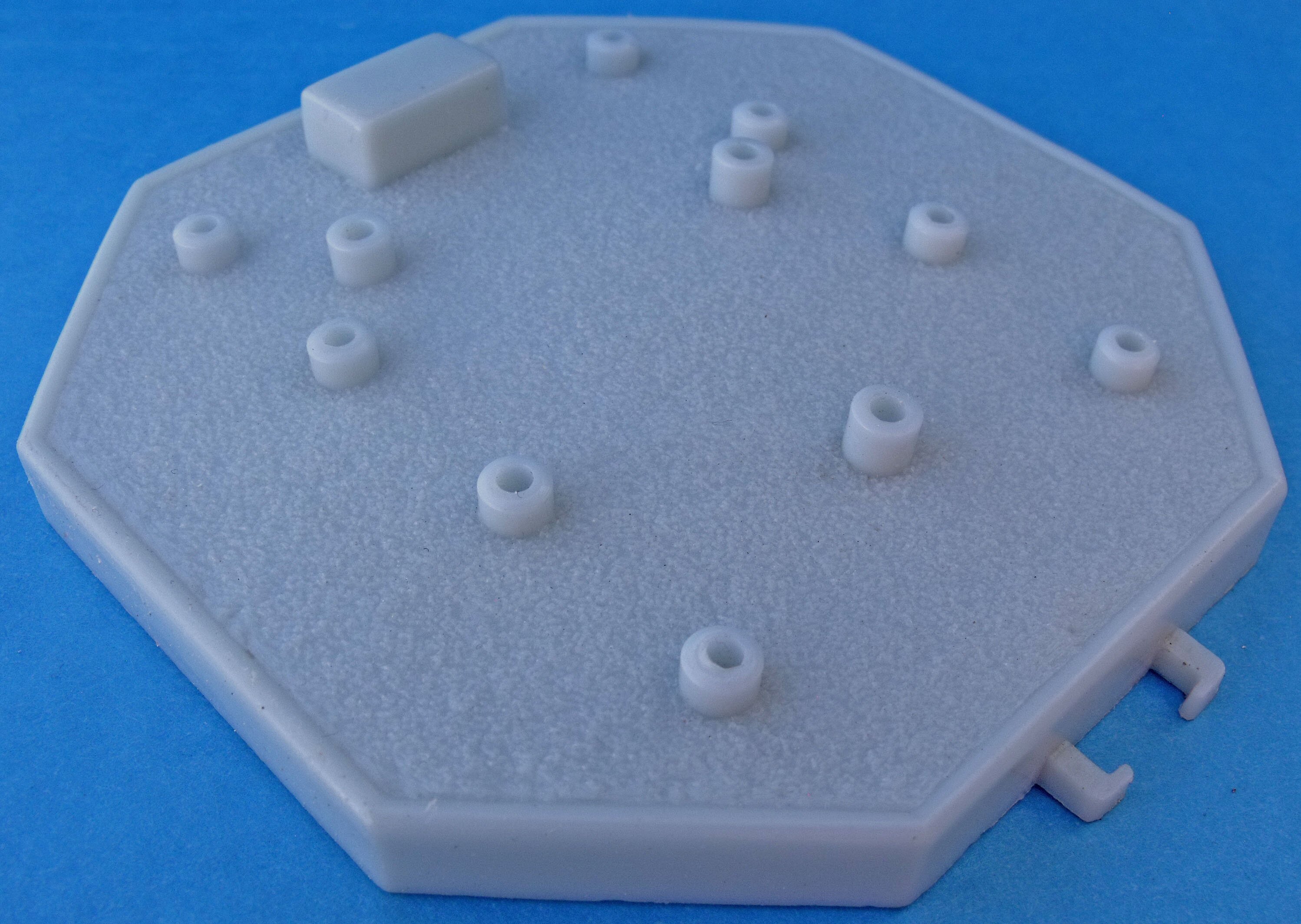 |
| Control tower bases Colors are not true when seen on the computer, but left one is early powder blue and right one is later light blue. |
Control tower roof Roof has four spots each for the two hand railings and one each for the three antennas. The bracket at the front right is to hold the ladder in place. |
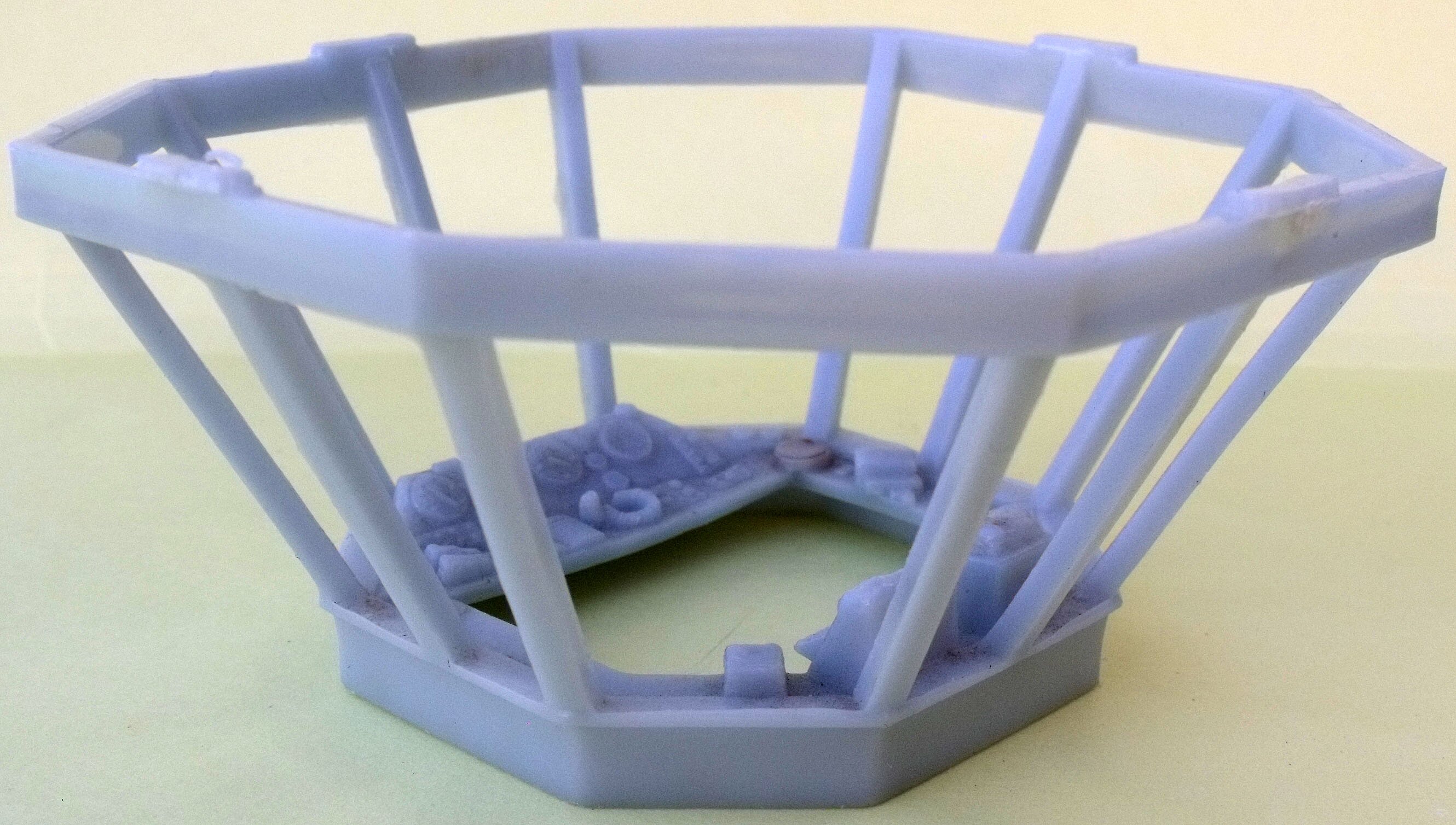 |
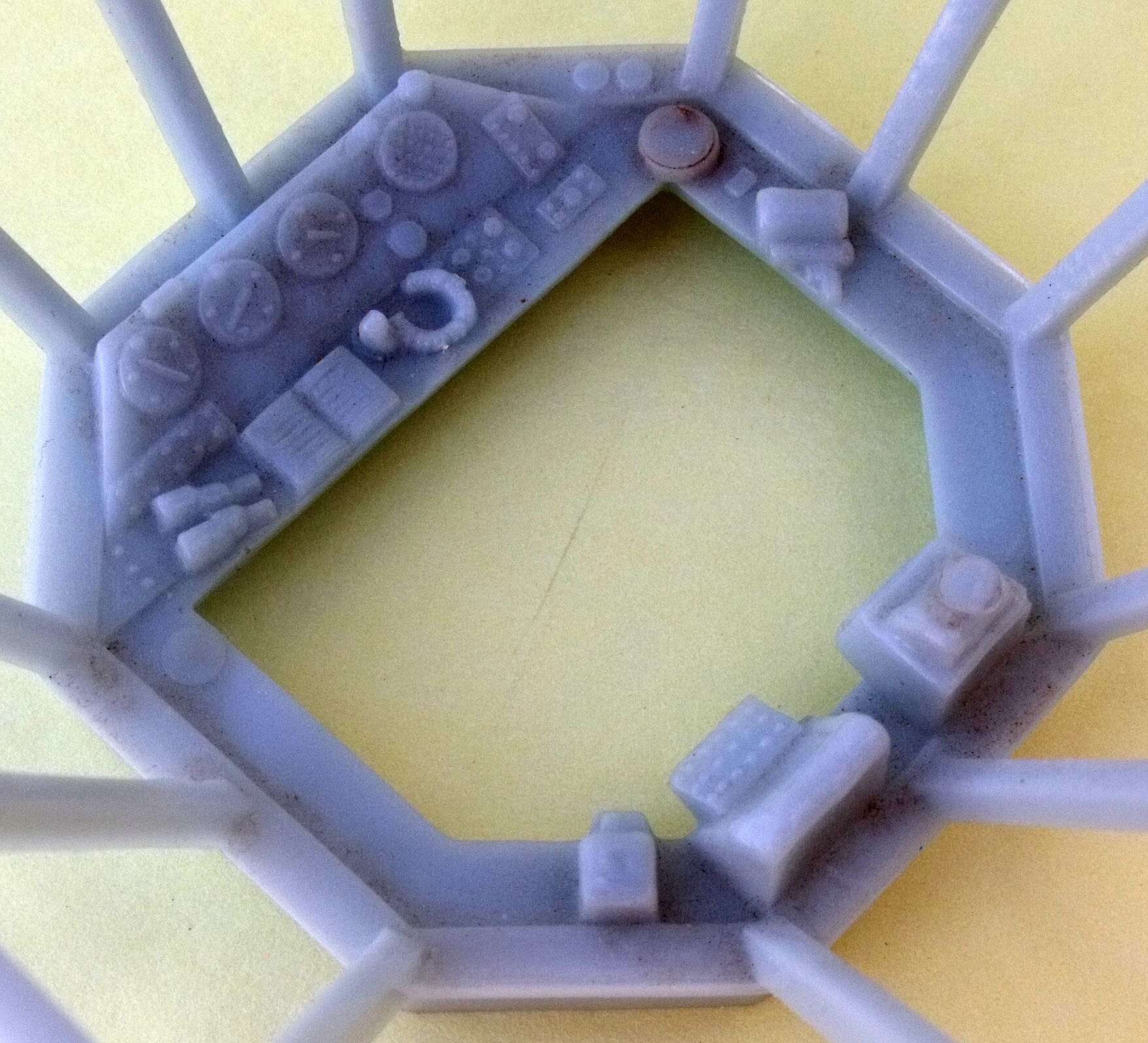 |
| Control tower room | Close up of control tower equipment |
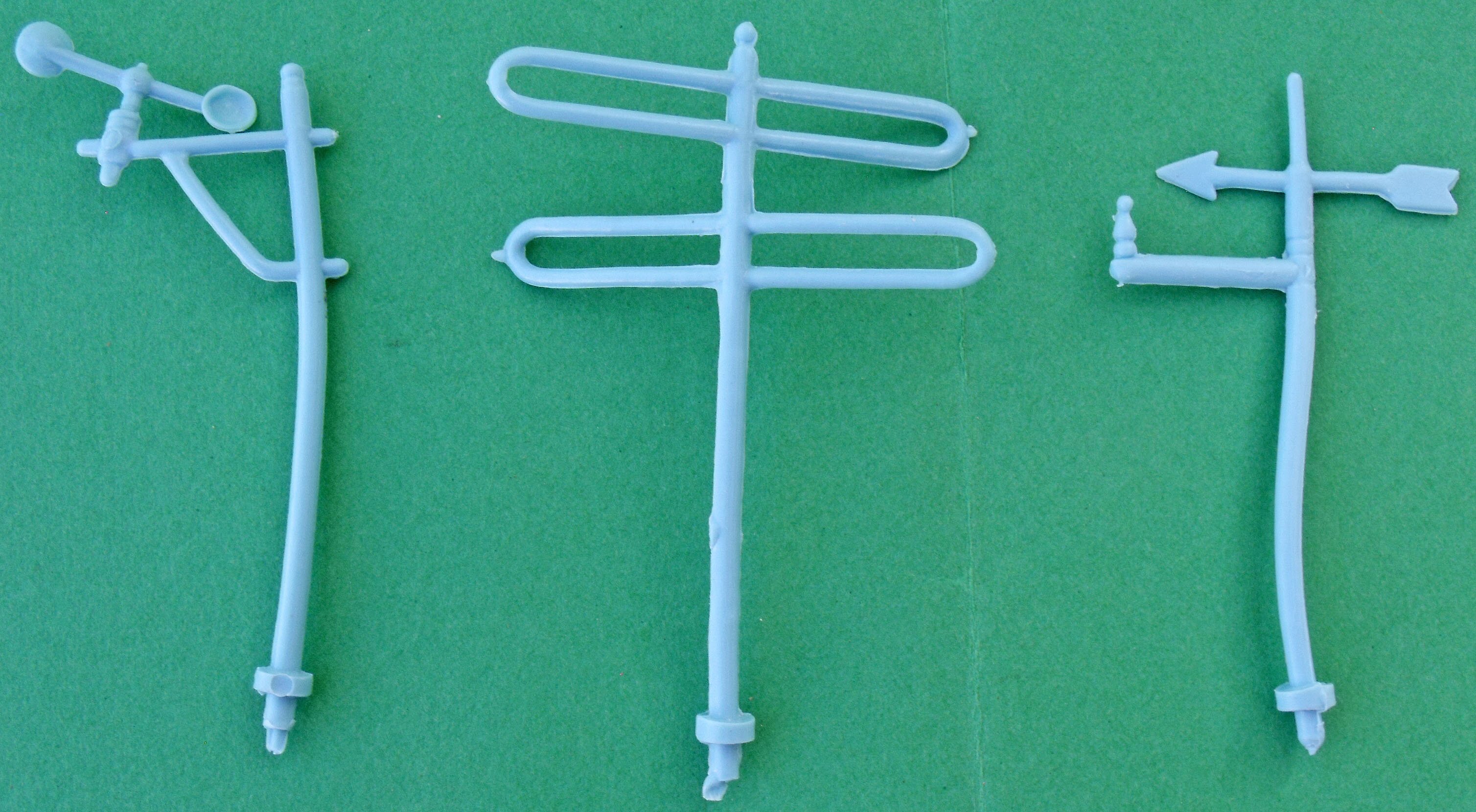 |
 |
 |
| Control tower antennas - wind speed indicator, radio antenna, weather vane 2-1/2 inches tall |
Control tower hand railing Photo courtesy of collector Phil Webb |
Ladder Photo courtesy of collector Phil Webb |
 |
 |
| Terminal awning 4-3/4 inches wide |
Pipe rail fencing 5 inches wide |
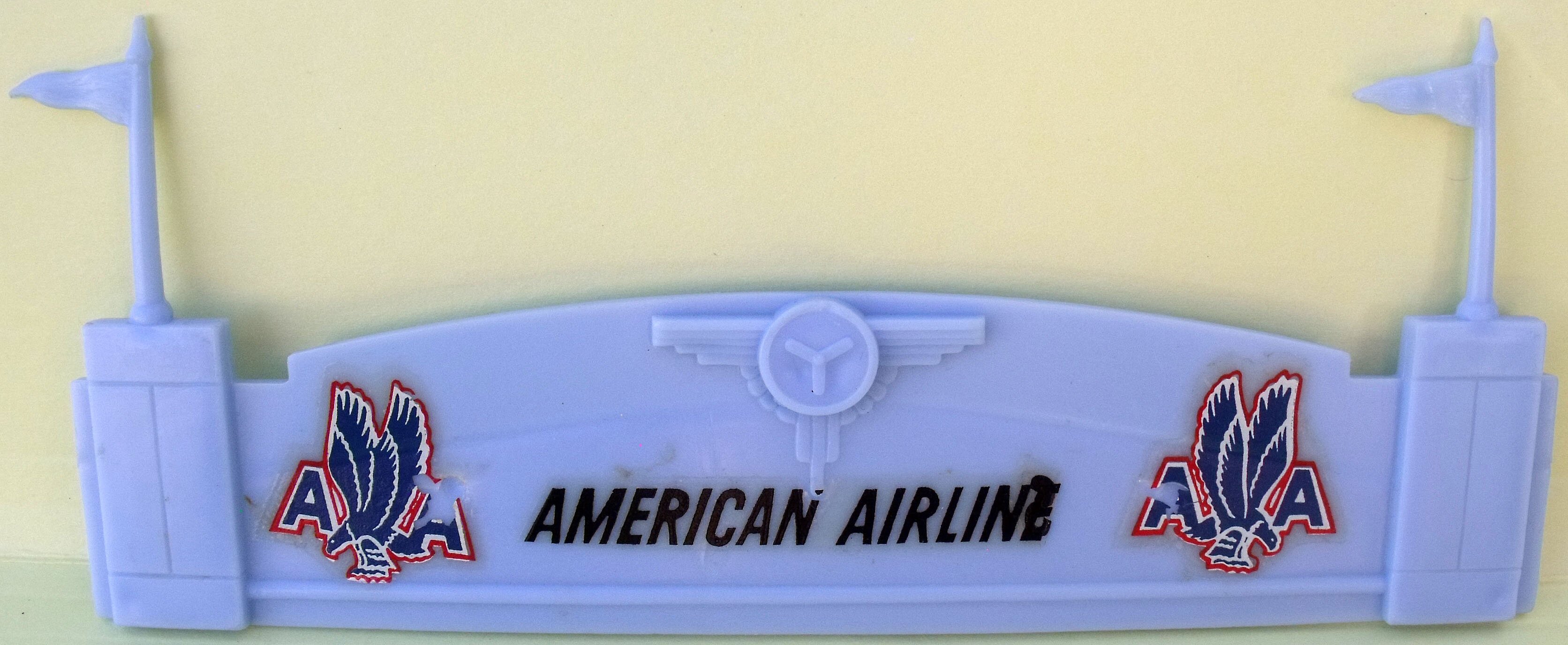 |
| Roof attachment for hangar About 6-3/4 inches wide. See item attached to hangar earlier on this page. |
Other Small Accessories
The sets included few small accessories except for those already described, which were made specifically for the airports. I can find only two items that were also used in other sets. These were 1) an A-style tree that was used in Wild West and several other theme sets and 2) a street light that was used in space exploration sets.
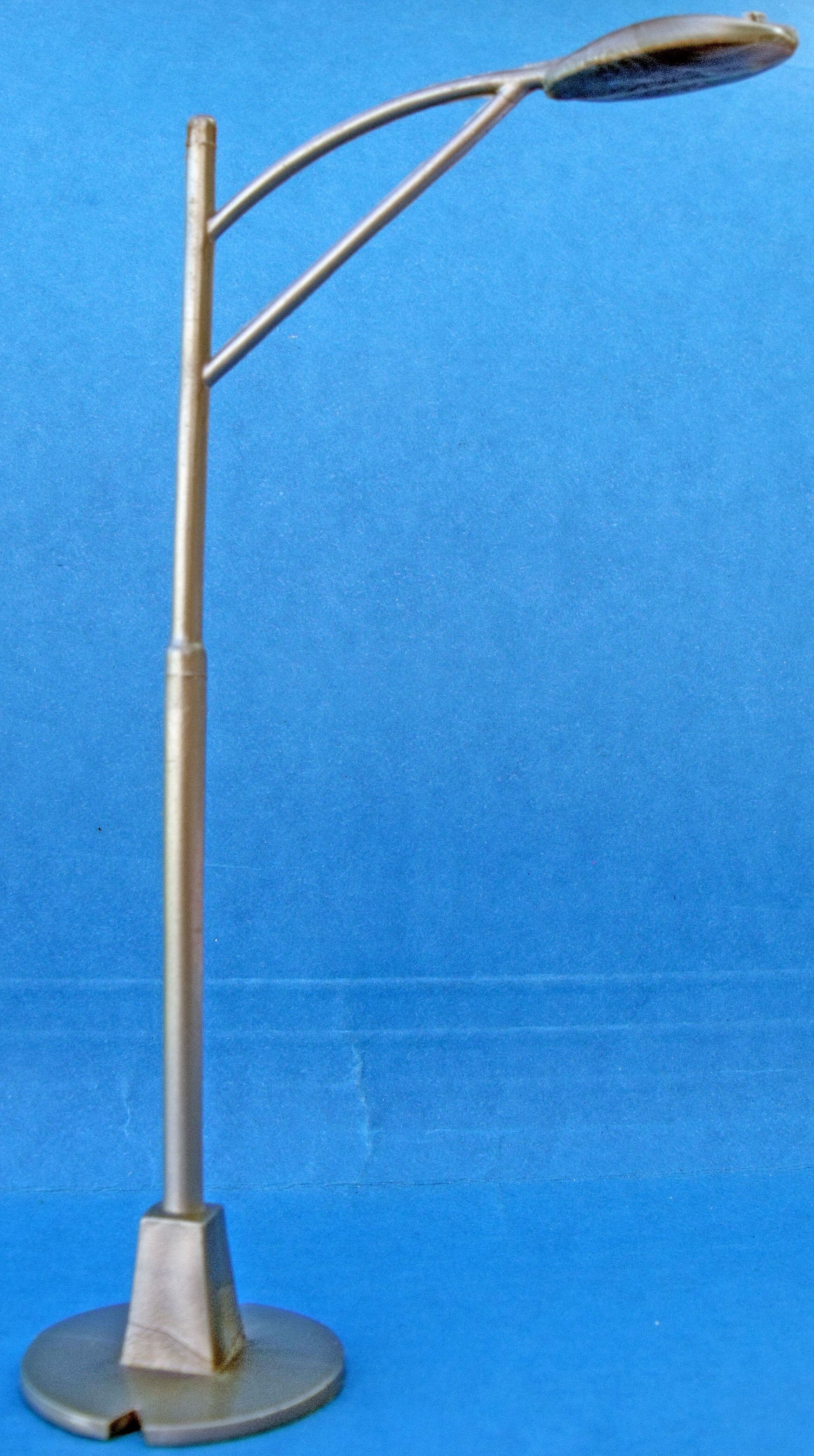 |
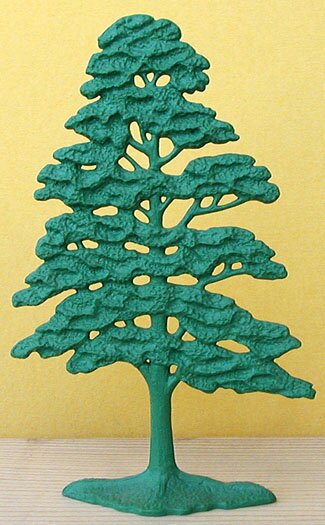 |
| Overhead street light 4-3/4 inches tall |
A-style tree |

| Ground Vehicles |
Other than the vehicles in the small accessory groups cited earlier, sets included a few ground vehicles for passengers. Early sets included plastic sedans and convertibles, and later sets had friction-powered, tin litho airport buses. At least one set also included two friction-powered, tin automobiles.
| Sedan | Convertible |
 |
| Airport Bus about 6-1/2 inches long |
| Friction-powered automobiles | |

| Bomarc Missile |
Besides the rocket-firing jet plane, several airport sets included an anti-aircraft Bomarc Missile Lancher. As with the rocket-firing jet, the missile launcher was undoubtedly included simply to "spice things up," as PFPC Issue 52 suggests. With no enemies to do battle, the set certainly needed a little extra ooomph from somewhere. As in the military and space exploration sets that the launcher appeared in, missiles are black with a rubber nose cone and the launching pad is orange. It is the company's only rubber-band powered launcher.
Without instructions, figuring out how the launcher fires can be a bit tricky; a copy of a playset instruction sheet below explains the configuration of the rubber band. The boom's runner then is locked into place near the bottom of the boom, and a push on the trigger releases the runner and sends the rocket flying. I do not have an original rubber band and am not sure how far the missile originally traveled, but the strongest rubber band I have felt safe in using (without damaging the launcher) sends the missile about eight feet when the launcher is set at about a 45 degree angle.
 |
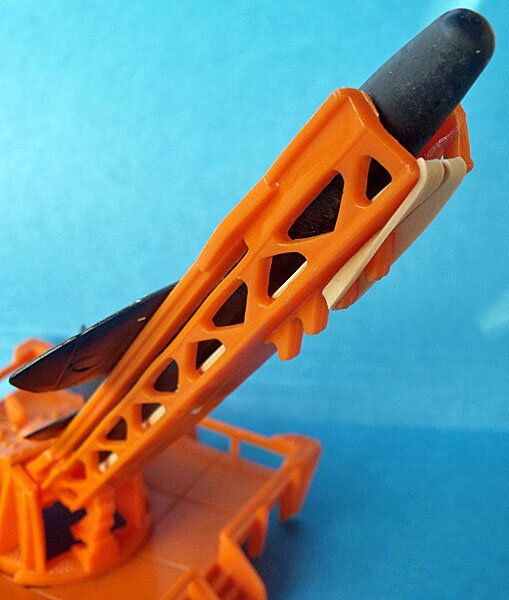 |
|
| Bomarc missile launcher | Launching instructions from playset instruction sheet | Ready to launch with rubber band attached to one of four hooks below the boom (rubber band is not original) |

| Playmats |
Two different playmats can be found in airport sets. The first version, as noted by PFPC, looks rather like the British flag, with three runways crossed in the middle of the 21-inch-by-34-inch mat. There is a small circle on the mat for the wind direction finder (see the Secondary Accessory Group earlier on this page).
 |
| First version of airport playmat Photo courtesy of collector Brad Farrell |
The second playmat, which came out in late 1961 with the astrojet playset, is noticeably different with only two crossing runways and includes a circular heliport pad. It measures about 41 inches by 27-1/2 inches.
